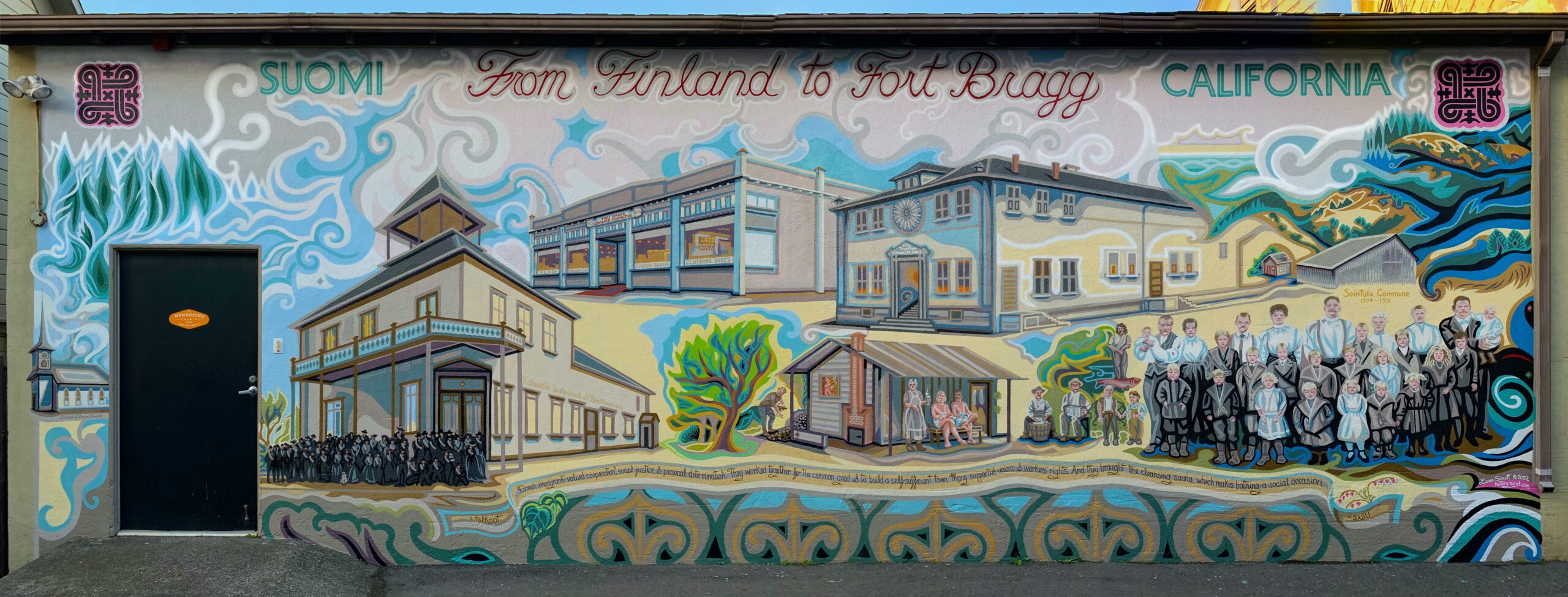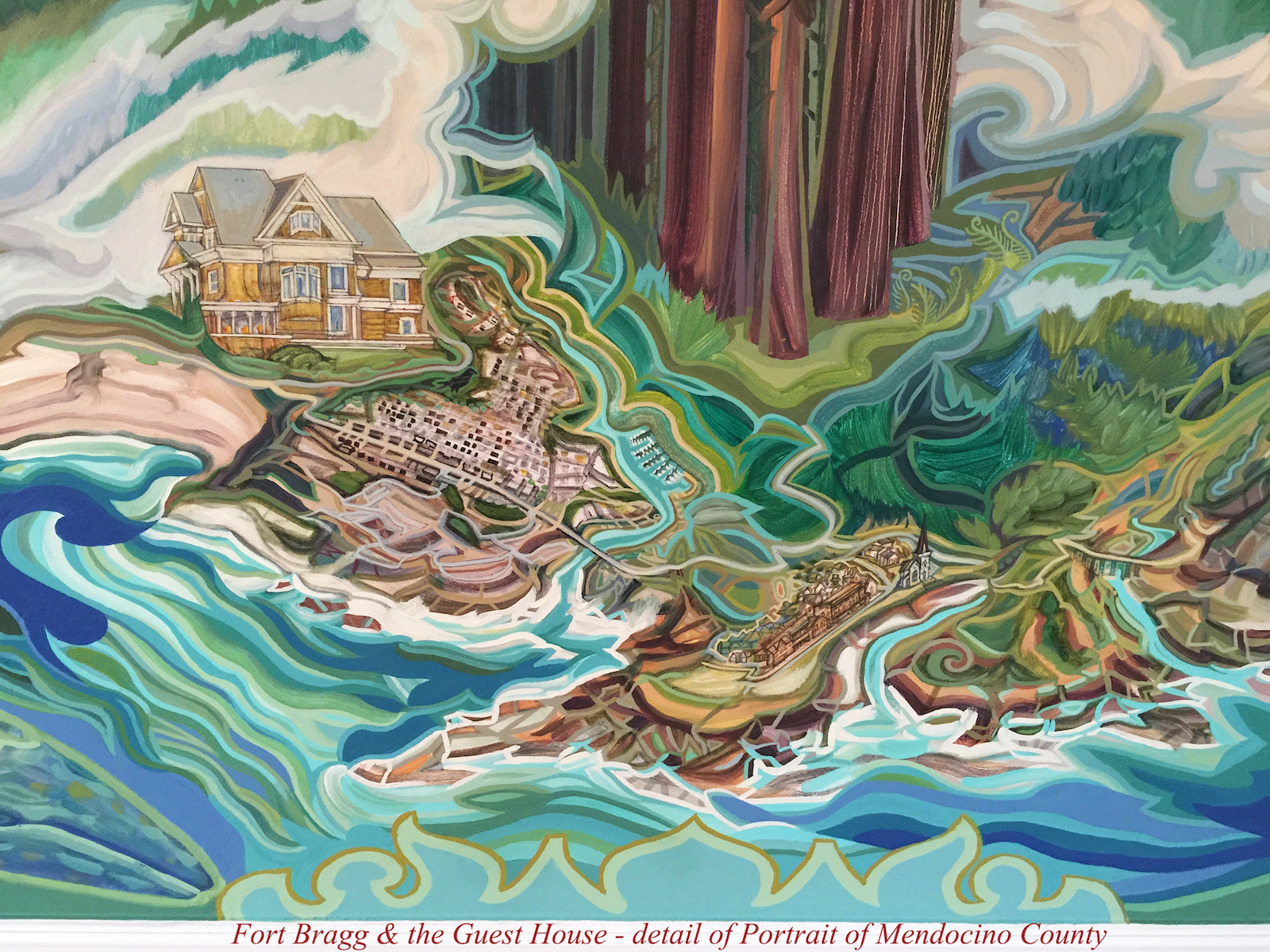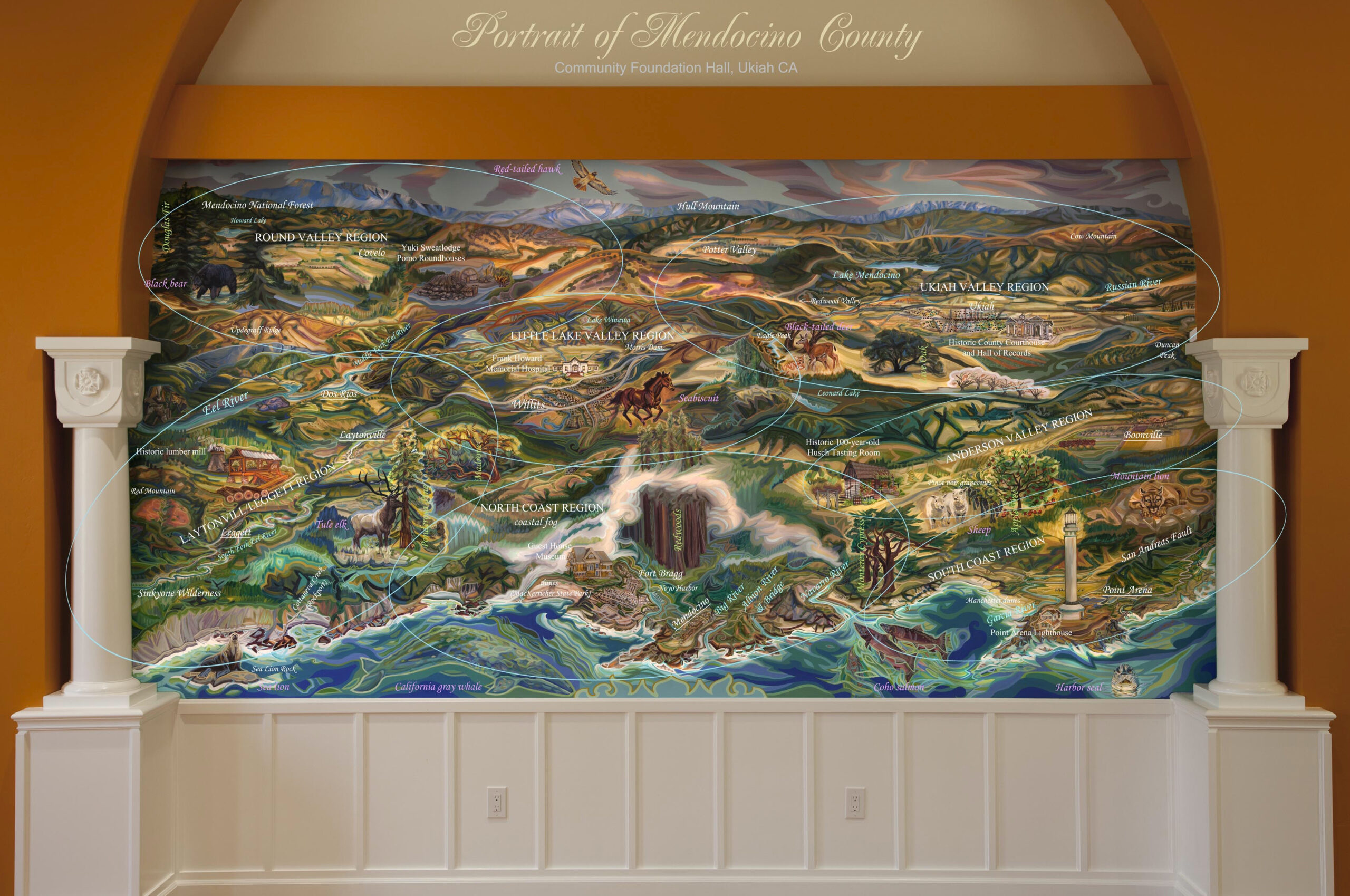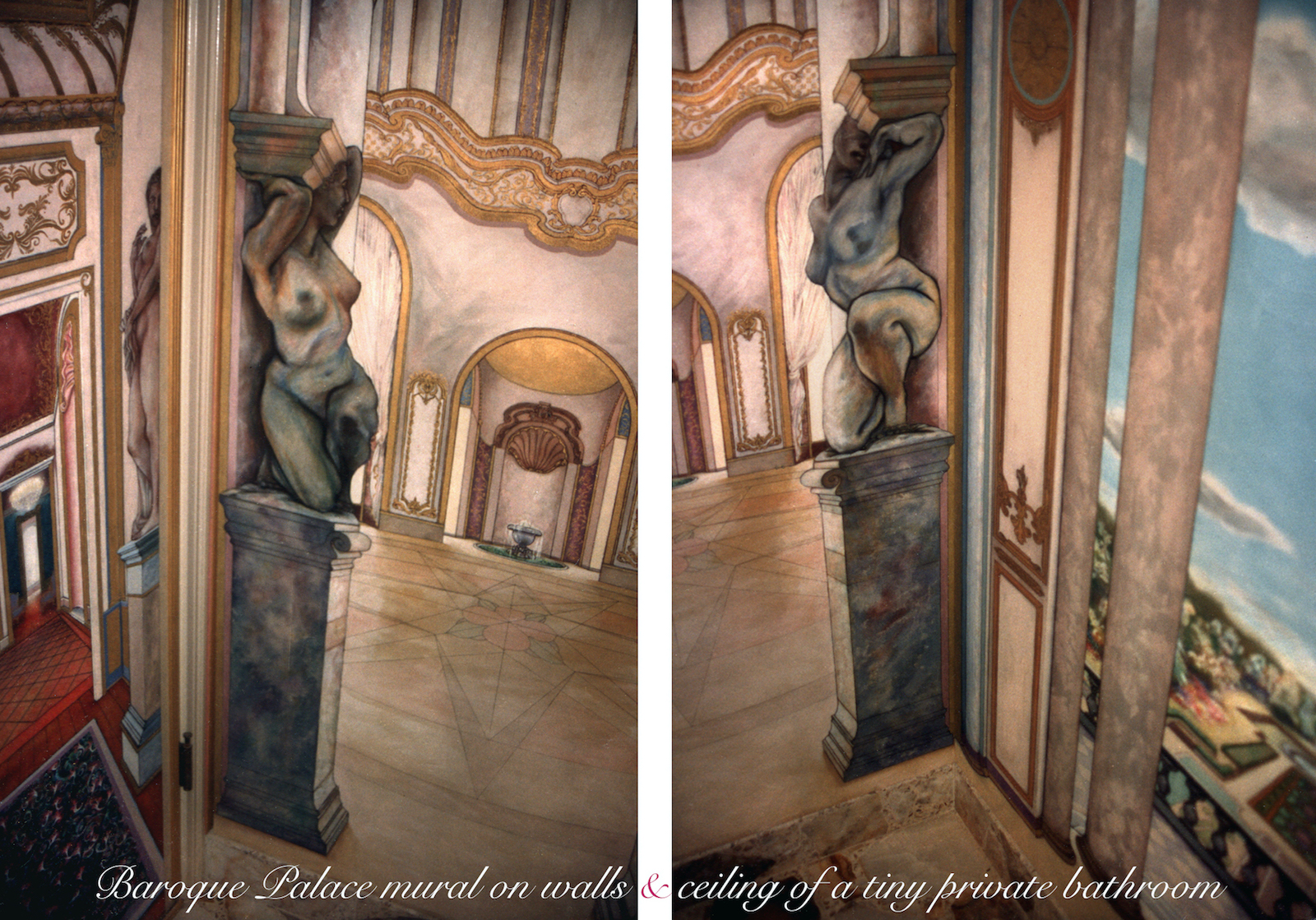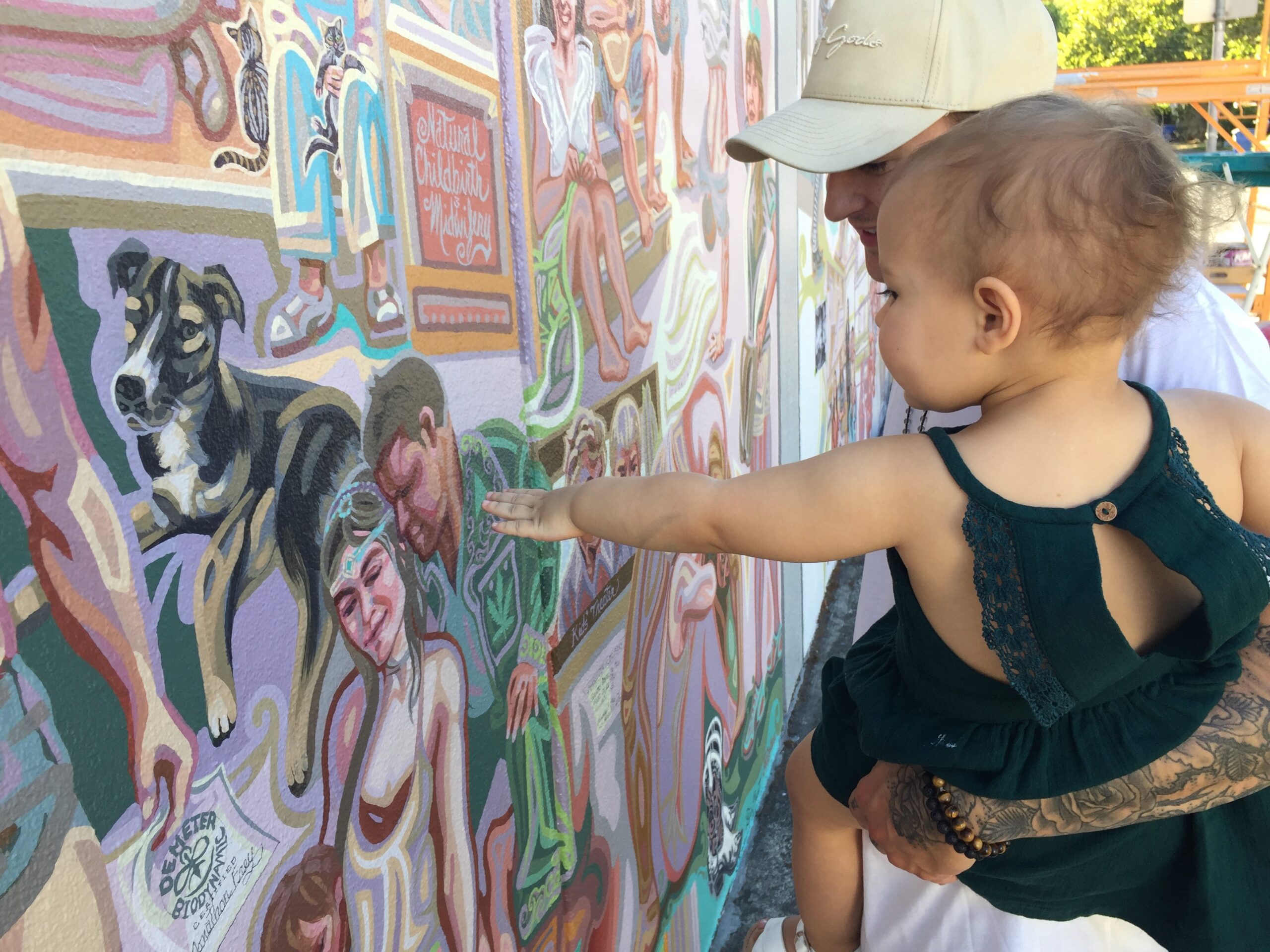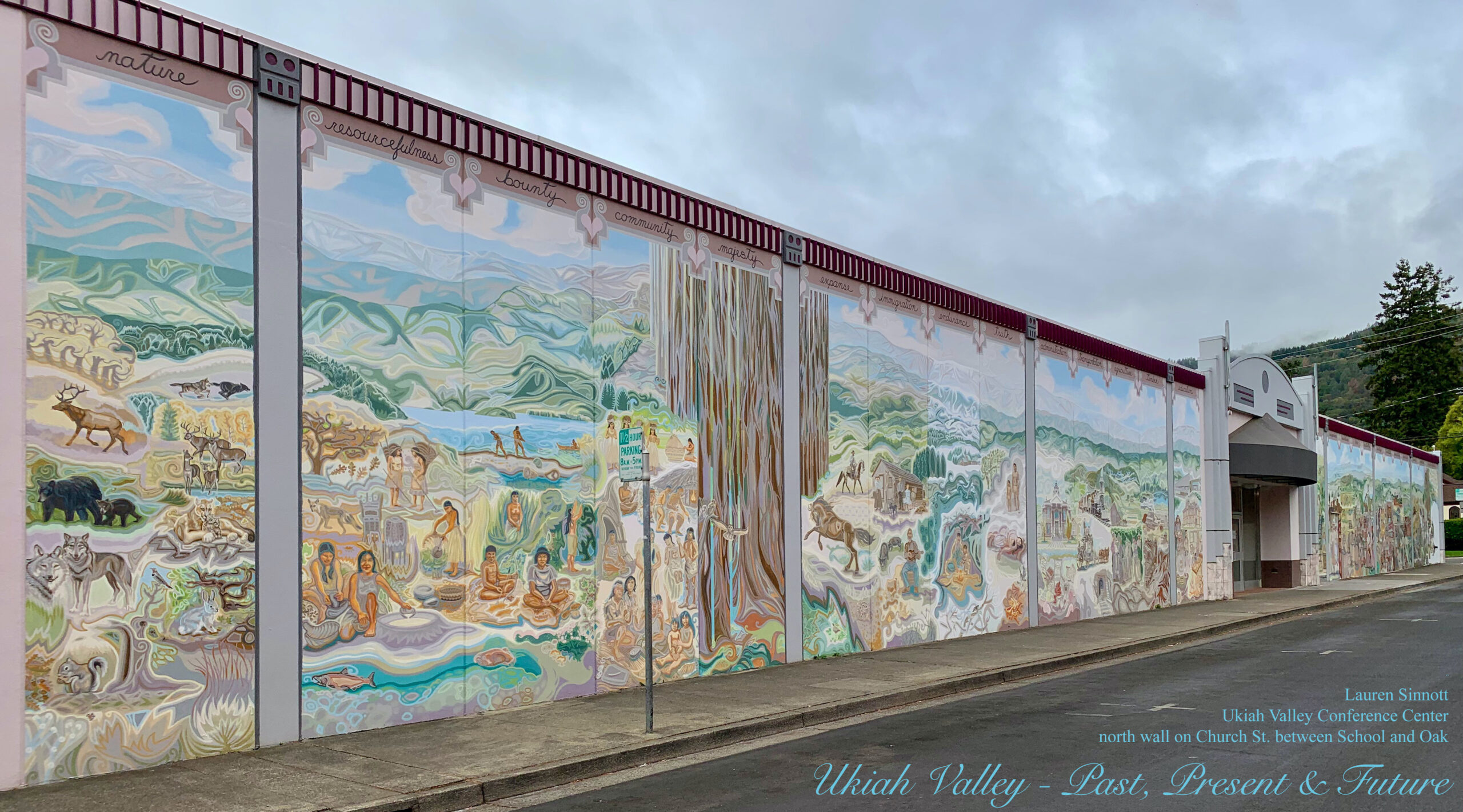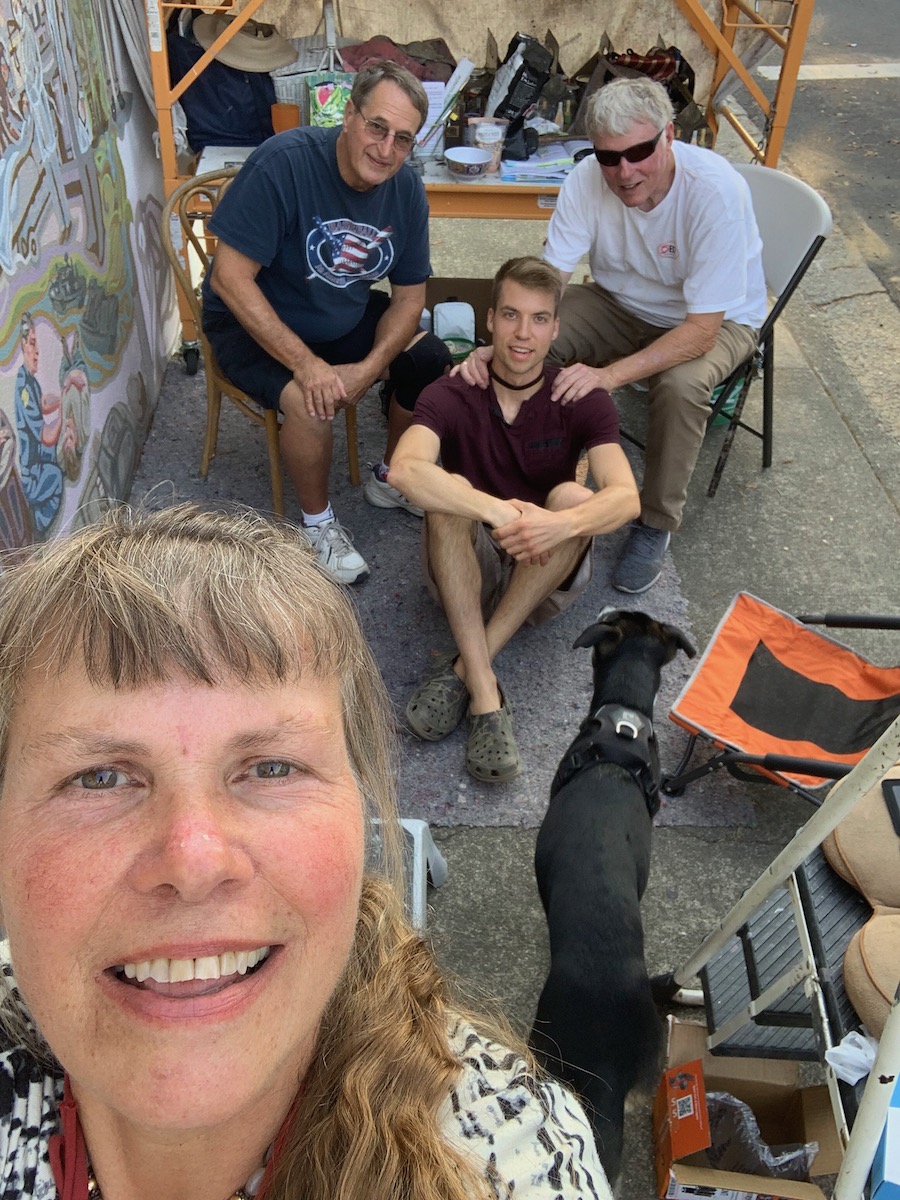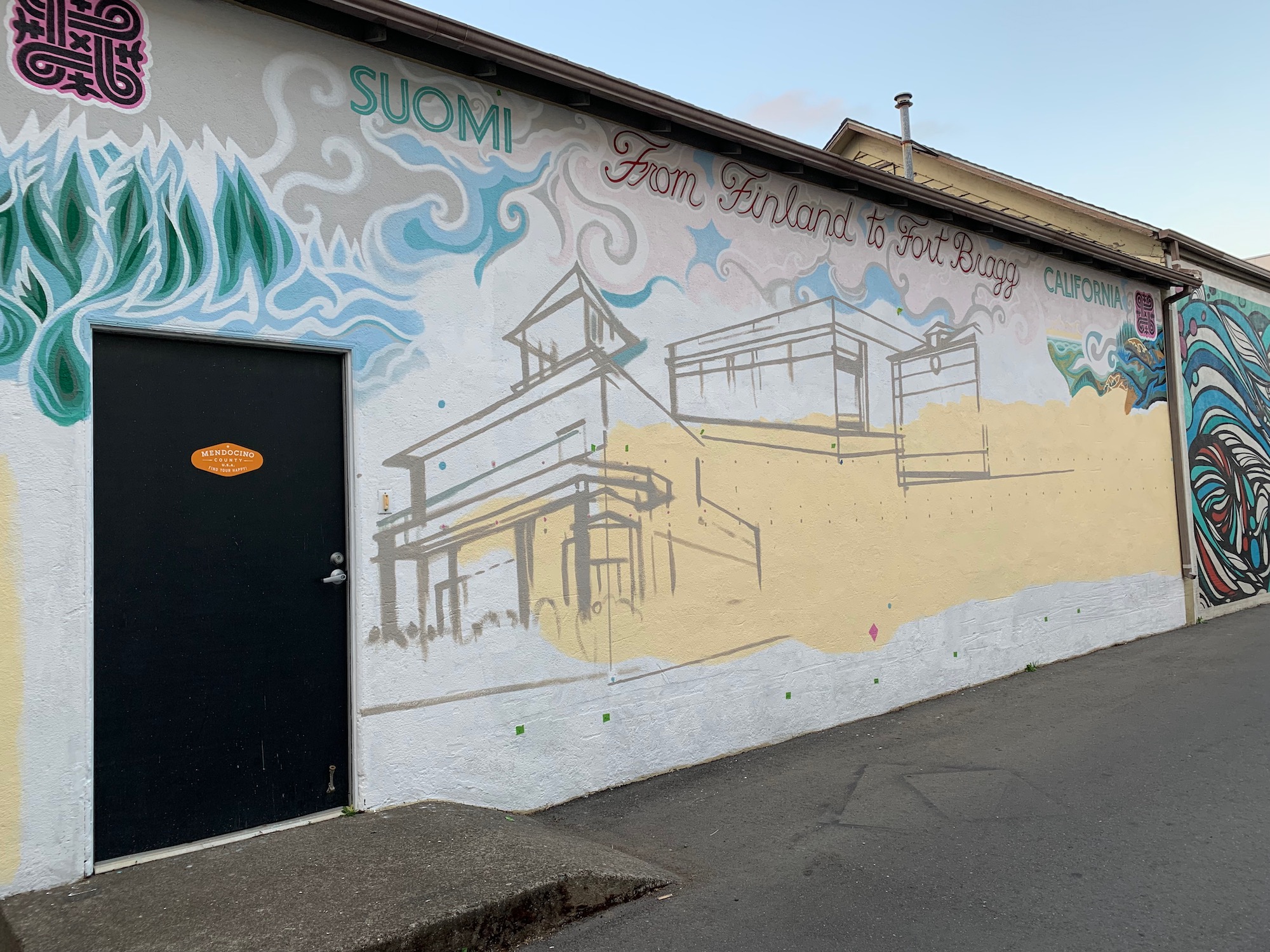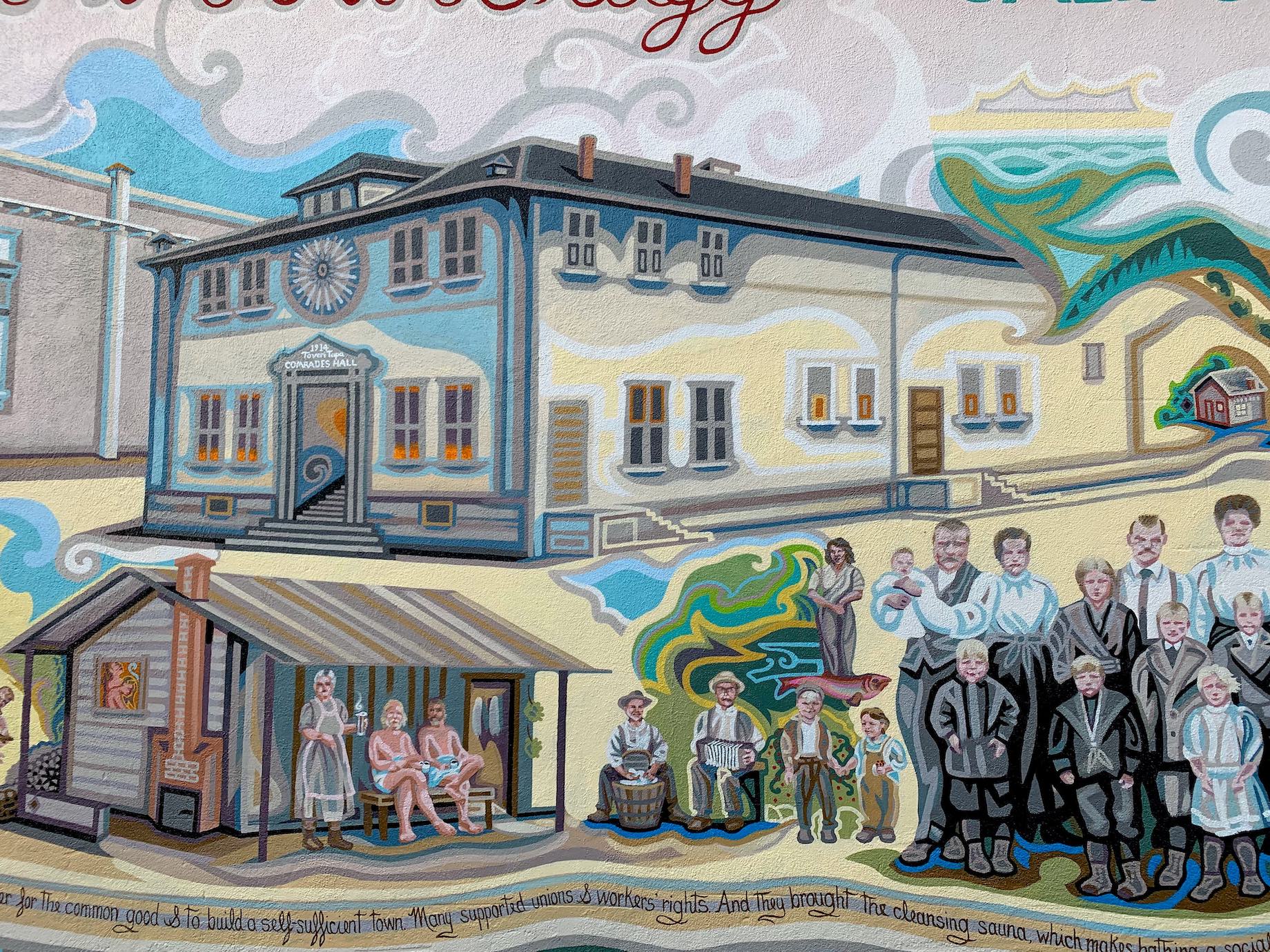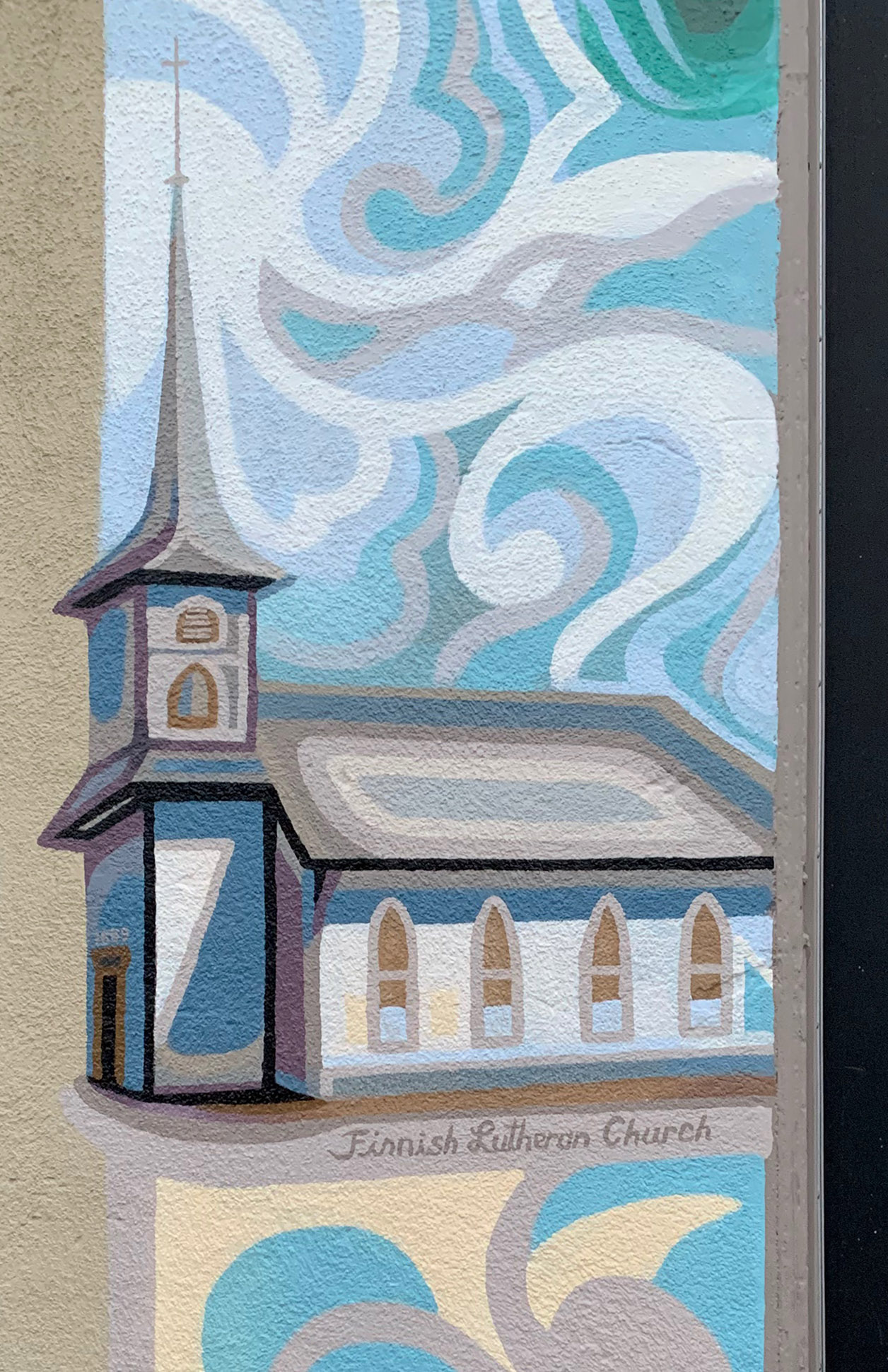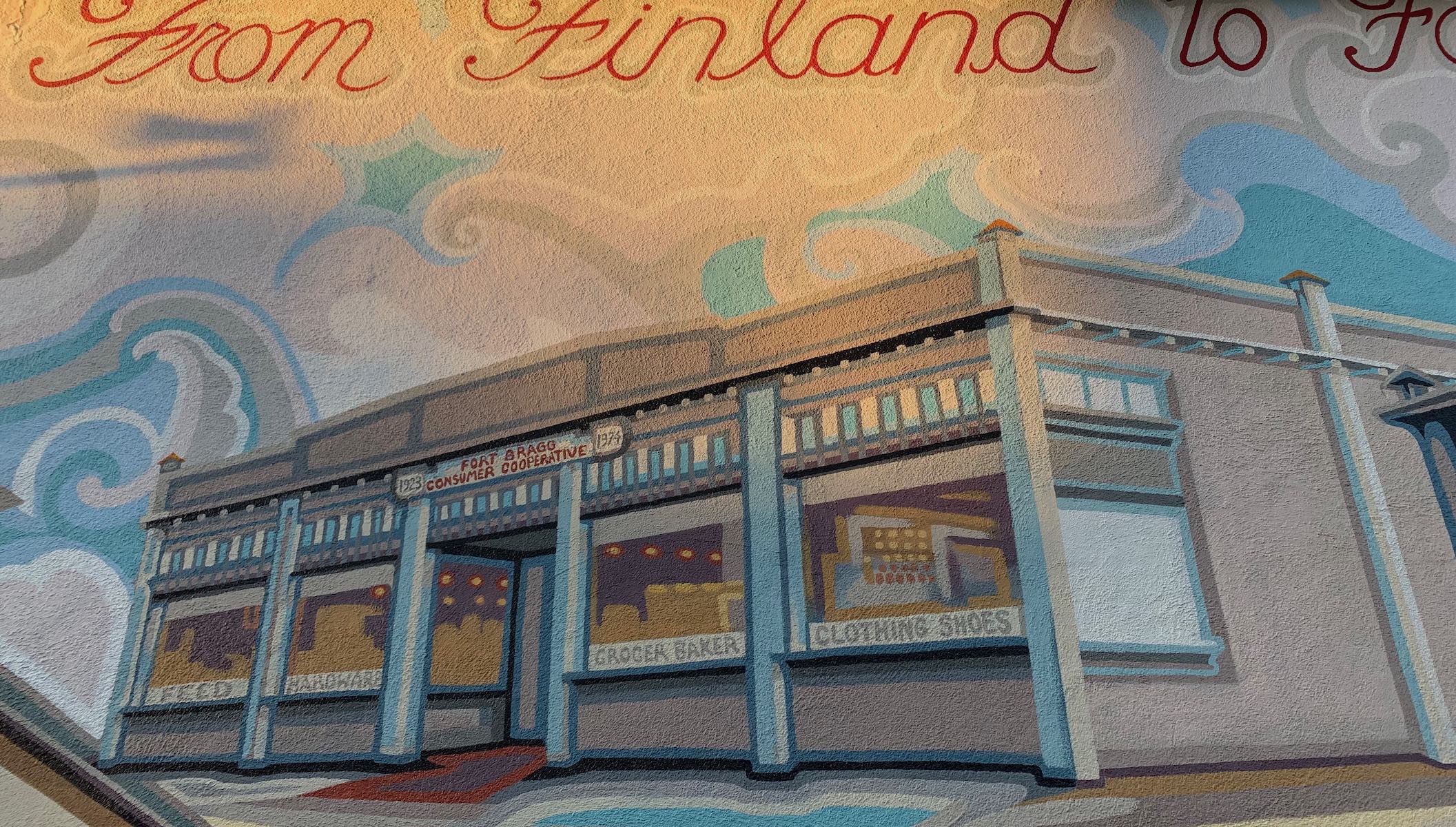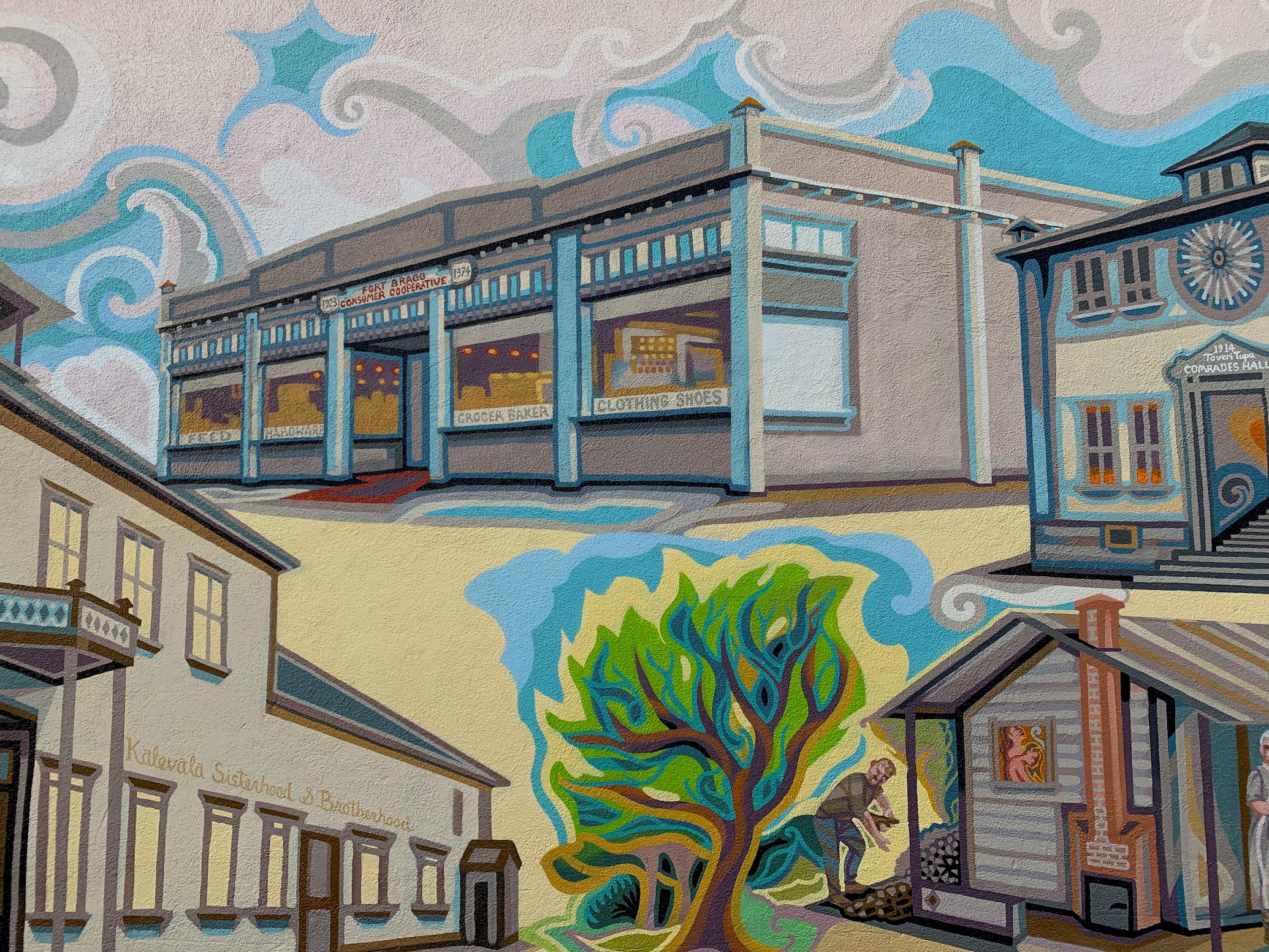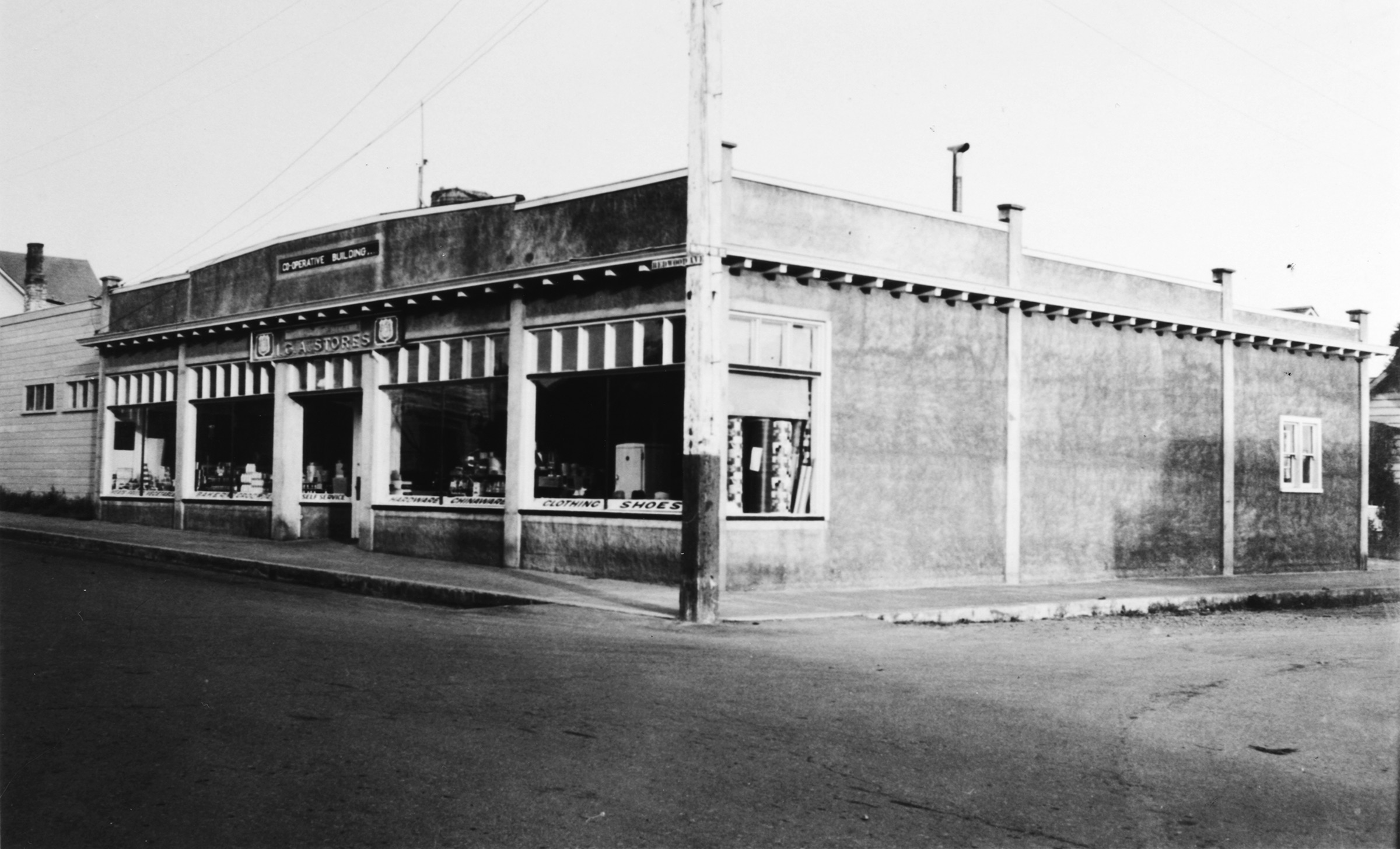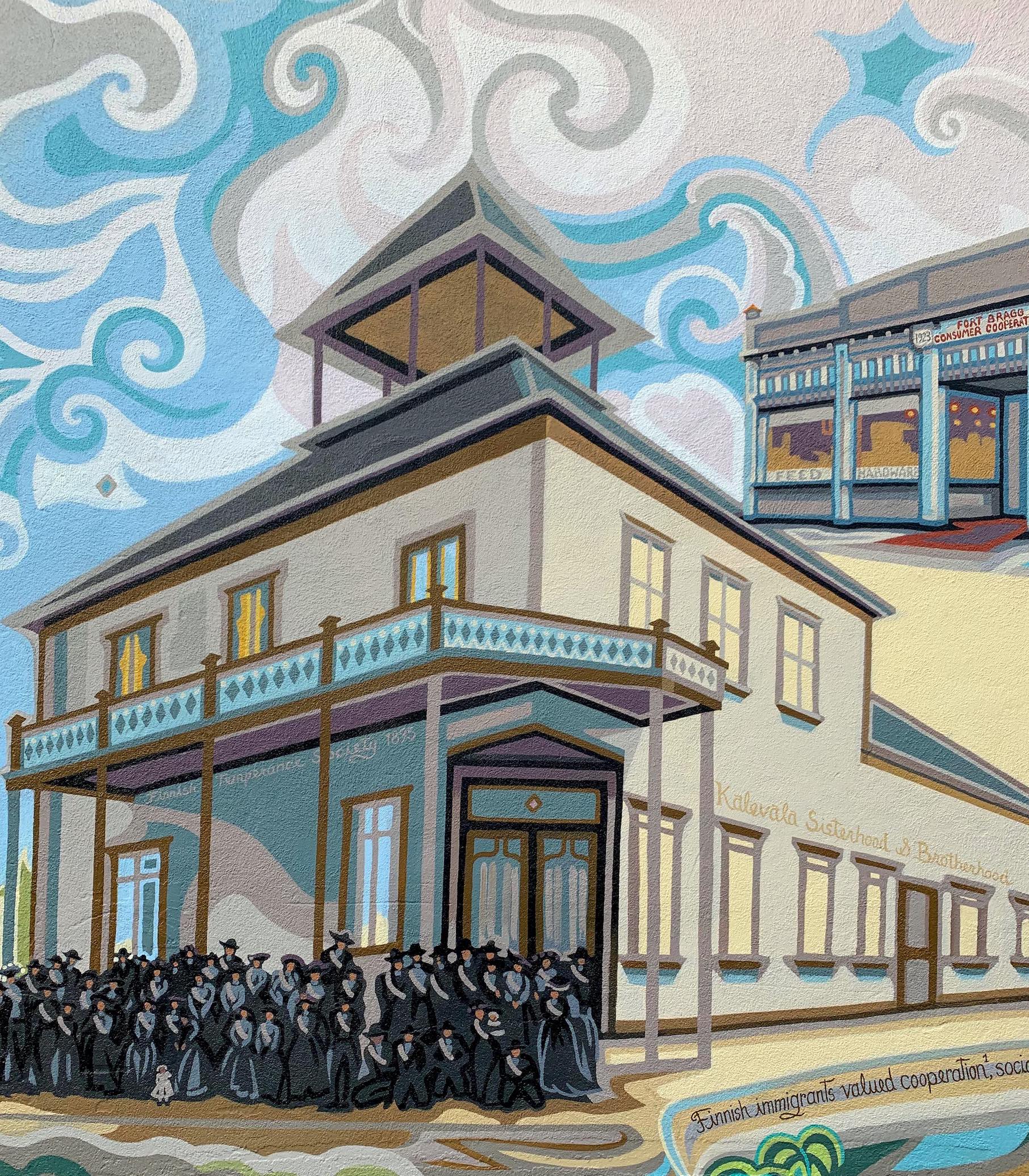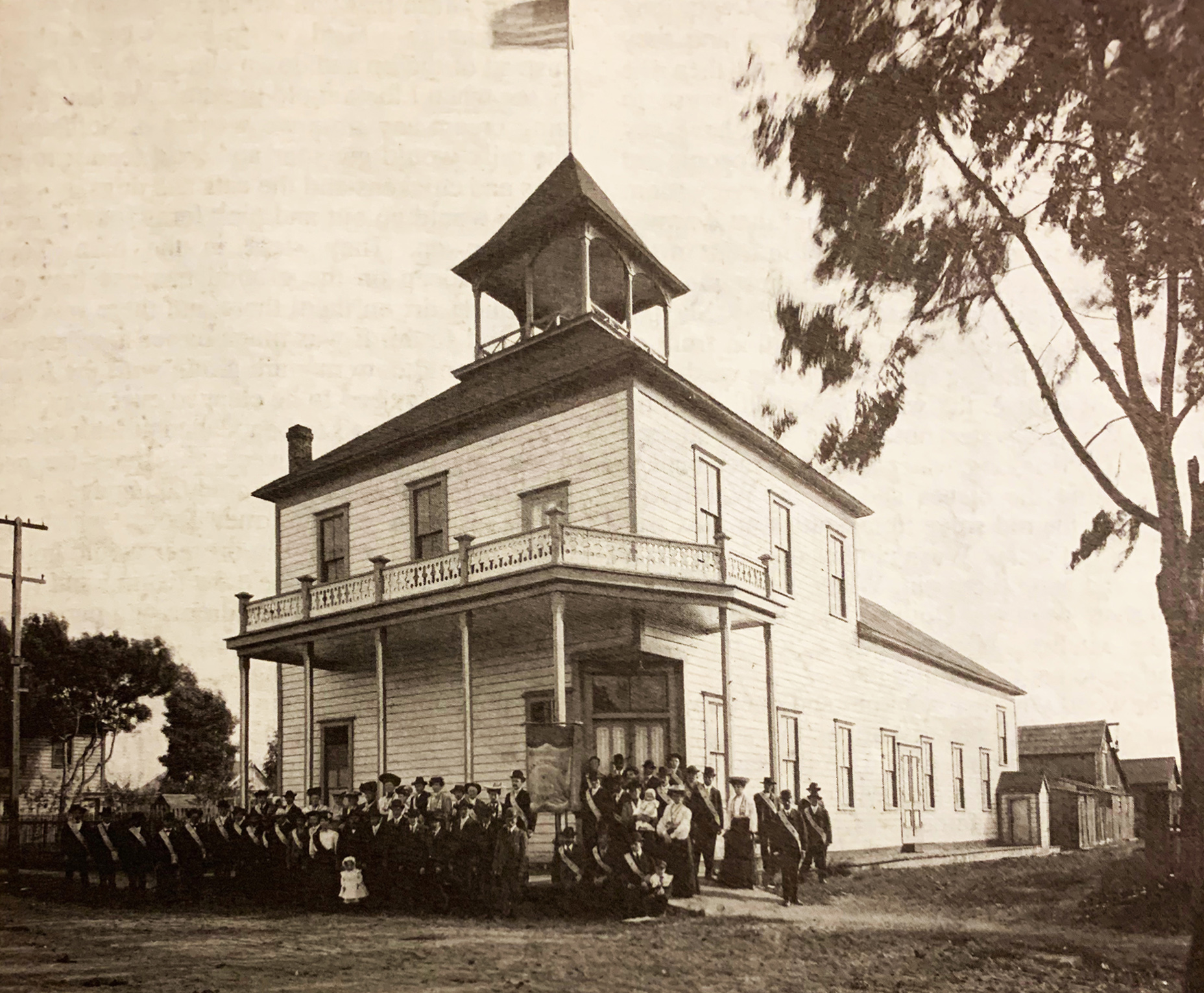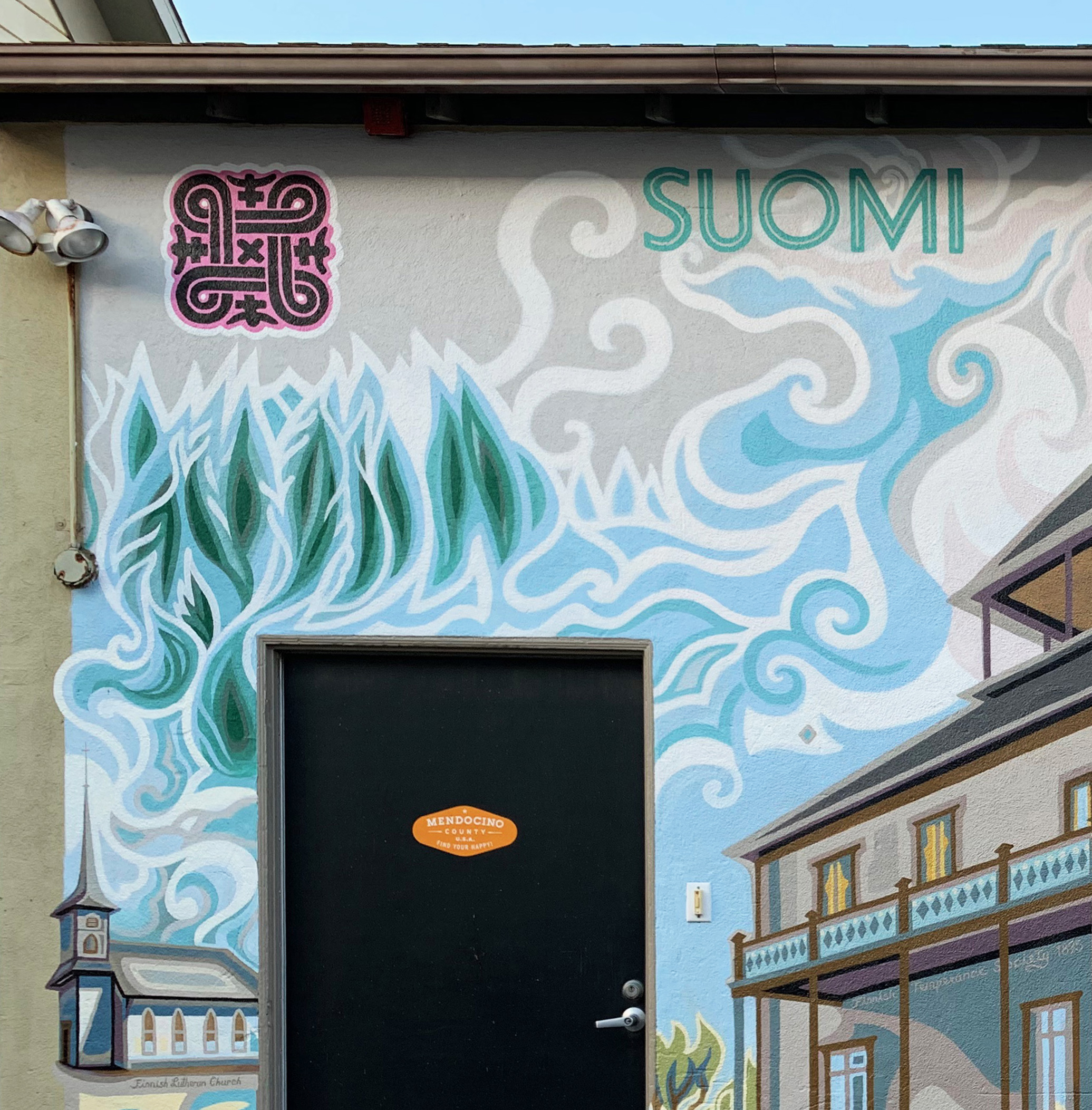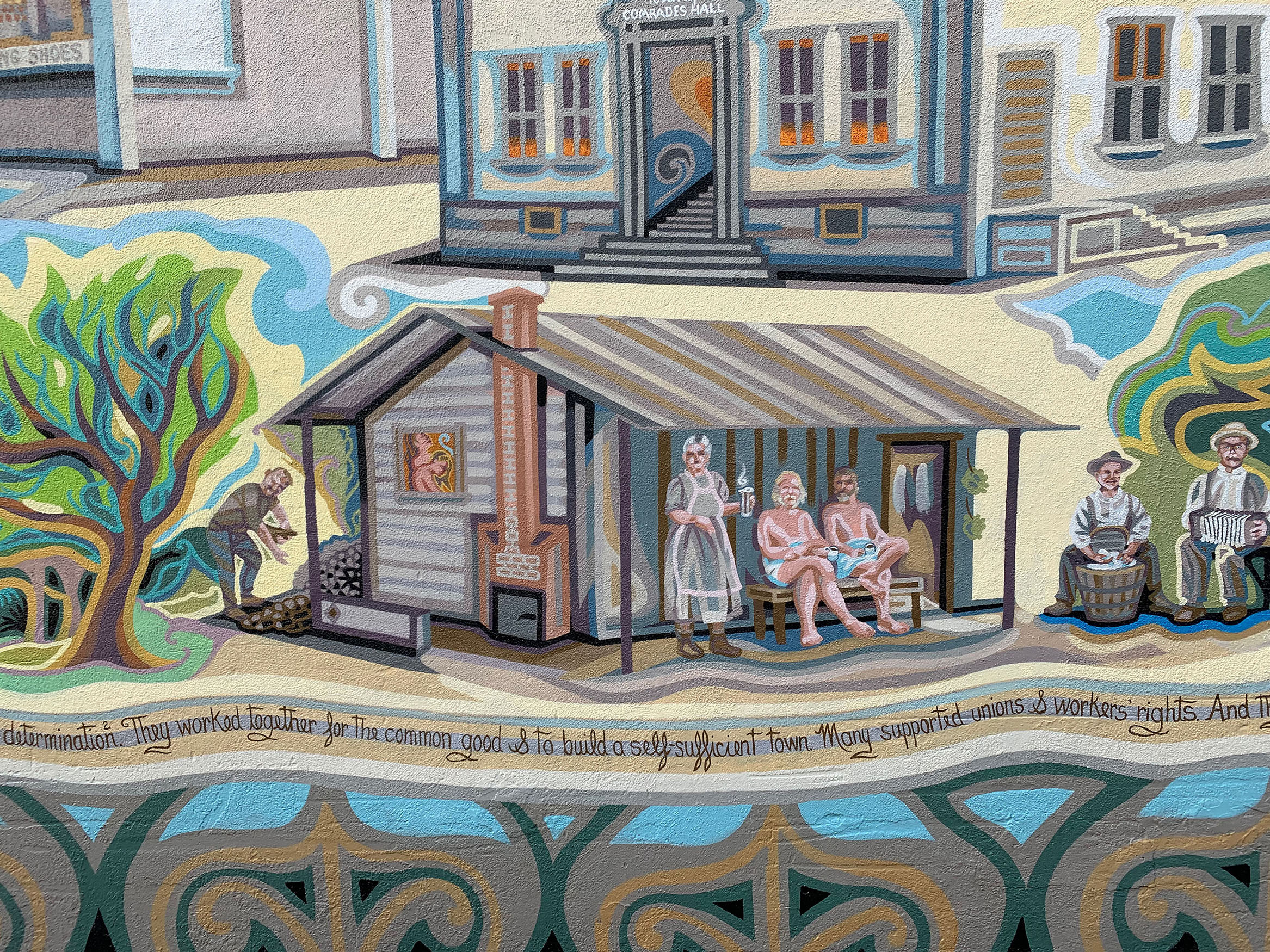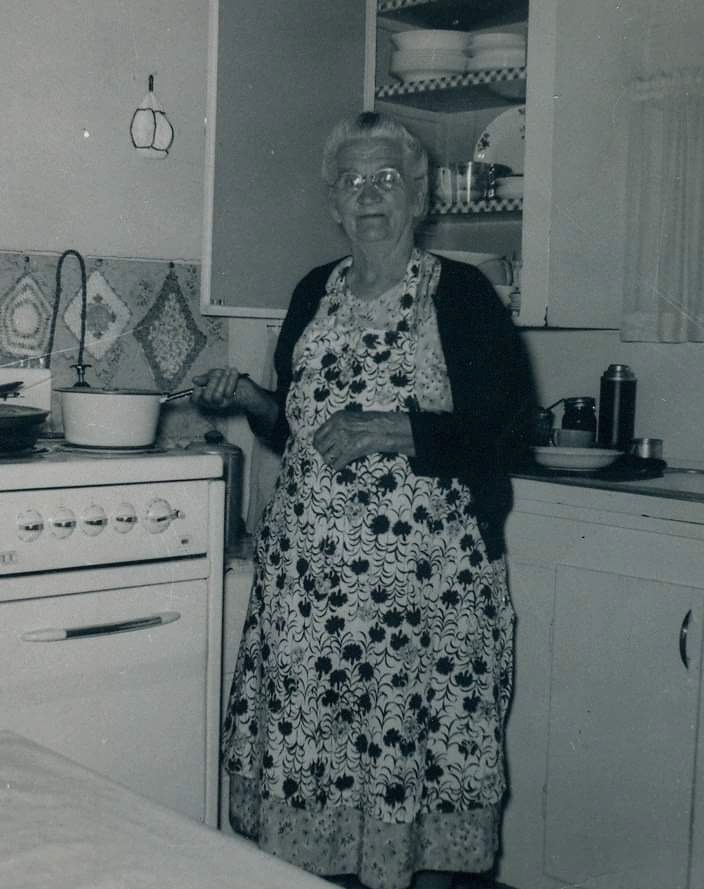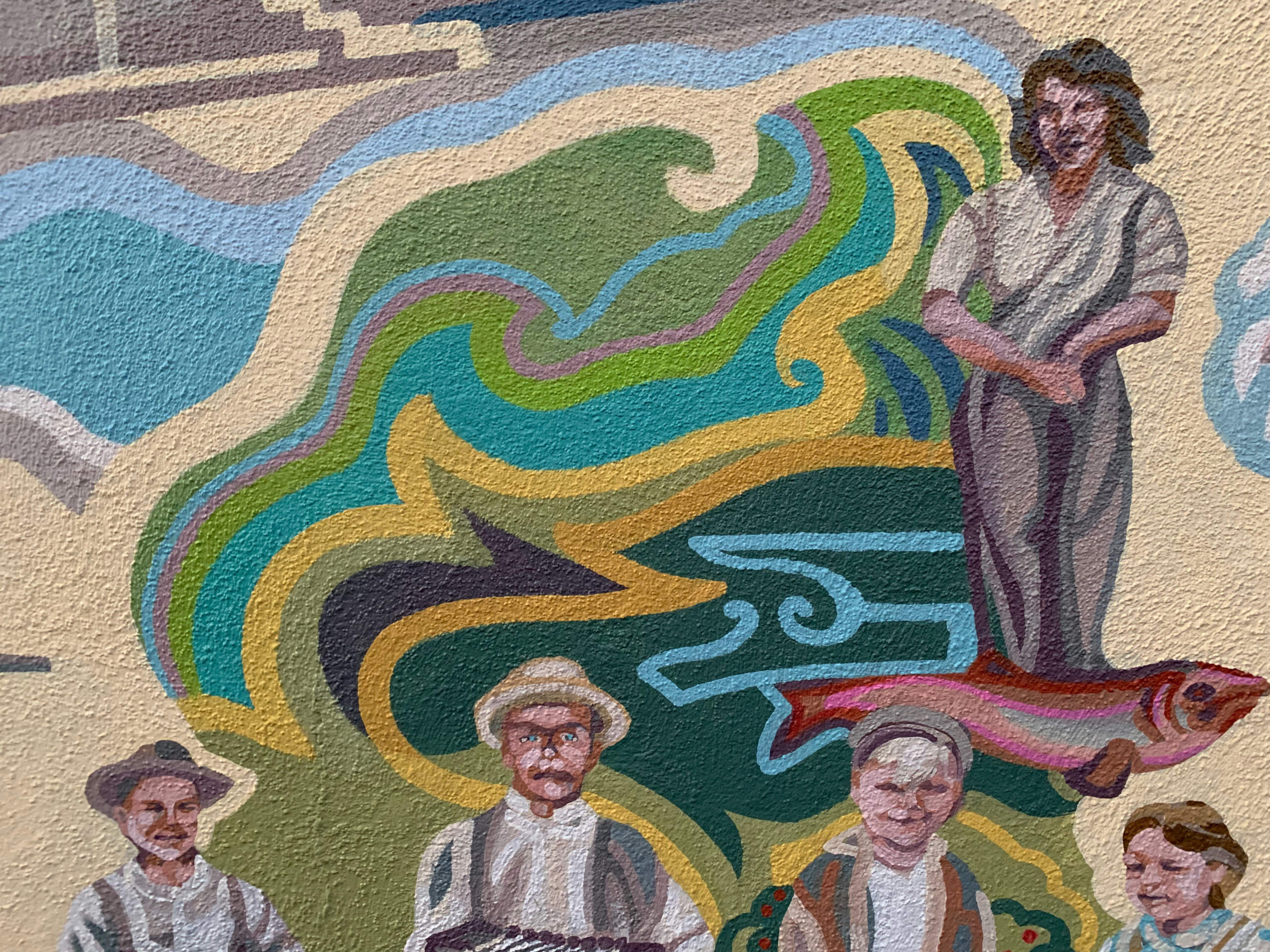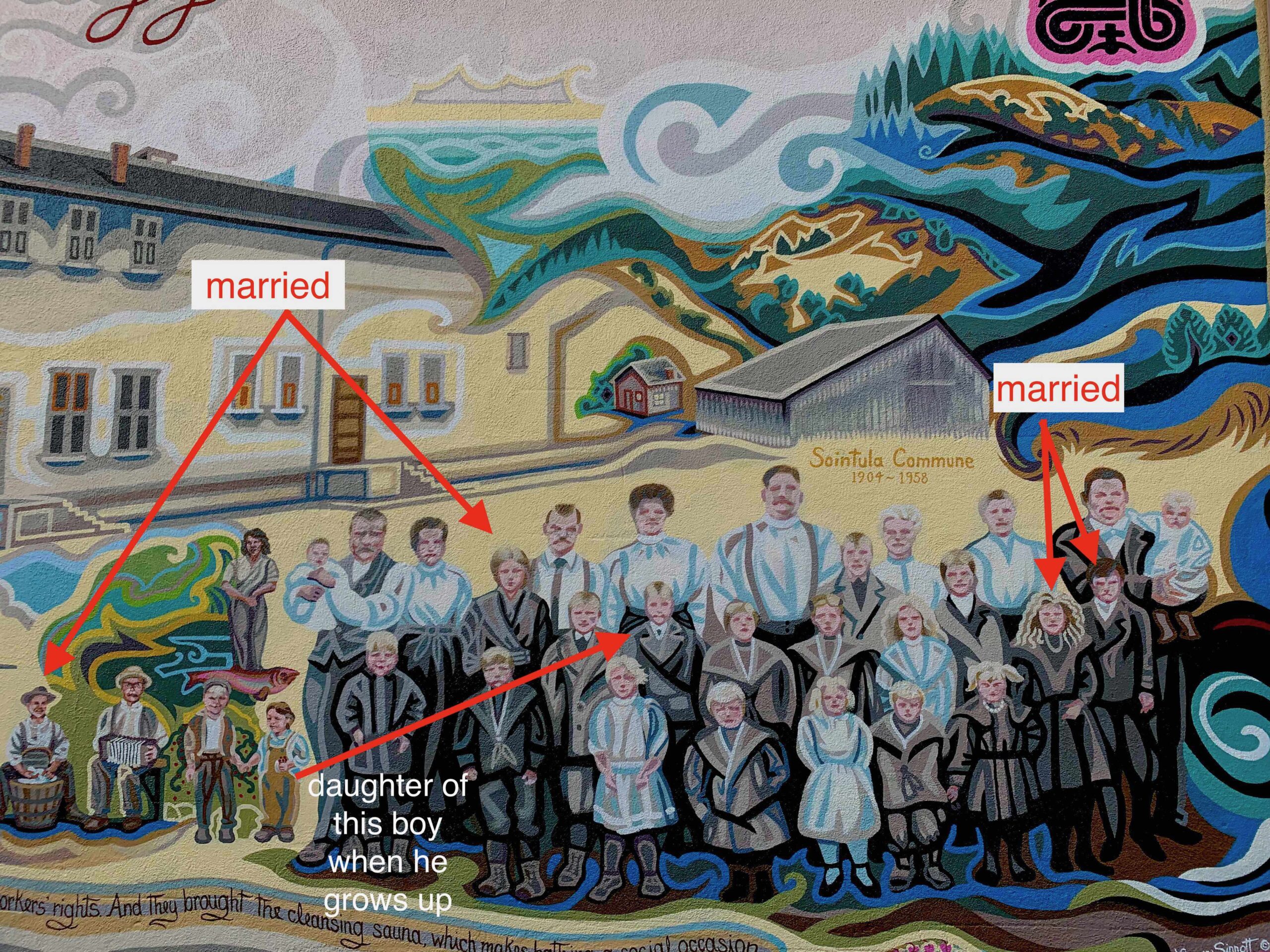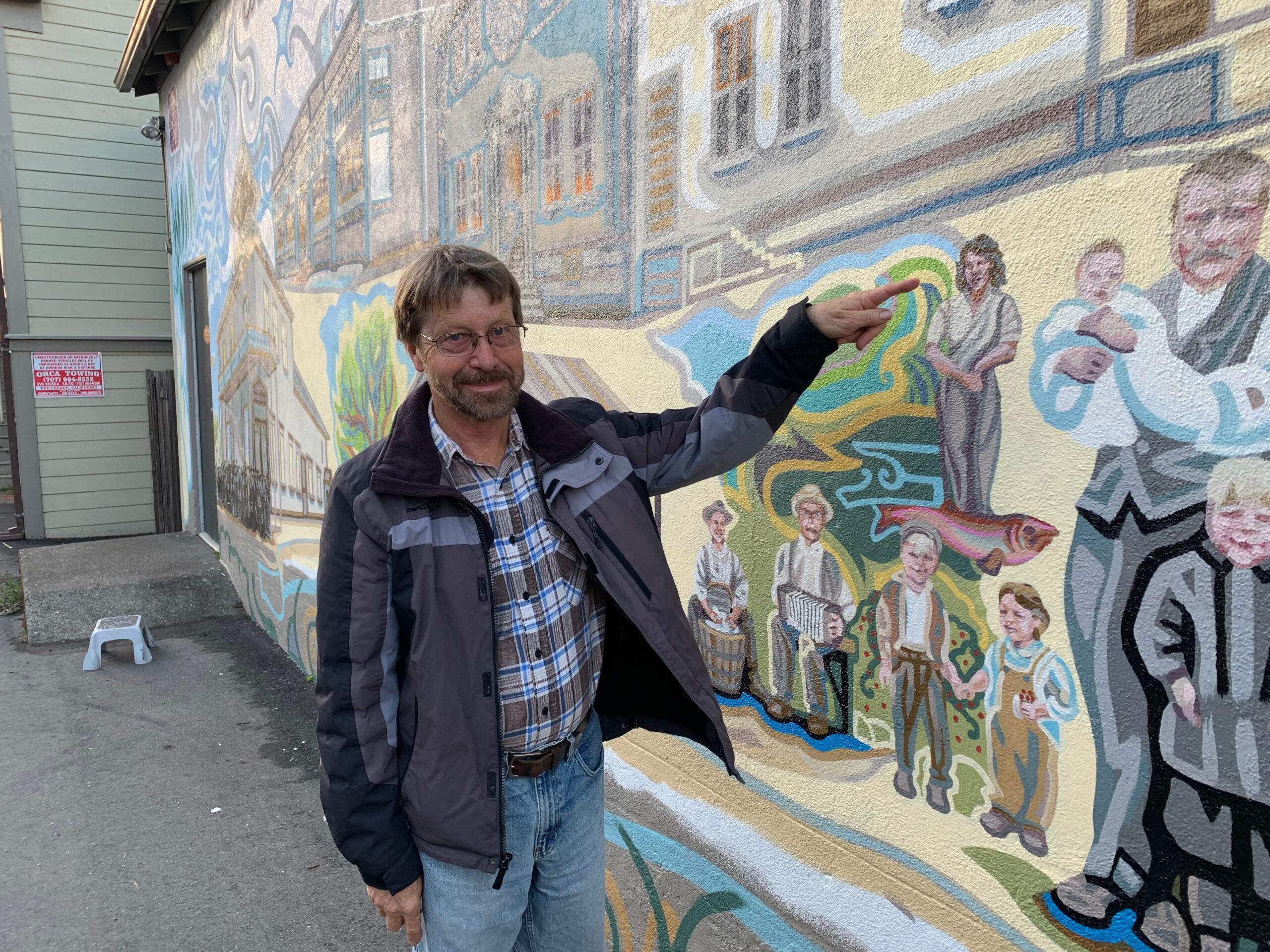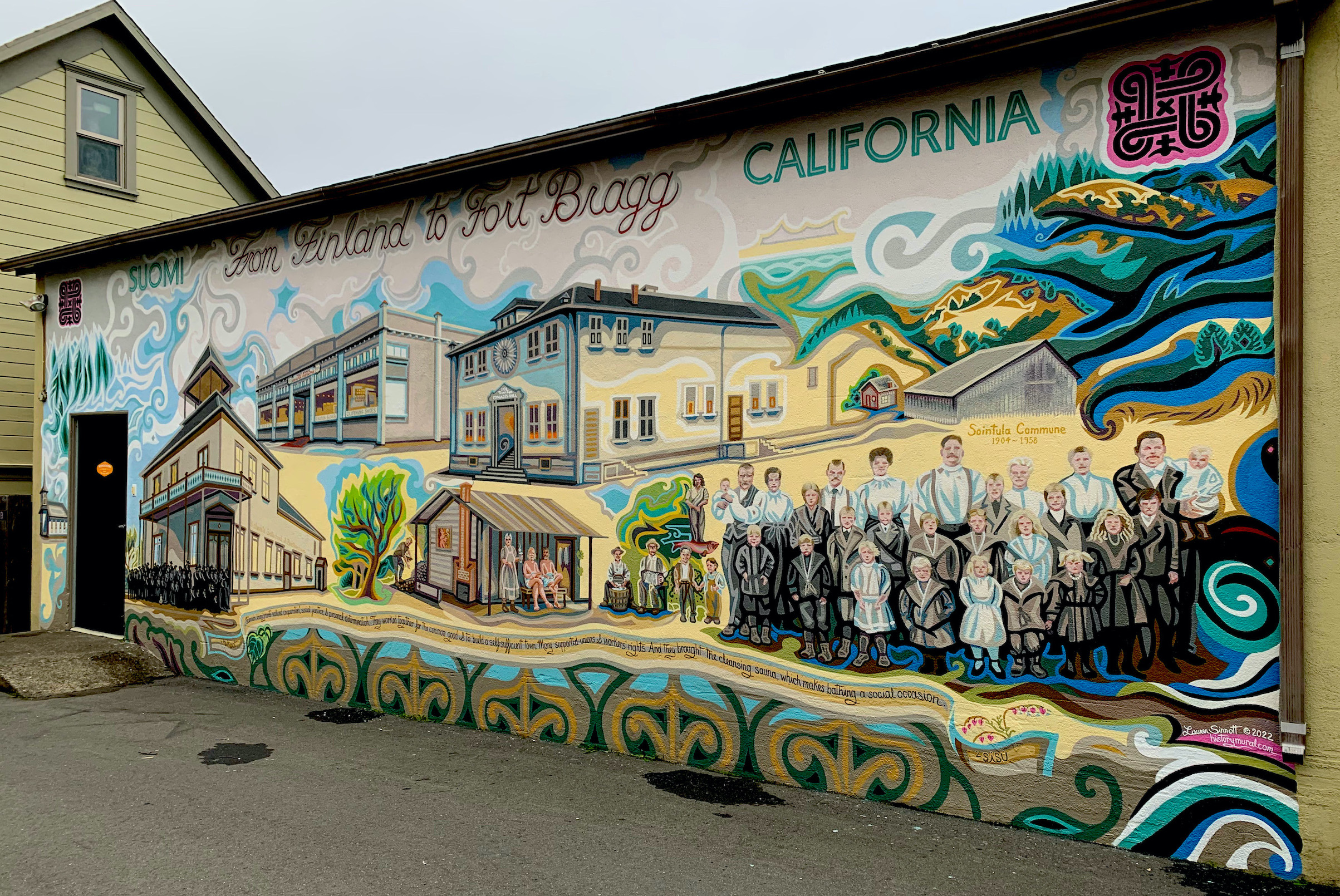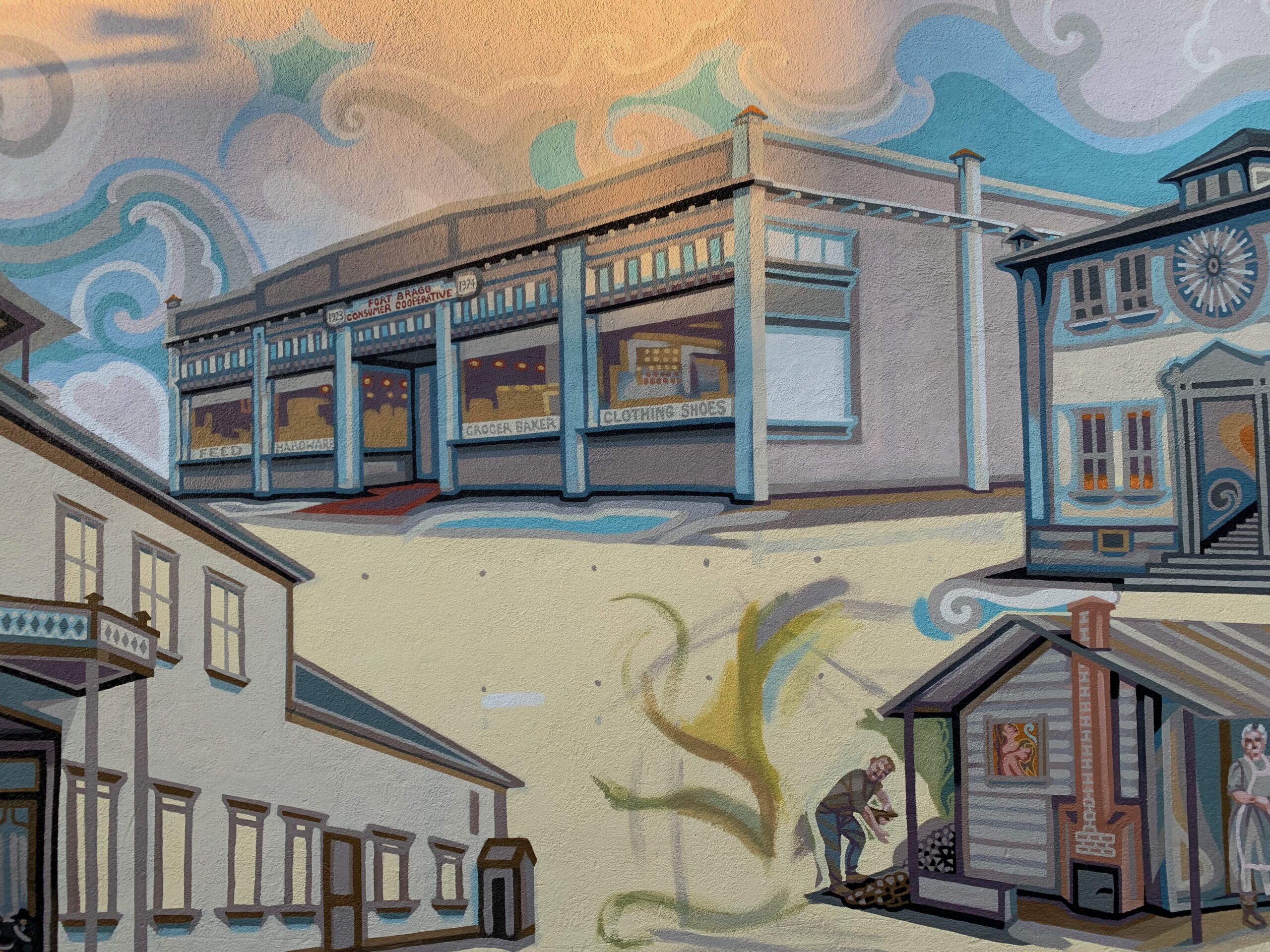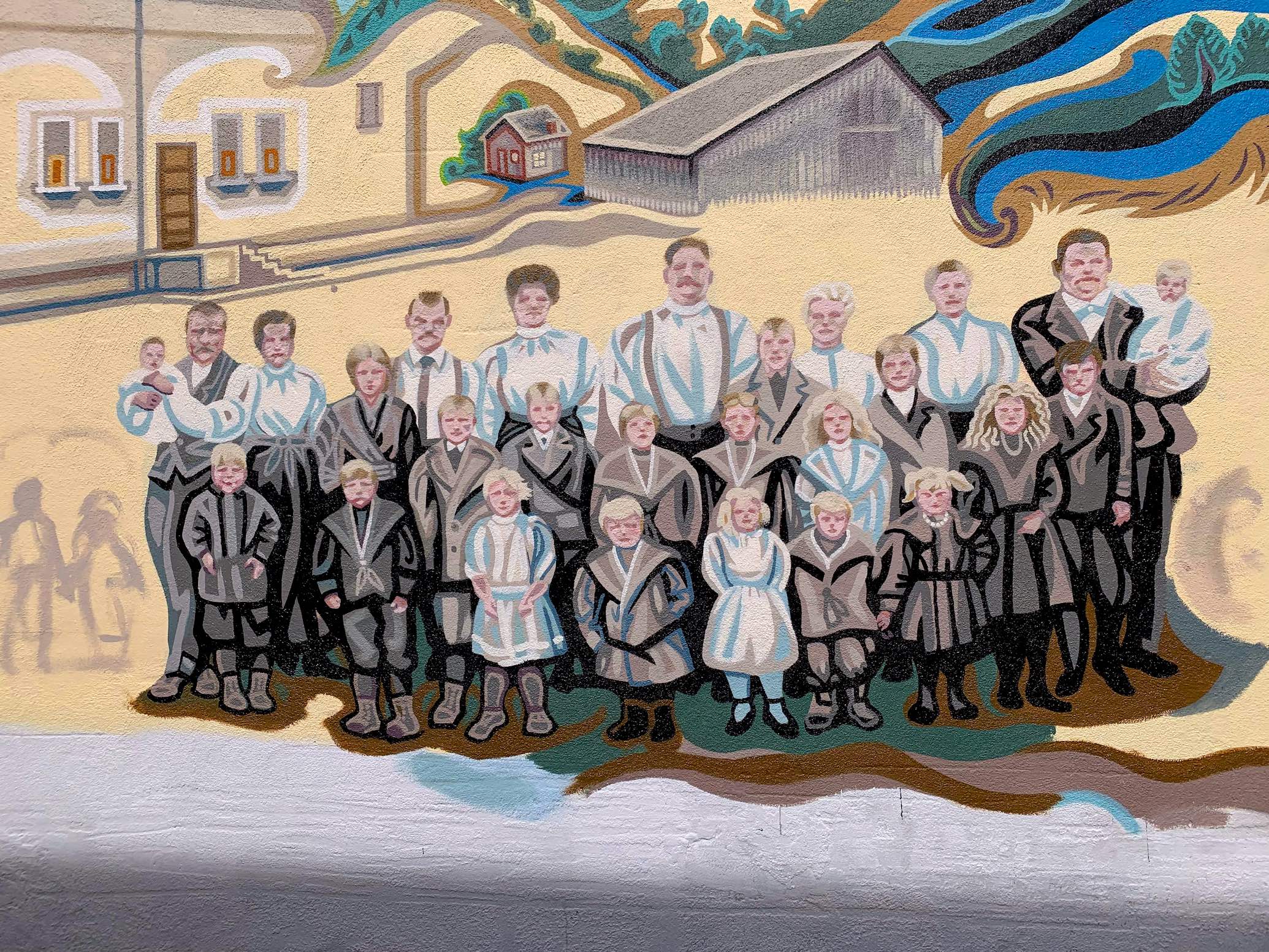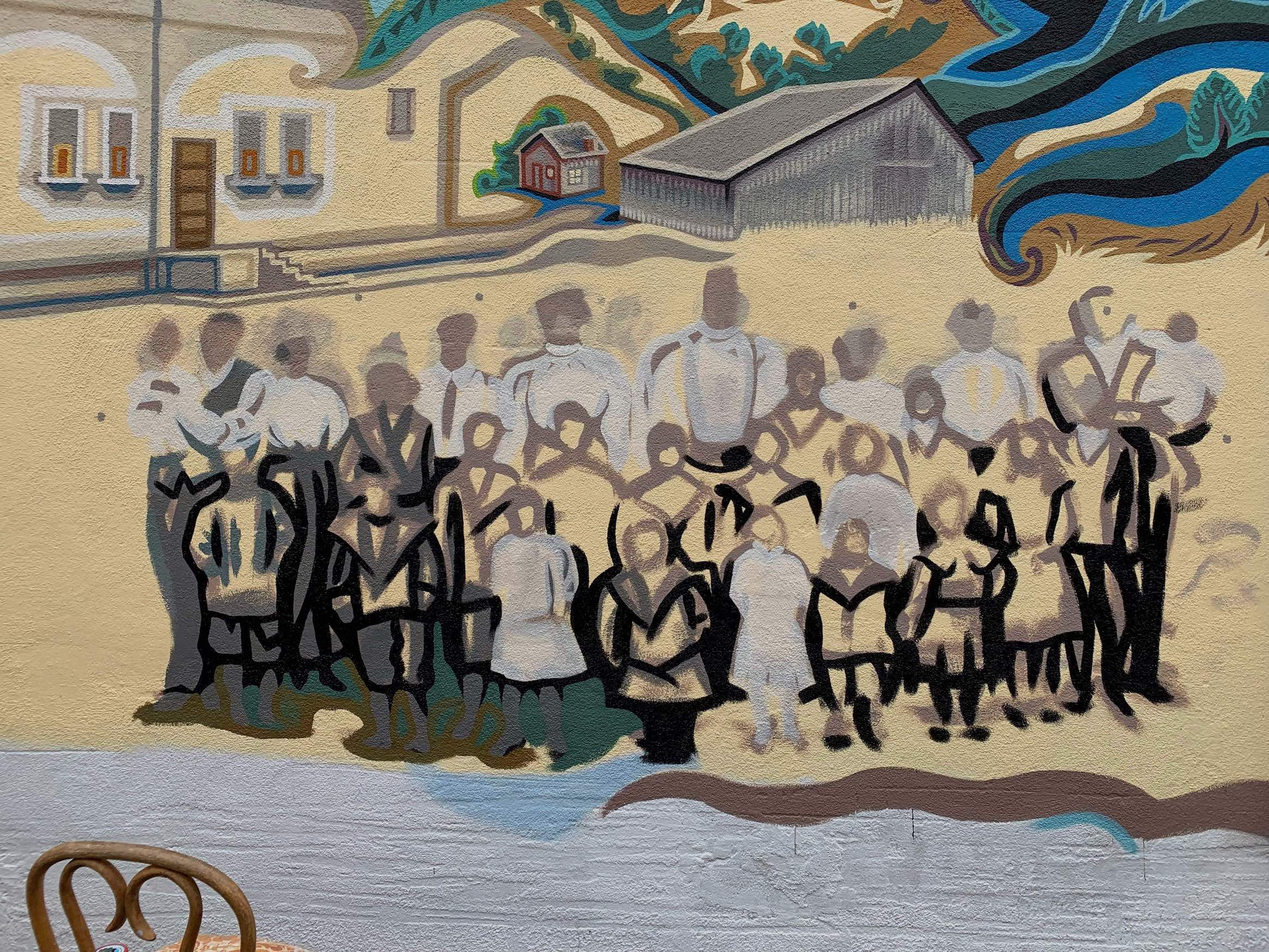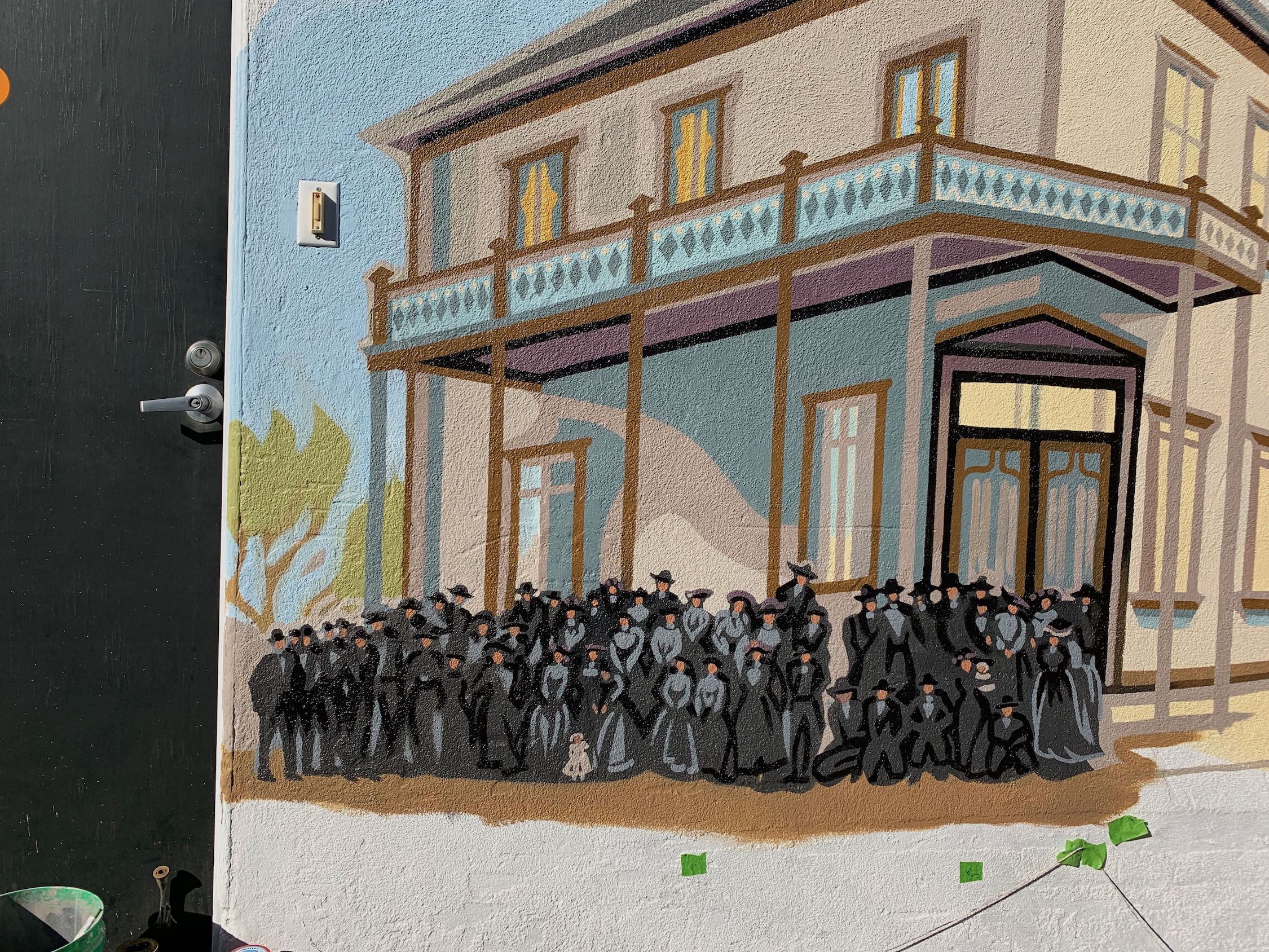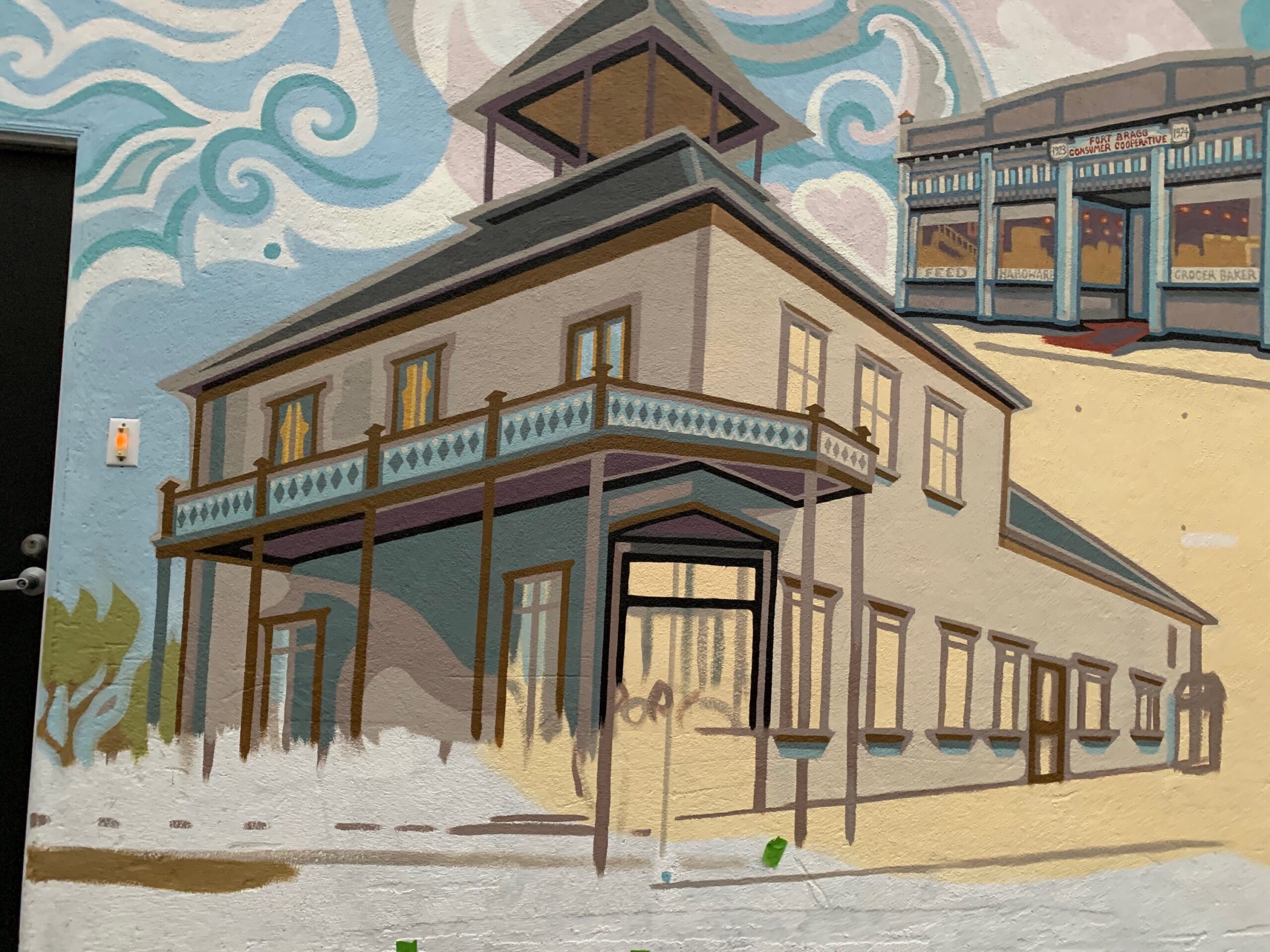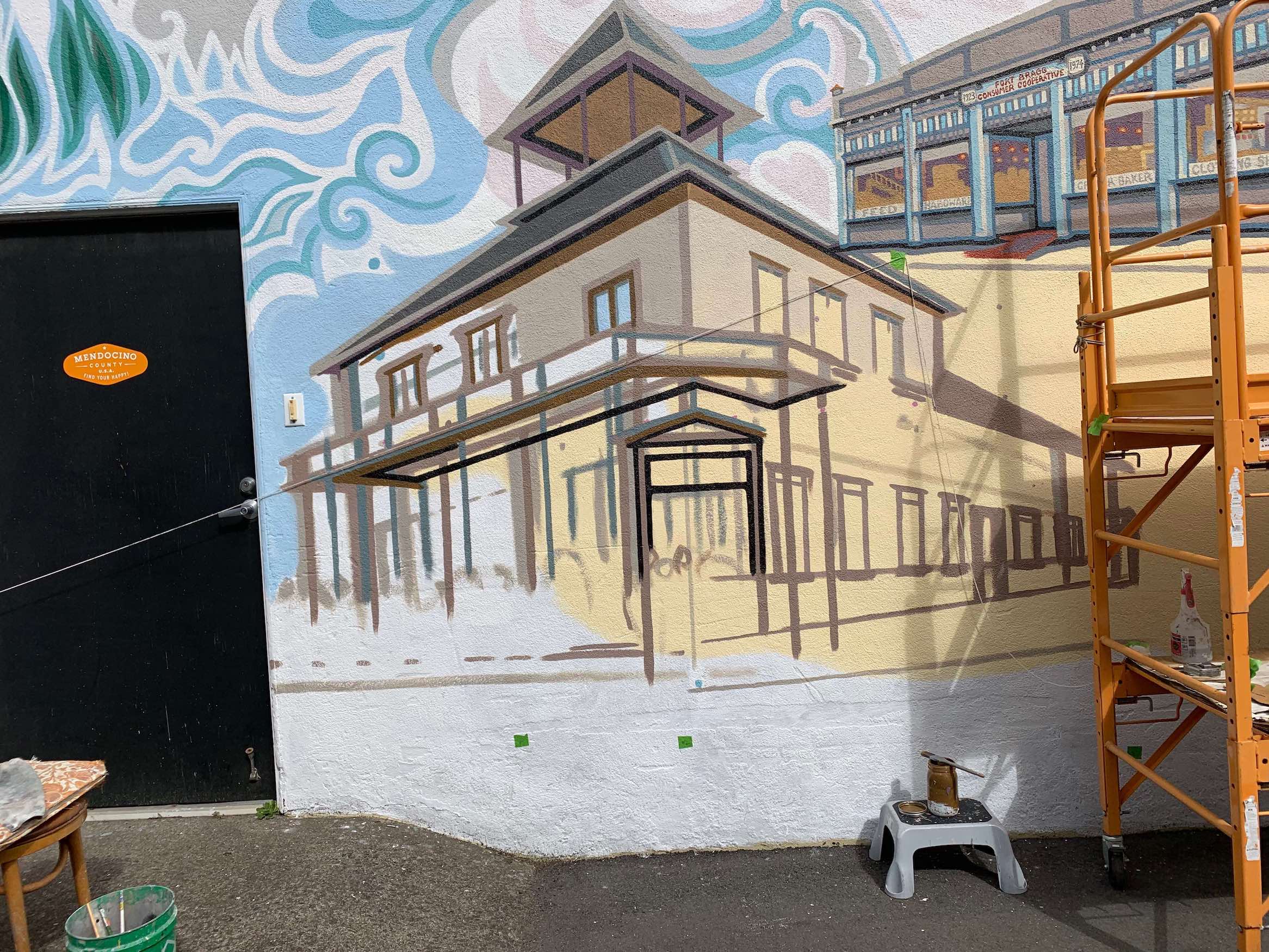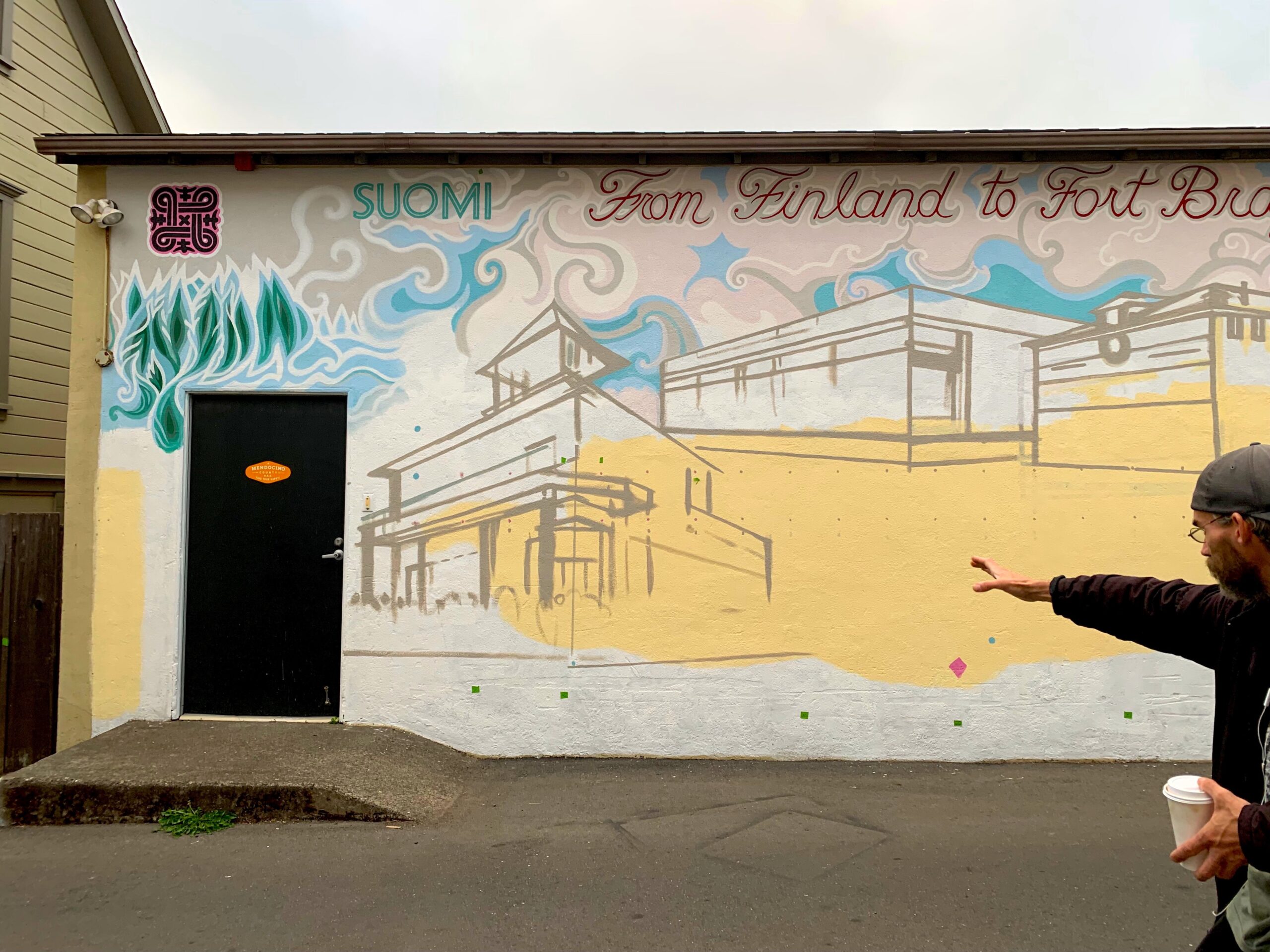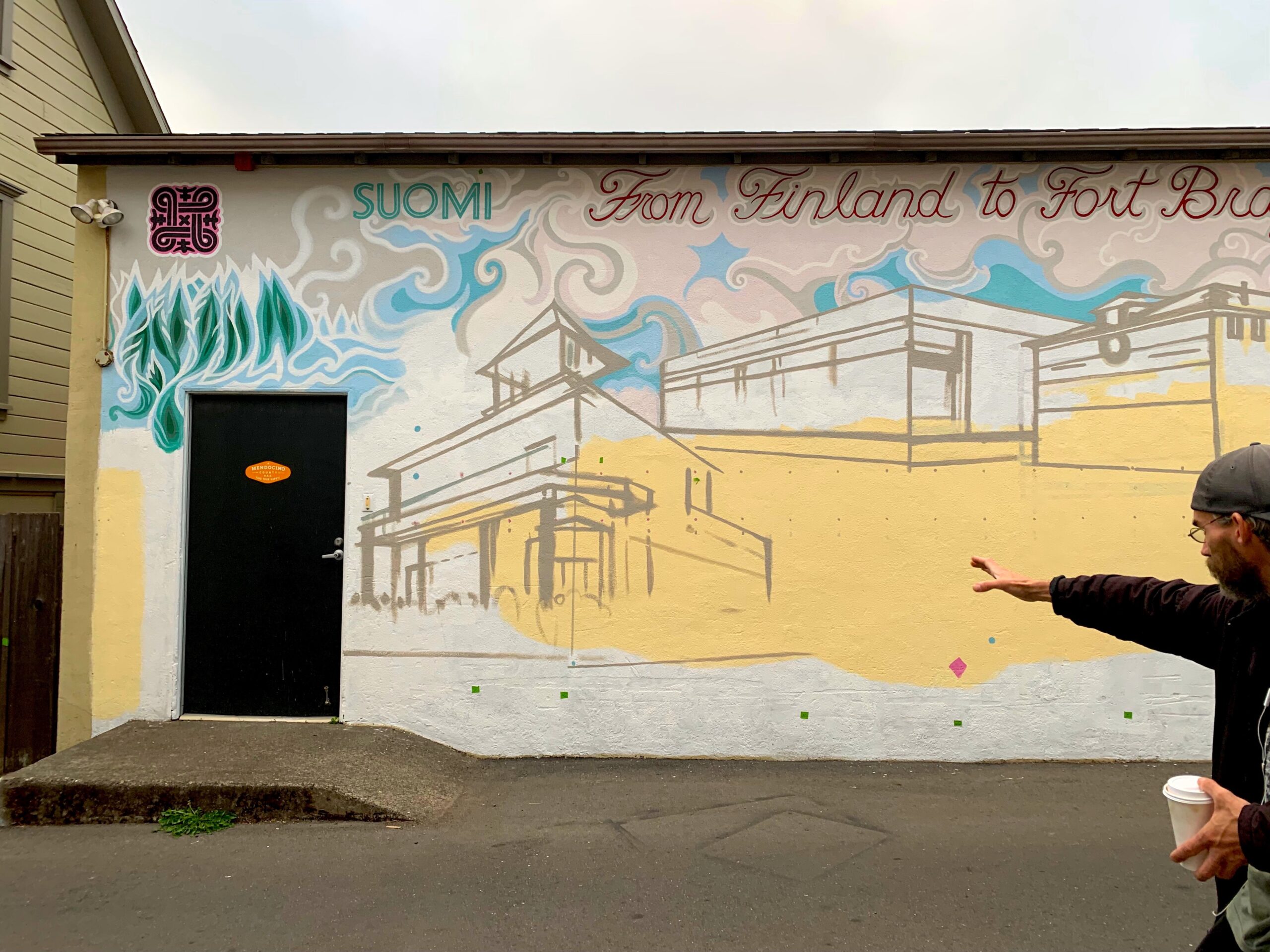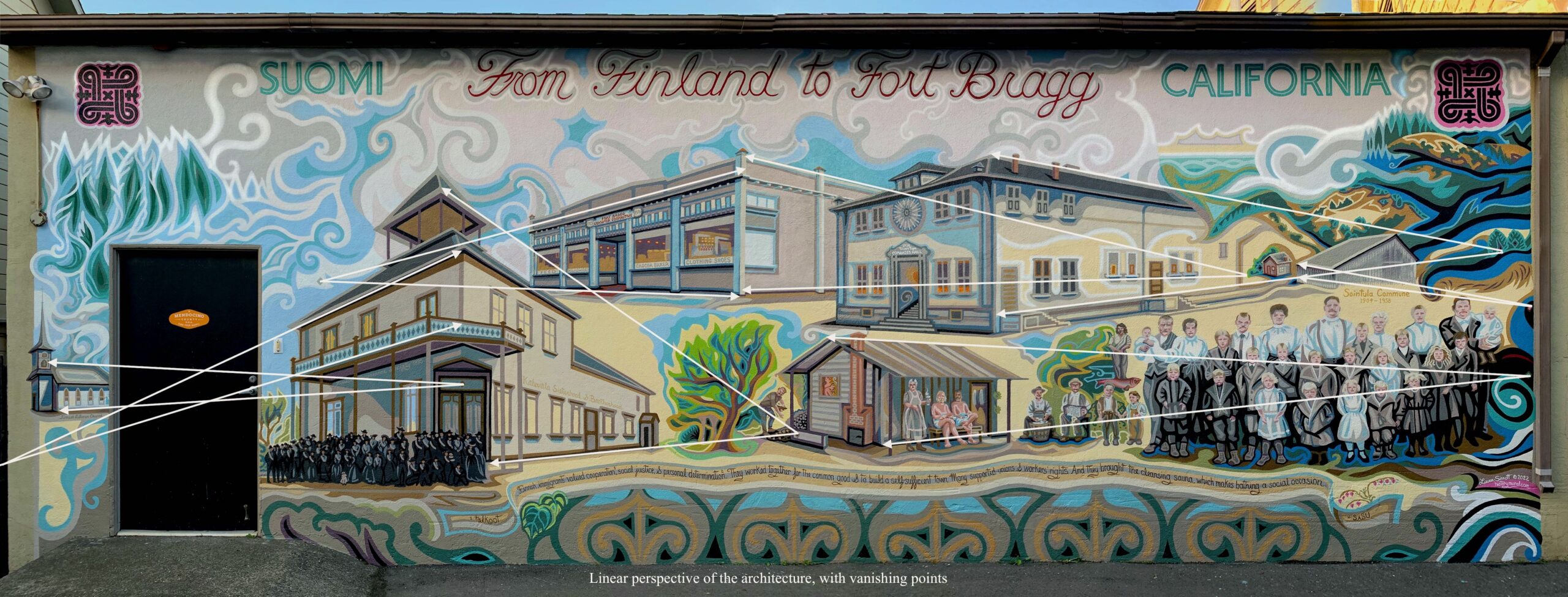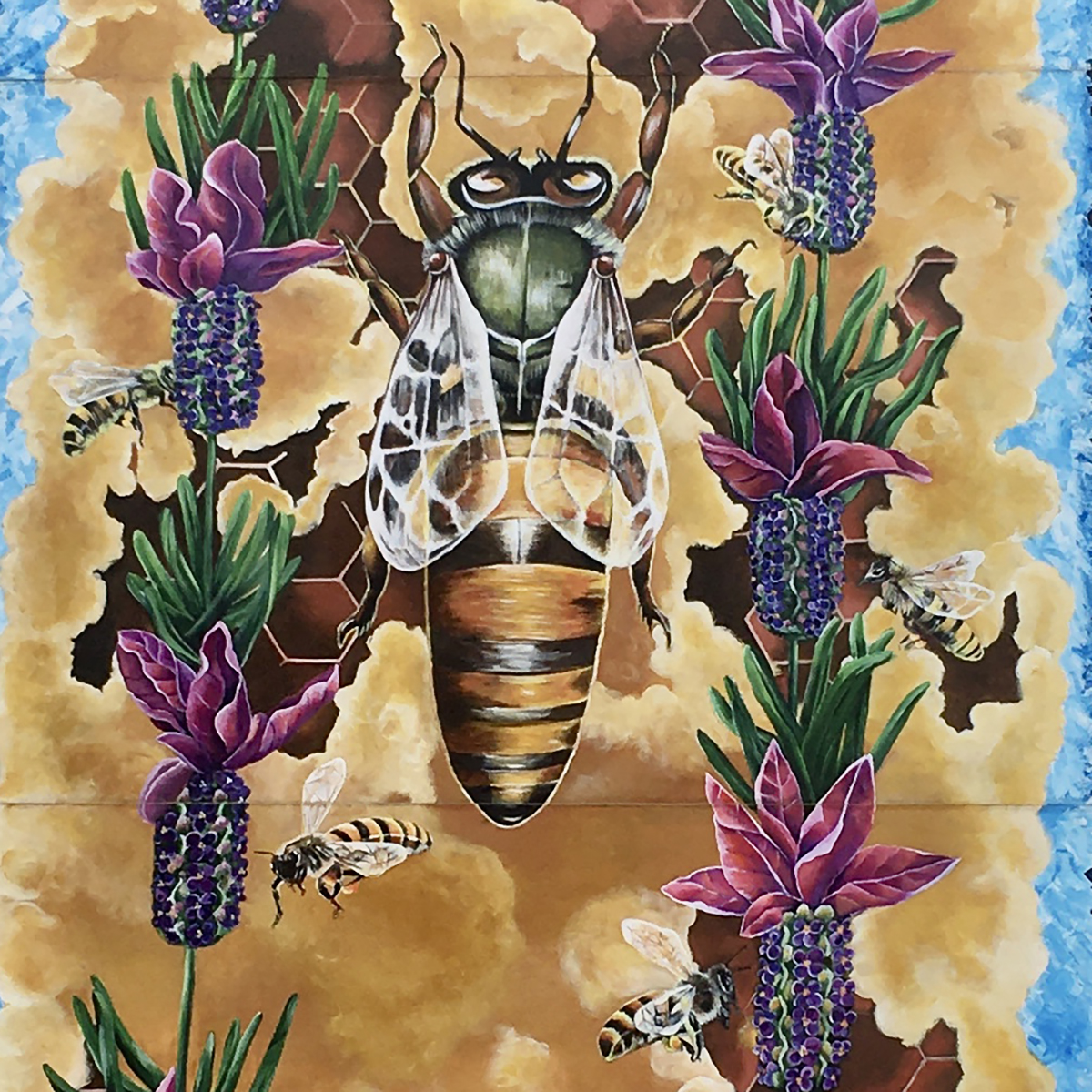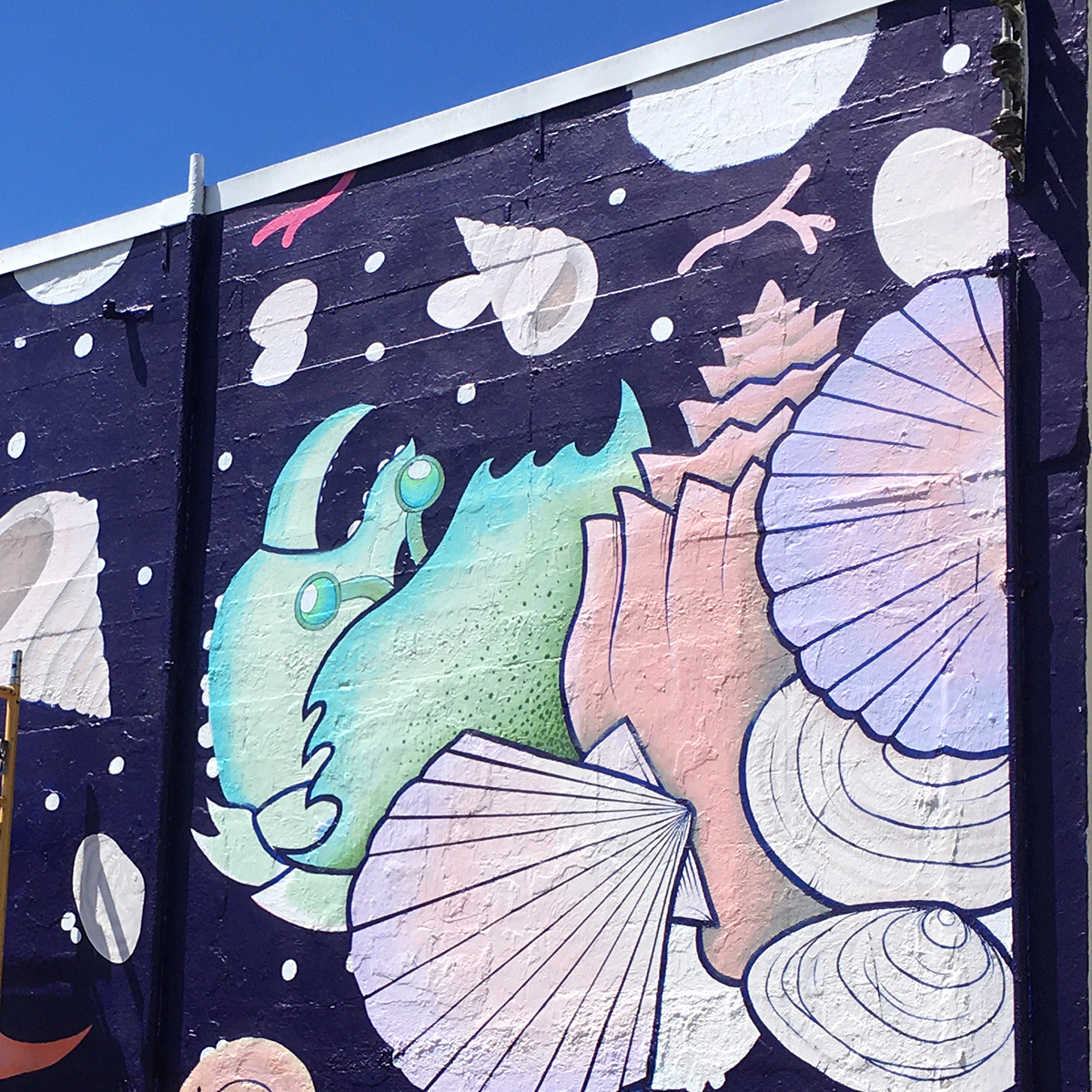Grey Whale Island

Title
Grey Whale Island
Artist: Nicola Beatts
Location: In the alley behind Roundman's Smokehouse. Turn north off of Laurel Ave between Main and Franklin. It's right near the sock shop.
Nicola has become one of Fort Bragg’s most prolific muralists. Look for her mural of Harbor Seals behind Napa Auto Parts, a mural of an orca and harbor seal in the Noyo Center for Marine Sciences on Main St., and coming soon – a mural of brewery equipment, hops and butterflies on the side of Tall Guy Brewery.
You can often find Nicola working at Triangle Tattoo. Follow her instagram here to keep updated on her artwork and adventures.

Inspiration for this installation
Roundman’s Smokehouse commissioned and funded this mural. Their only request was for a compact design that represented our part of the coast.
Nicola chose the elements of a whale and a forest because they are two of her favorite things in the area. She was born in Scotland, but moved to the Bay Area as a teenager, and then up to Chico. She’s only sort of joking when she says she moved to Fort Bragg from Chico to get away from the sunshine. Mostly, she just missed living near a coast.
“As a kid in Scotland you can see whales off the coast, so it was pretty neat to come to the other side of the planet and see the same thing. The oceans are all quite interconnected. I liked the idea of portraying the biological interconnectedness of these two adjacent but very different ecosystems, the oceans and the redwoods. In my experience living hee, it feels like the ocean and forest are on top of each other..”


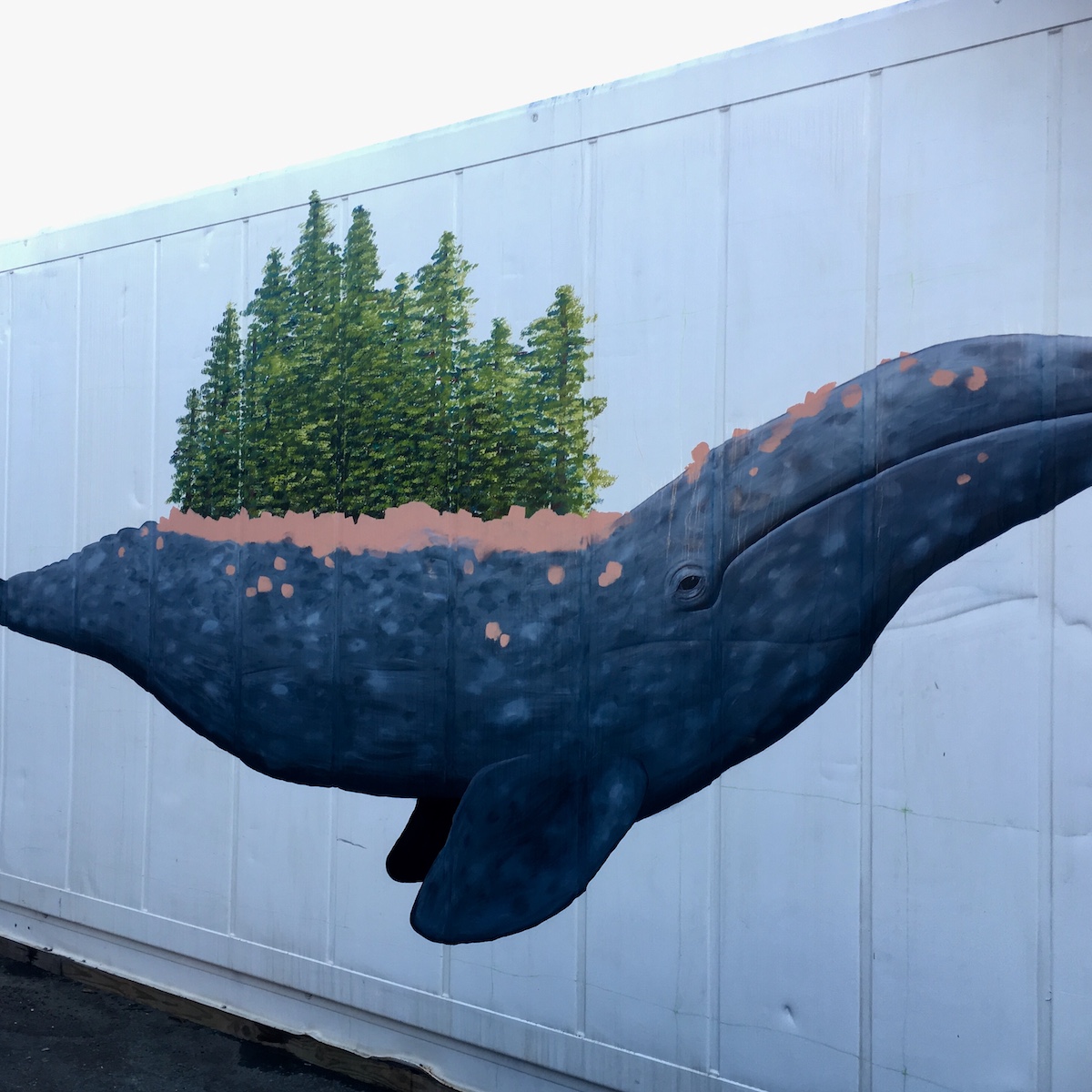


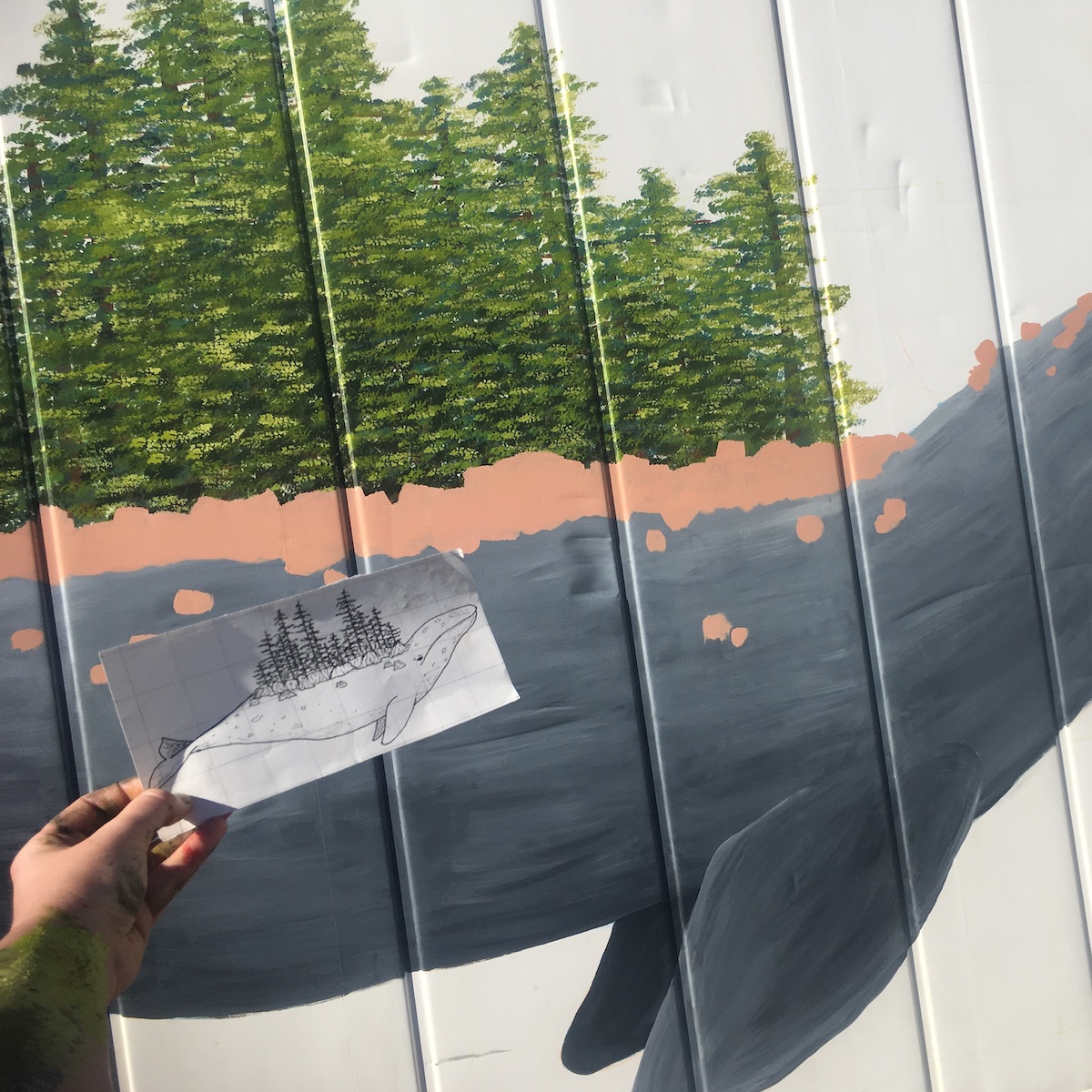
FUN FACTS
From November to February, the California Gray Whales can be seen migrating south to Baja. There, the pregnant females give birth. Starting in February and March, the whales migrate back north to Alaska with their newborn calves.
There are lots of great places to watch whales, but my personal favorite is from the very tip of MacKerricher state park’s boardwalk out on the headlands.
Those white dots on the whale’s back are barnacles. There is one species of barnacle and three species of whale lice that live on the gray whale. The barnacle (Cryptolepas rhachianecti) is unique to the gray whale, and of the three species of whale lice (in the genus Cyamus), two are found only on gray whales.
Here’s some more about grey whales from our friends at the Noyo Center for Marine Science
Join the Band!
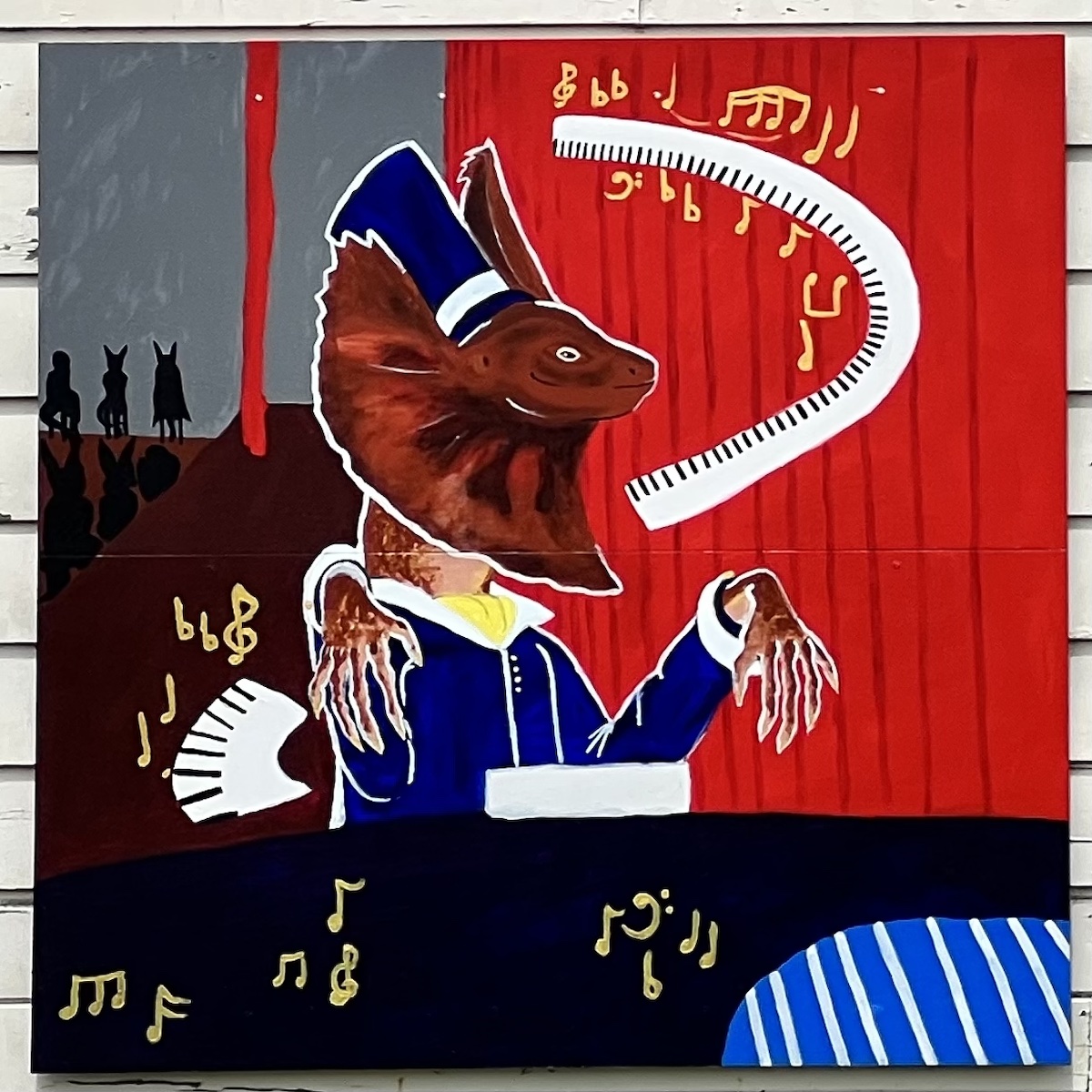

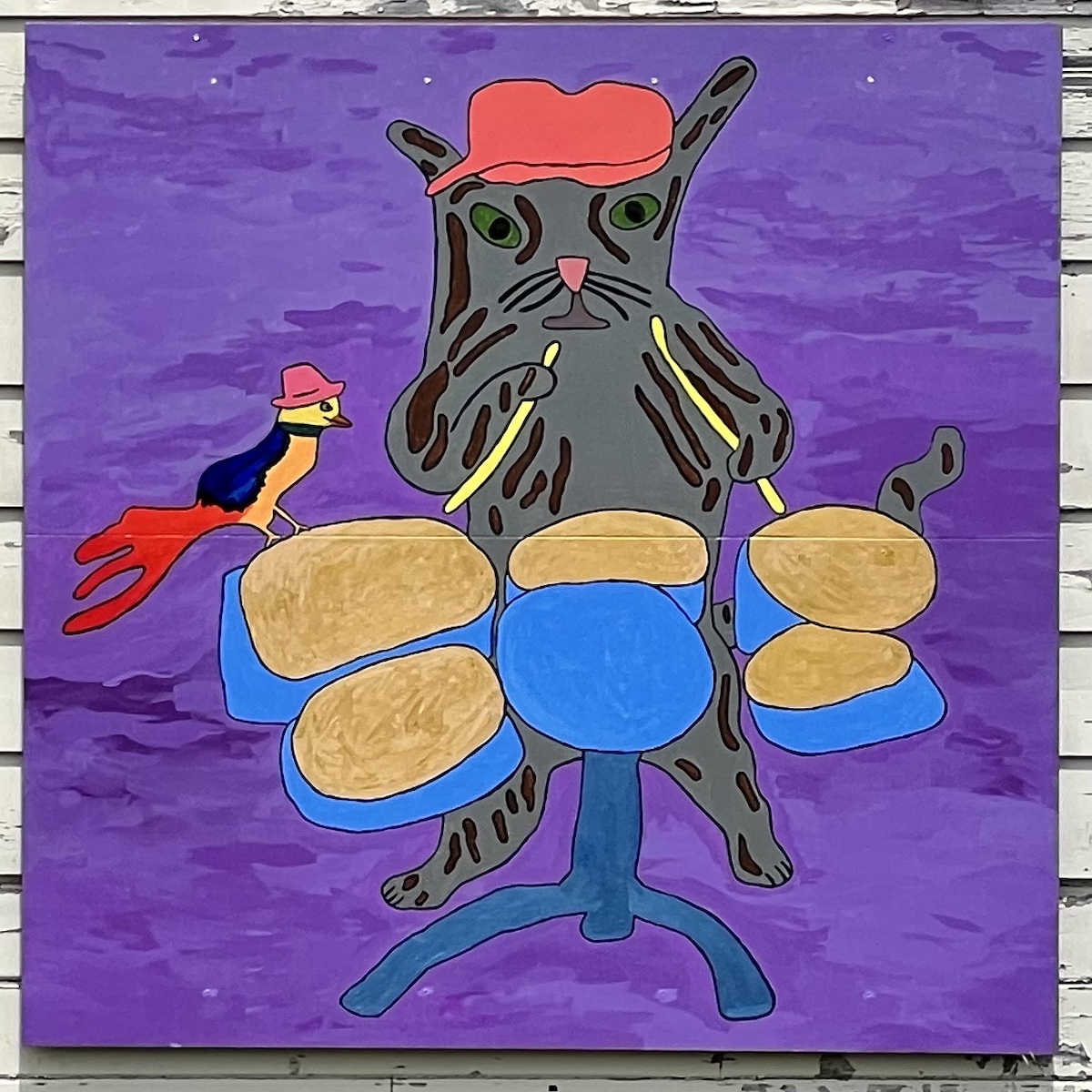
Title
Join the Band
Location: 310 N Franklin St.
Artists: "Frilled Lizard Playing Piano" by Jackson Deyerle.
Artists: "Lady With Guitar" by Kevin Pearl, painted by Kevin and Mike Barnes.
Artists: “Drumming Kitty” by Jonas Knutson, painted by Jonas, Jerry Turner, Stella Peterson and Robyn Peterson.
About Art Explorers
Art Explorers, Inc. is a non-profit creative arts program in Fort Bragg, California, that serves adult artists with developmental disabilities and brain injuries. We currently have an enrollment of 36 students, including some who have been participating for over 20 years. We have a spacious studio and gallery in the downtown area, where we exhibit and sell artwork on an on-going basis. We operate a 5-day a week program. Our funding comes from the Redwood Coast Regional Center and donations from the public.
Art is a universal, non-verbal language, without definite rules or restrictions. Our mission is to provide a fun, artistically stimulating environment for creativity to thrive, where people with disabilities are welcomed and accepted as artists. We nurture each individual artist to follow their passion, to discover the right art materials, and to find their own unique style and voice. Our studio is an uplifting, magical place…creating art together gives people a sense of purpose, and promotes camaraderie. This helps to combat the isolation that’s inherently part of the lives of many. We believe that art transforms lives, and opens the window to the deepest expression and yearnings of the human spirit. For more information or to make a donation, please visit our website: www.artexplorers.org
If you are standing in front of these three murals, the Art Explorers studio is right across the street to your left, at 333 Franklin. They are open Tuesday- Saturdays 9:00 am to 3:00 pm. Go say hi and see what the artists are working on this week.
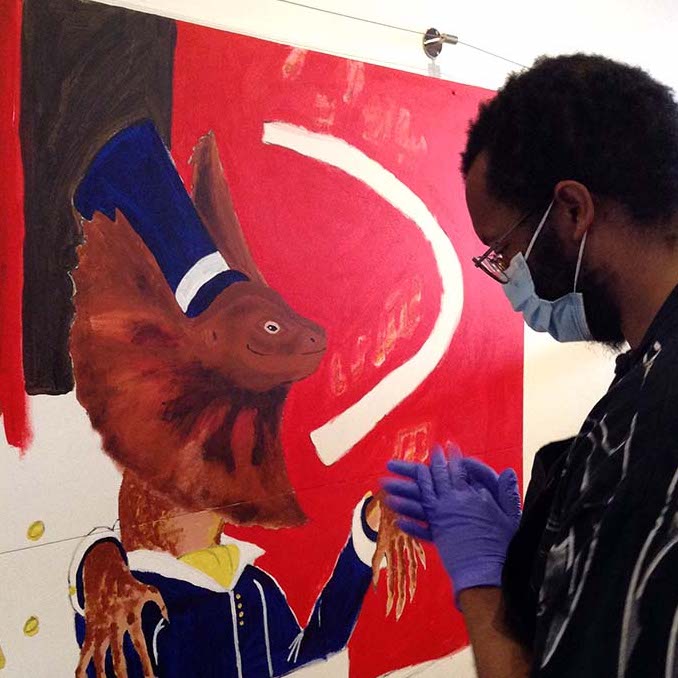
“Frilled Lizard Playing Piano” was created and painted by Jackson Deyerle.
Jackson started doing art in middle school—drawing with friends. His work is very detailed. All of his drawings are from his own imagination, but he finds inspiration in a lot of movies and shows, especially works by Hayao Miyazaki. Jackson researches his creations in books—using everything from cartoons to realistic styles and designs. He loves Anime and manga, but says, “Any art in the world is interesting to look at.” He also finds inspiration in music and cooking—two other art forms.
“Life definitely has its many challenges. Things can be hard. Follow your heart. Make friends, travel, make your own story.” – Jackson Deverle
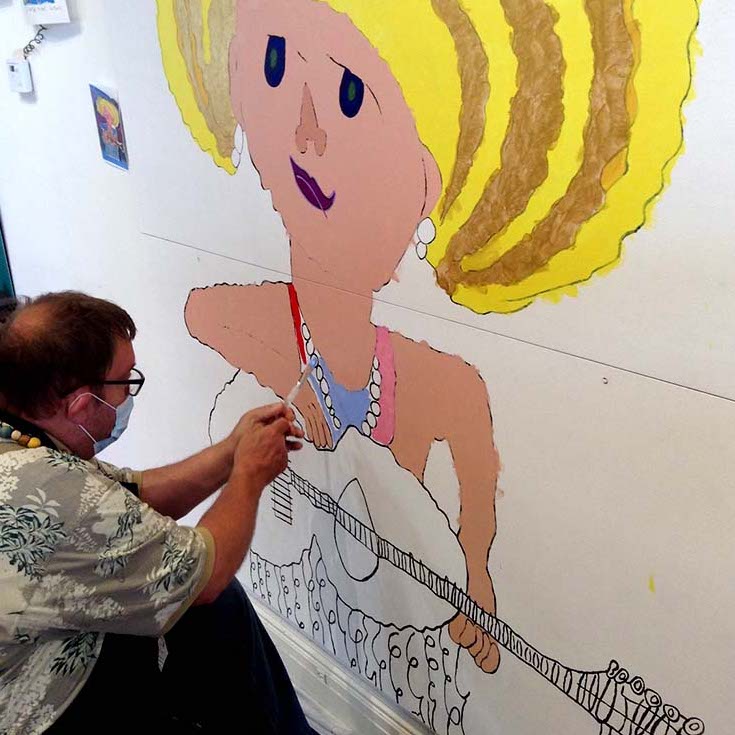
“Lady With Guitar” was created by Kevin Pearl and painted by Kevin and Mike Barnes.
Kevin has a rich, connected life. He is busy in his beloved hometown of Fort Bragg—working at the Paul Bunyan thrift store, hanging out with friends, and making art at Art Explorers. He is a people person! Kevin takes great pride in his finished work and often spends several weeks on one drawing. Kevin often uses collaged photos in his work, which he integrates into his drawings, and which give his artwork a contemporary quality. Kevin is inspired by modern culture, by western themes, by celebrities, and movies. He loves life, loves where he lives, and has a sense of humor about his work.
“Doing art makes me feel happy, and I love being happy.” – Kevin Pearl
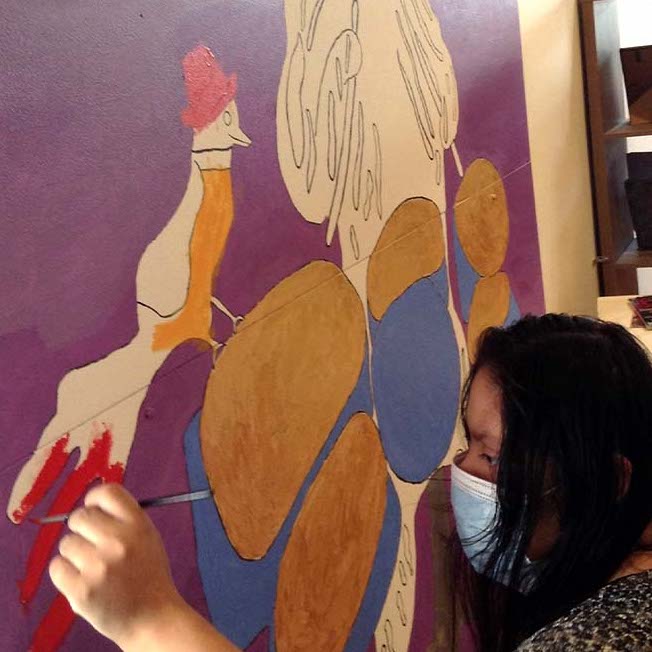
“Drumming Kitty” was created by Jonas Knutson and painted by Jonas, Jerry Turner, Stella Peterson and Robyn Peterson.
Jonas grew up in Lodi and Fresno, and moved to Fort Bragg, California in 2017.
He loves living by the ocean, and likes walking by the ocean. He is a big fan of the C.V. Starr Aquatic Center in Fort Bragg and tries to go there almost every day to swim. Jonas likes painting and drawing pictures of cool animals and rainbows. Besides art and swimming, Jonas likes to sing, and cook pancakes on Saturdays for breakfast.
Two Years - 2020, 2021
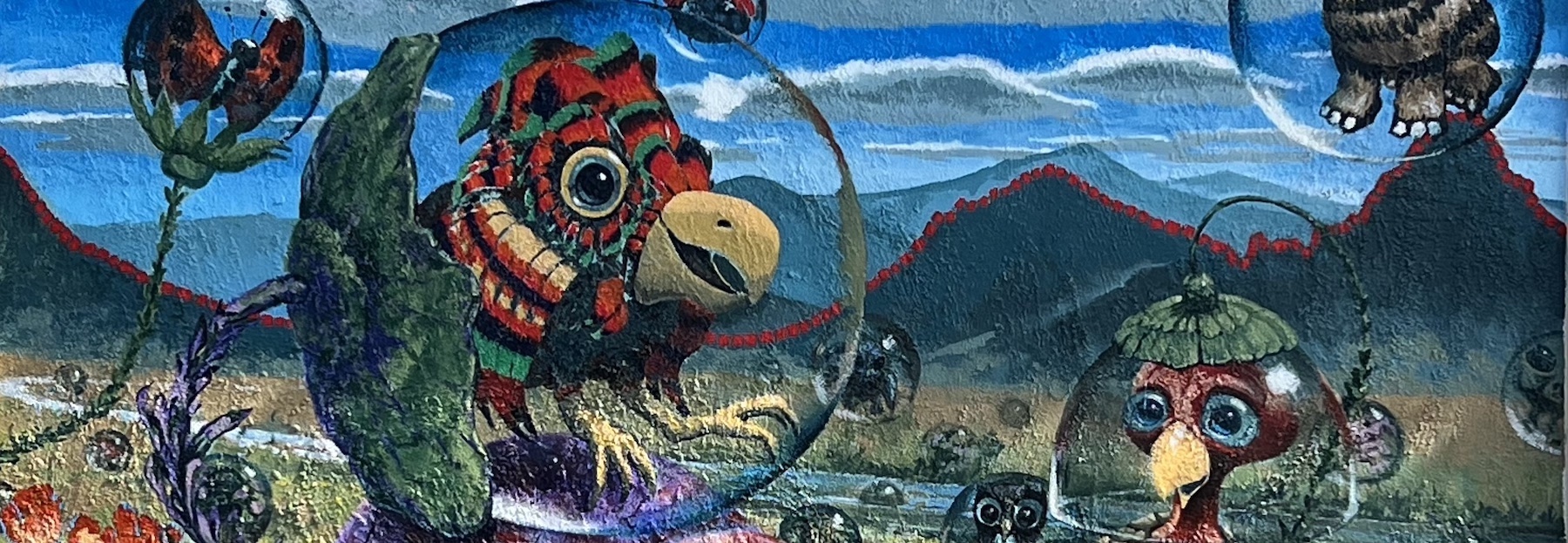
Title
Two Years - 2020, 2021
Artist: Jason Godeke
Location: 400 E Laurel St. Fort Bragg CA, across the street from Bainbridge Park
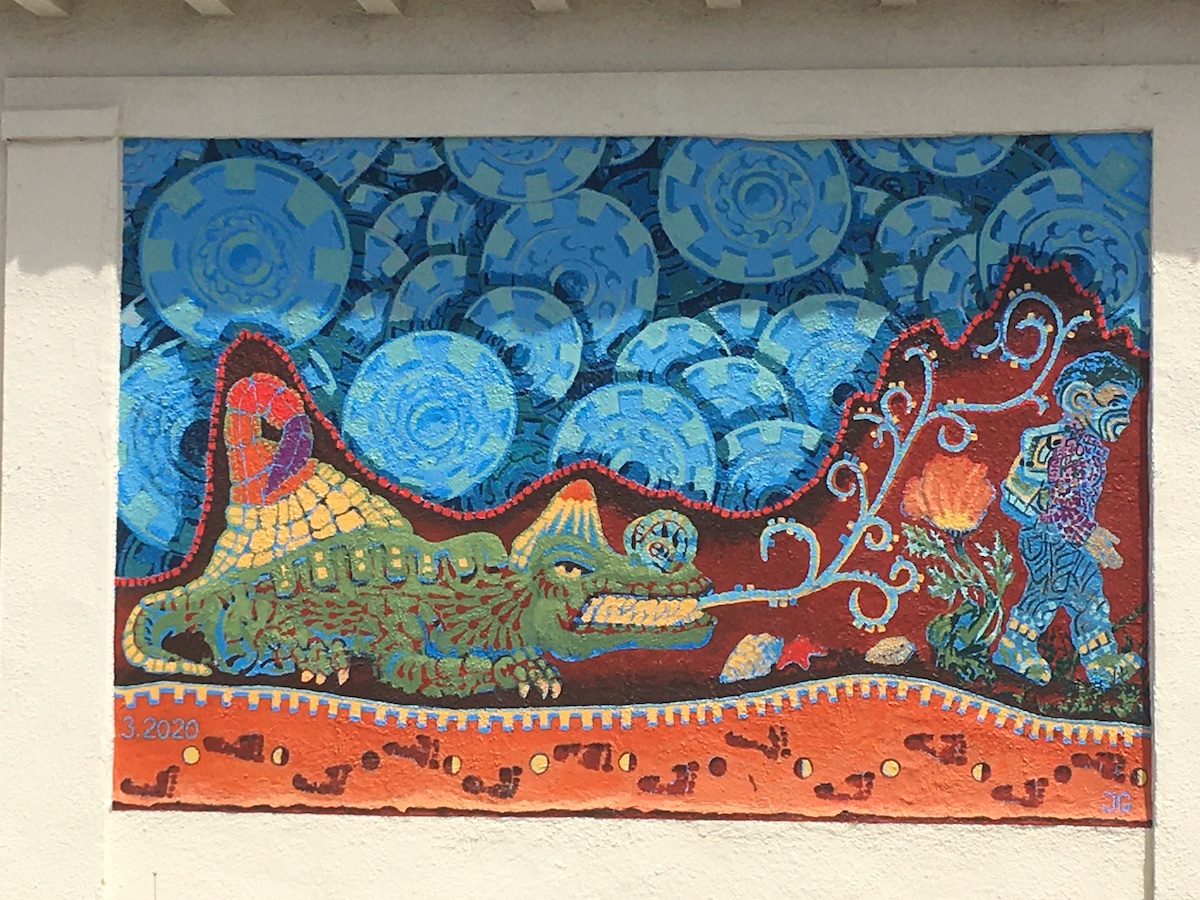

Inspiration for this installation
Is this dyptich simply two paintings of random dreamlike imagery? Yes and no. Every element of Two Years is a reflection of Jason’s (and our collective) lived experience and reactions to the COVID pandemic. The dotted red line that traces the mountain ridge connecting both murals is taken directly from the national Covid death chart for the years 2020 and 2021.

The Virus
This is Jason’s vision of the COVID virus. Unlike the green blob with red dots, which can seem to connote malevolent stickiness, Jason depicts it as a passive cloud of, mechanical programming. Often our language around viruses can anthropomorphize them, as if they are “looking for a new host.” In truth, they are simple biological systems, passively transported to environments where they infect and replicate, or inhospitable locations where they are destroyed by the elements. In 2020, they loom over the landscape like the low clouds of an approaching storm.

Alert levels
The crocodile is a reference to the health alert levels of yellow, orange, red and purple that were used to communicate the rates of infection within Mendocino county. Like many of us, Jason distinctly remembers watching with increasing alarm as we edged closer and closer into the purple zone.
Jason was inspired by mural fragments found in the ancient Mexican city of Teotihuacan. Check out the De Young’s incredible collection here.
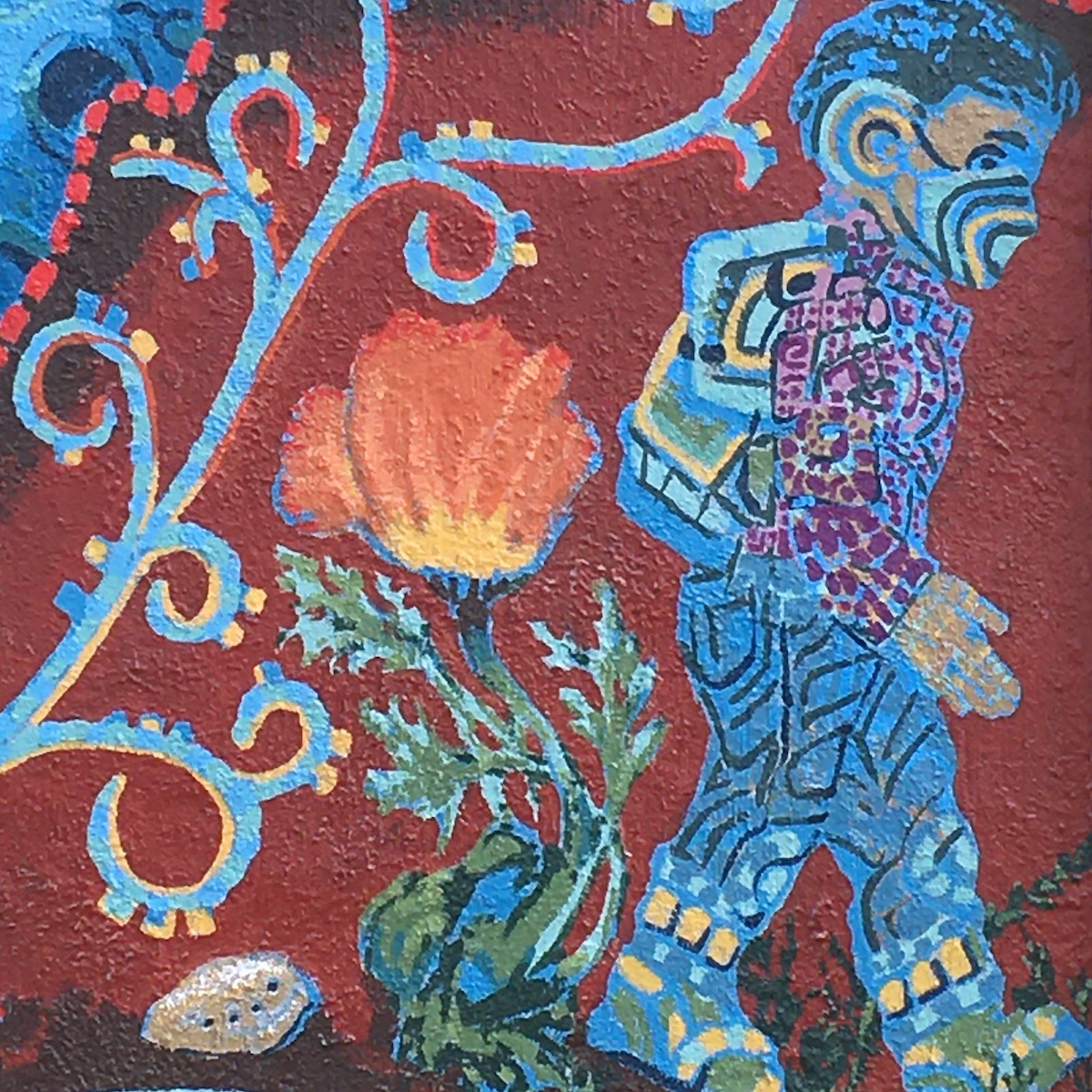
Risk
Virus particulate drifts out of the crocodile’s mouth, curling towards flowers, abalone, starfish, California poppies, and a child in a mask, a reference to the phase of the pandemic when we hadn’t yet fully identified the virus’s methods of transmission or persistence on surfaces. Every footstep outside the house felt suffused with risk.
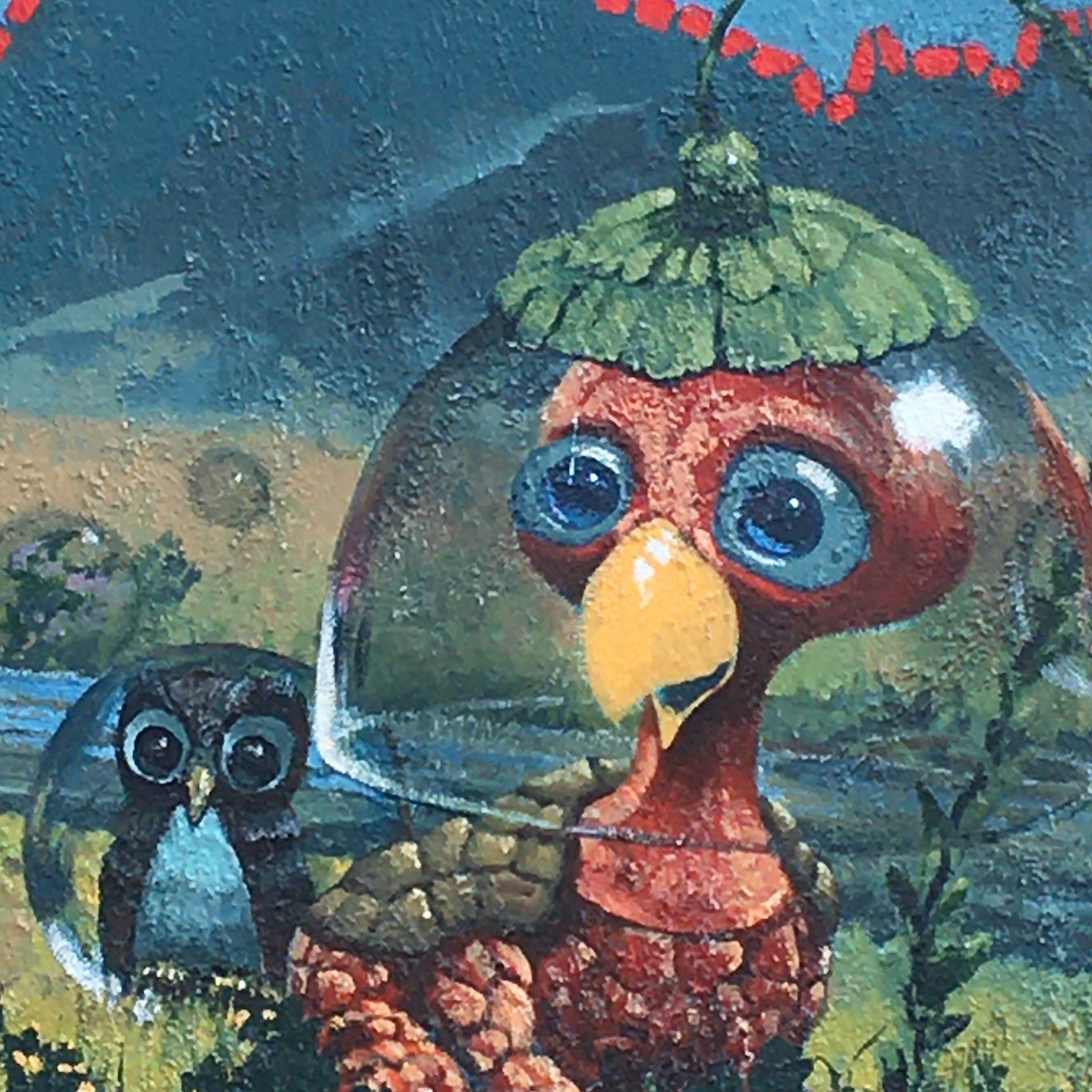
Bubble life
This alarmed creature with it’s head in a glass bell is a reference to the feeling of moon-suit sensory deprivation feeling you can get when walking around wearing a mask, glasses, and often earpods.
It’s also a direct reference to Heironymous Bosch’s famous tryptich The Garden of Earthly Delights, painted 1490-1500AD.
As the daily fear and anxiety of 2020 gave way to pandemic exhaustion in 2021, many people tried to reestablish social connections through small group pods, with varying degrees of success.
Jason remembers feeling like one strange creature out of many, drifting across the landscape of Fort Bragg, greeting friends from inside a self-imposed bubble of personal space.

Rolling the dice
The bubonic plague or Black Death swept through Europe in waves of infection and re-infection between 1345 and 1353. Though Bosch’s famous work is a warning against sinfulness and lust, it was within the context of a society still reeling from a pandemic catastrophe which seemed to the people at the time to choose its victims at random. Many people then, like now, chose to confront the randomness by throwing caution to the wind and living for maximum pleasure.
Spirits
by Ron Morita
Something stirred like one of Angelina’s sons when he lived in her body, pulling her
down the steps to the stone wall she restored. Ghostly wisps flew up the hill, dancing like angels.
Following gray cobblestones past houses with red tile roofs, she spotted what appeared to be a
man in a white shirt. He retreated, drawing her down the road. Perhaps the mysterious figure was
tall and handsome, with a lock of black hair falling over a bronzed forehead. After a long walk
she spotted the handyman’s cottage, its curtains closed. No doubt he was in bed with his wife,
snoring to wake the dead. All fogs are one, he had told her, so that if you stand in it and let your
spirit soar, you can feel the thoughts of someone in that same mist anywhere in the world.
At length she heard the whisper of surf and arrived at the road’s ugly scar across a black
sand beach. A cloud–or perhaps the sail of an unseen fishing boat–floated above the waves.
Mist thickened as she neared the water until it was hard to tell sea from shore, up from down.
Before she knew it water lapped at her thighs. The image of Jesus flashed before her. Quickly
she crossed herself.
Our Father, I am only sixty-one and in excellent health. Why have you come for me?
A man’s voice, sounding far away, called her name.
This excerpt appeared in Vine Leaves Literary Journal, January 2014
Poetry and Prose generously donated by members of Writers of the Mendocino Coast. Learn more about this fantastic group!
From Finland to Fort Bragg
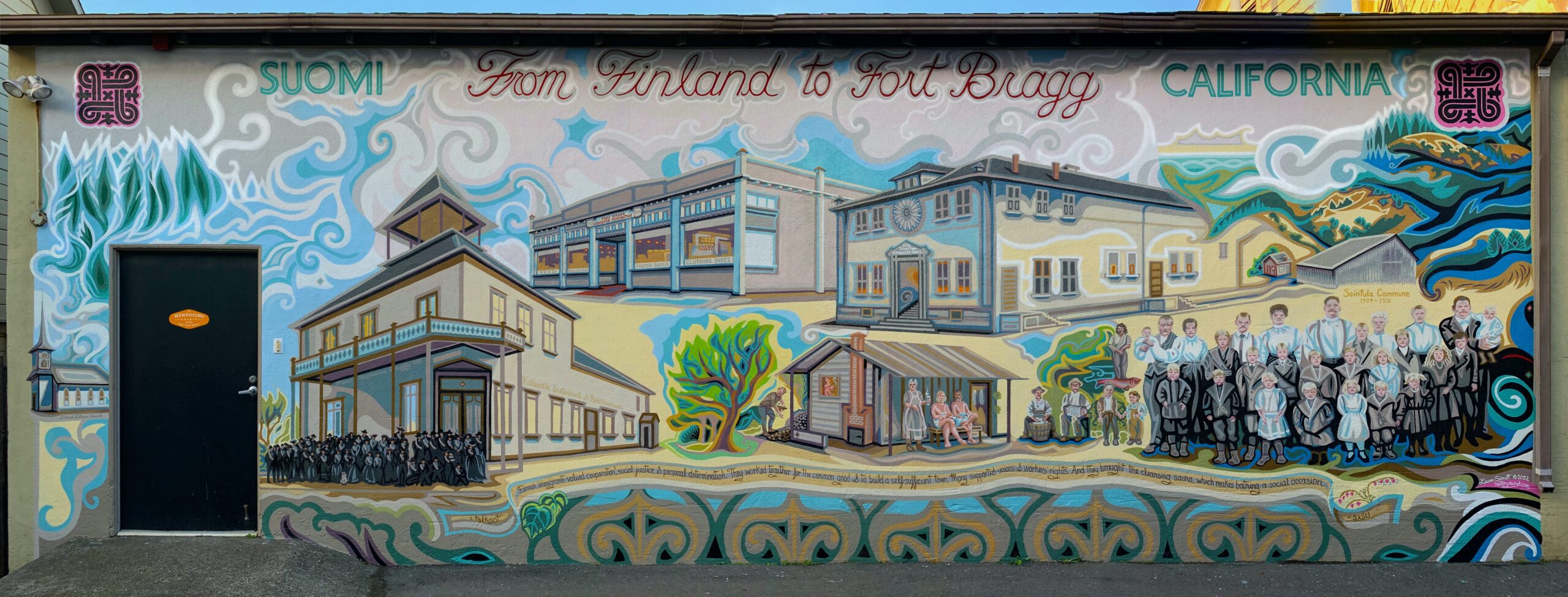
Title
From Finland to Fort Bragg
Artist: Lauren Sinnott
The new history mural by Lauren Sinnott illustrates the rich heritage of the many Finnish immigrants to this coastal northern California town.
The mural contains portraits of real people, past and present, and images of the functional and often beautiful structures built by the Finnish families to house their activities and make it easy to get work done and have fun.
For example, the Finns built a huge hall (7,500 sq. ft.) in order to put on concerts, throw parties, present lectures and stage plays. Its name was Toveri Tupa, or Comrades’ Hall. But tupa translates as “cottage” so it meant something more like the Comrades’ cozy living room. After all, nobody had an actual living room that could receive several hundred guests.
The Finns were the biggest immigrant group coming to and creating Fort Bragg. There was a large “Finn Town” in the eastern part of the city, as well as settlements on Pudding Creek, Tunnel Hill, and Noyo Hill. Also in Comptche, a bit farther away. These communities built their own halls and schools, often reached by crossing a walking bridge suspended over rivers.
Immigrants from Finland during the late 1800s and early 1900s formed the largest national group to create the bustling town of Fort Bragg on the northern California coast. The Finns valued cooperation, equality, and a state of mind called sisu, meaning personal determination in the face of adversity. They worked together for the common good and brought the cleansing sauna, which turns bathing into a party!The new history mural by Lauren Sinnott illustrates this rich heritage. Located downtown, it was sponsored by the City of Fort Bragg and local dentist/art patron Alan Limbird.
Lauren found her true calling as she painted the block-long narrative history mural in Ukiah: telling the story of a place through a tapestry of real events and portraits of local people.
Lauren Sinnott is an artist, historian, seamstress and former Mayor. Her route to this part of California where populations are dwarfed by the ridged landscape and pounding ocean, led first through Europe and Texas. Lauren was raised in Wisconsin’s dairyland by a working artist mother and poet father. She spent her senior year as an AFS exchange student in Belgium, speaking only French and discovering the art of conversation, four-hundred year old houses, good coffee and great beer. At Rice University in happily hot Houston, she earned a BA in Art and French, a BFA in painting, and an MA in Art History.
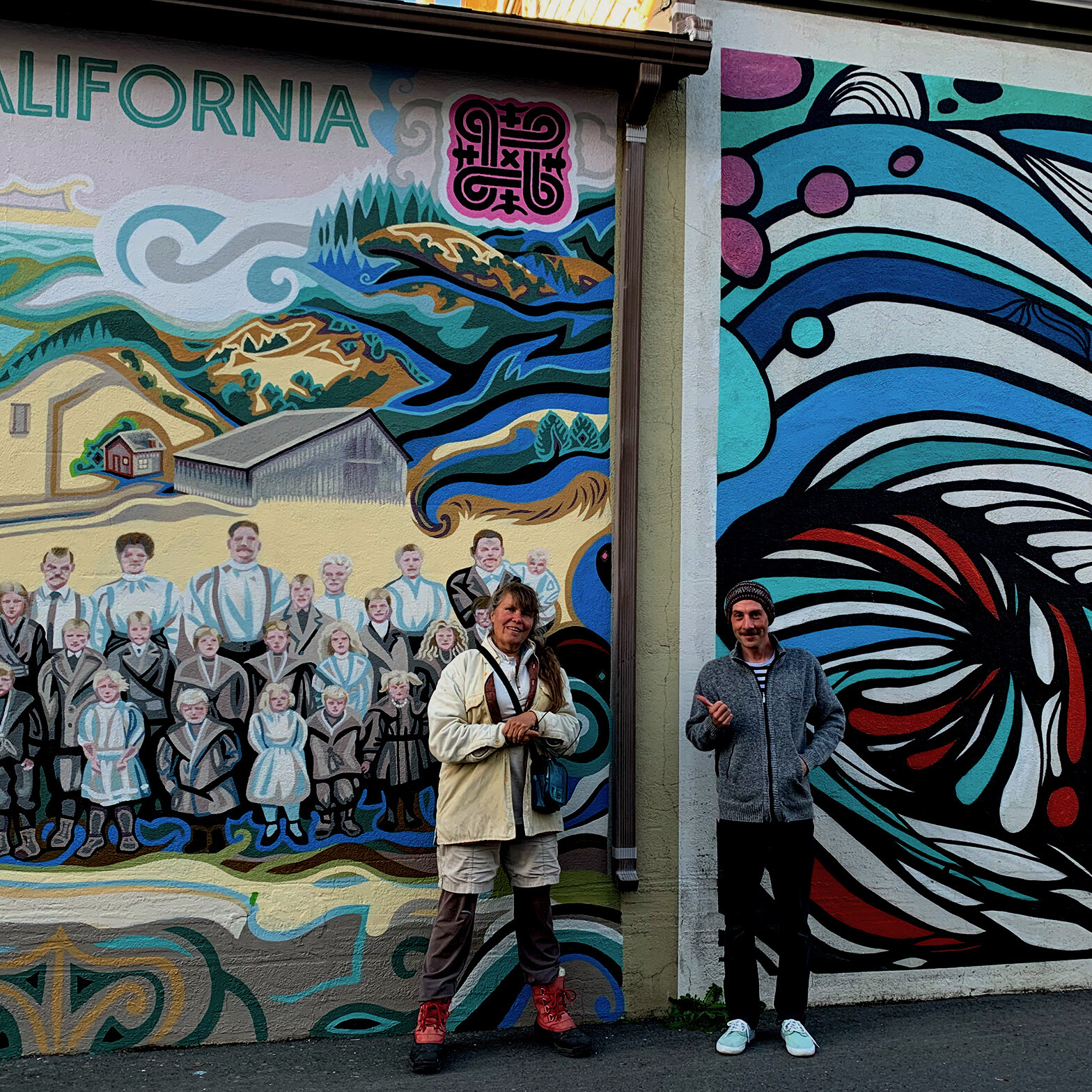
In 1999 Lauren and her two young sons left city life, heading west in a school bus outfitted with beds and a wood stove. They lived in the bus on a south coast ridge for a year. After moving into Point Arena, Lauren paid her new mortgage with jobs ranging from business signs to ornate murals, from tombstone design to painting a high school mascot on the basketball court floor. She sewed a life-size torso with female reproductive parts for a doctor and created the Velvet Vulva line of purses for feminists, therapists and brides. She painted curbs and hemmed pants. Her career crown jewel is the huge historical narrative mural on the north wall of the Ukiah Valley Conference Center. It is a public work for everyone and about everyone. The mural contains over two-hundred portraits, and tells many stories past and present. Lauren’s style combines realism with decorative pattern, portraiture with symbolism and inscription, subtle color with giant curlicues!
Lauren’s new mural is called “From Finland to Fort Bragg” and continues her love of detailed historical illustration as a way to honor the subject and keep memory alive.See much more at www.historymural.comSee Lauren’s job site updates on Facebook https://www.
When your studio/living room is a downtown sidewalk, you meet people and hear about their lives. They bring you scones and sushi. You paint and ask questions and listen. The planned subject matter for an ambitious depiction of history starting before human habitation and marching into the future grows even bigger and very much better. The project is now a collaboration, not of brushwork, but of content. To all this, Lauren brings her life-drawing skill, knowledge of art history, symbolism and delight in pattern. Alan Limbird saw the Ukiah mural in progress and said, “Come do your next one in Fort Bragg! I have just the building.”
Contemplating what part of Fort Bragg history to paint, Lauren sought something inspirational and neglected. What was an important story that deserved a new spotlight? She read a mention of the early Consumer Co-operative being founded by immigrants from Finland. Further research revealed how many Finnish immigrants had come here, bringing strong traditions of equality and cooperation in the service of building a self-sufficient community. The mural concept started to take shape!.
- IMAGE 10 of the wall from the left, in progress
- IMAGE 11 Toveri Tupa MASTER
- IMAGE 12 Toveri Tupa front
- IMAGE 13 Temperance Society/Kalevala Hall in the mural
- IMAGE 14 Photo of Temperance Society in front of their hall
- IMAGE 15 David Maki showing the Fort Bragg Kalevala Brotherhood charter of 1897
- IMAGE 16 Kalevala Hall – closer detail
The Finnish Kalevala lodges were formed to enhance community cohesion and prosperity and to keep Finnish culture alive. The Kalevala Brotherhood and Sisterhood were chartered in Fort Bragg in 1897 and 1898. They bought the hall in 1920.
The Fort Bragg Cooperative store started in 1923.
- IMAGE 17 Consumer Co-op in the mural
- IMAGE 18 photo of the Co-op c. 1940
- IMAGE 19 detail of the Co-op in the mural
There was a wave of cooperatives being established around 1900 across California and the nation. Associations of co-ops formed to gain strength in numbers. But excessively rapid growth led much of the network to crumble, and most co-ops were closed during the 1920s. By the time the US economy crashed in 1929, there were only 5 co-ops left in California, and Fort Bragg’s was one of them!
The Finnish Evangelical Lutheran Church was constructed by Finnish immigrants in 1889 at the corner of Redwood Avenue and Corry Street.
- IMAGE 20 Lutheran Church
The beloved church was a central part of the Finnish community. Many of the immigrants also welcomed the fact that becoming a member of a church was a choice. They welcomed the American principle of freedom of religion, including the freedom to join no church at all.
See www.historymural.com/finn/
- IMAGE 21 top title
Narrative murals can benefit from symbols and writing. Both are present here. I wrote the mural’s title at the top, using skills I learned in grade school, and painted the Finnish hannunvaakuna, symbol of good fortune, in the top corners.
- IMAGE 22 need this
- IMAGE 23 need this
- IMAGE 24 inscription detail
“Finnish immigrants valued cooperation (footnote 1), social justice, & personal determination (footnote 2). They worked together for the common good & to build a self-sufficient town. Many supported unions and workers’ rights. And they brought the cleansing sauna, which makes bathing a social occasion.” 1. talkoot means work done as a group for the common good. 2. sisu is the very widely understood Finnish trait of calm determination in the face of adversity.
- IMAGE 25 mural detail of the sauna
Saturday evening saunas were a chance to relax, talk, invite guests, and enjoy coffee and cake, or beer and sausage afterwards.
Grandmas did a lot of things, including catch salmon and serve coffee
In the mural, the lady serving coffee is Finnish descendant VoVo Cain’s beloved Grandma Katie. She was Katie Halonen before the name was “Americanized” to Hellen.
- IMAGE 26 Grandma Katie
- IMAGE 27 closer view of the sauna figures
- IMAGE 28 Lauri Rissanen posing
- IMAGE 29 detail of Hilma Holmi Maki
- PHOTO 30 of David Maki’s grandma Hilma Holmi Maki with her fish
- IMAGE 31 Sointula group
- IMAGE 32 mural central group
- PHOTO 33 David Maki looking at his grandma’s portrait
- PHOTO 34 Sylvia Erickson Bartley looking at her portrait
- PHOTO 35 Paul Nylund with his portrait
See more here www.historymural.com/
- IMAGE 36 Lauren working on scaffolding
- IMAGE 37 Linear perspective!
- IMAGE 38 left side w/string for achieving the linear perspective diagonals
- IMAGE 39 buildings take shape, Adam points at the wall
- IMAGE 40 perspective of the architecture
- IMAGE 41 the building is almost complete, now for the figures…
- IMAGE 42 the people are complete.
- IMAGE 43 Sointula figures
- IMAGE 44 Sointula portraits complete
- IMAGE 45 whole wall
The tree takes shape:
- IMAGE 46 tree sketch
- IMAGE 47 tree finished
- IMAGE 48 the mural seen from the right.
- IMAGE 49 the two murals meet
Harbor Seals
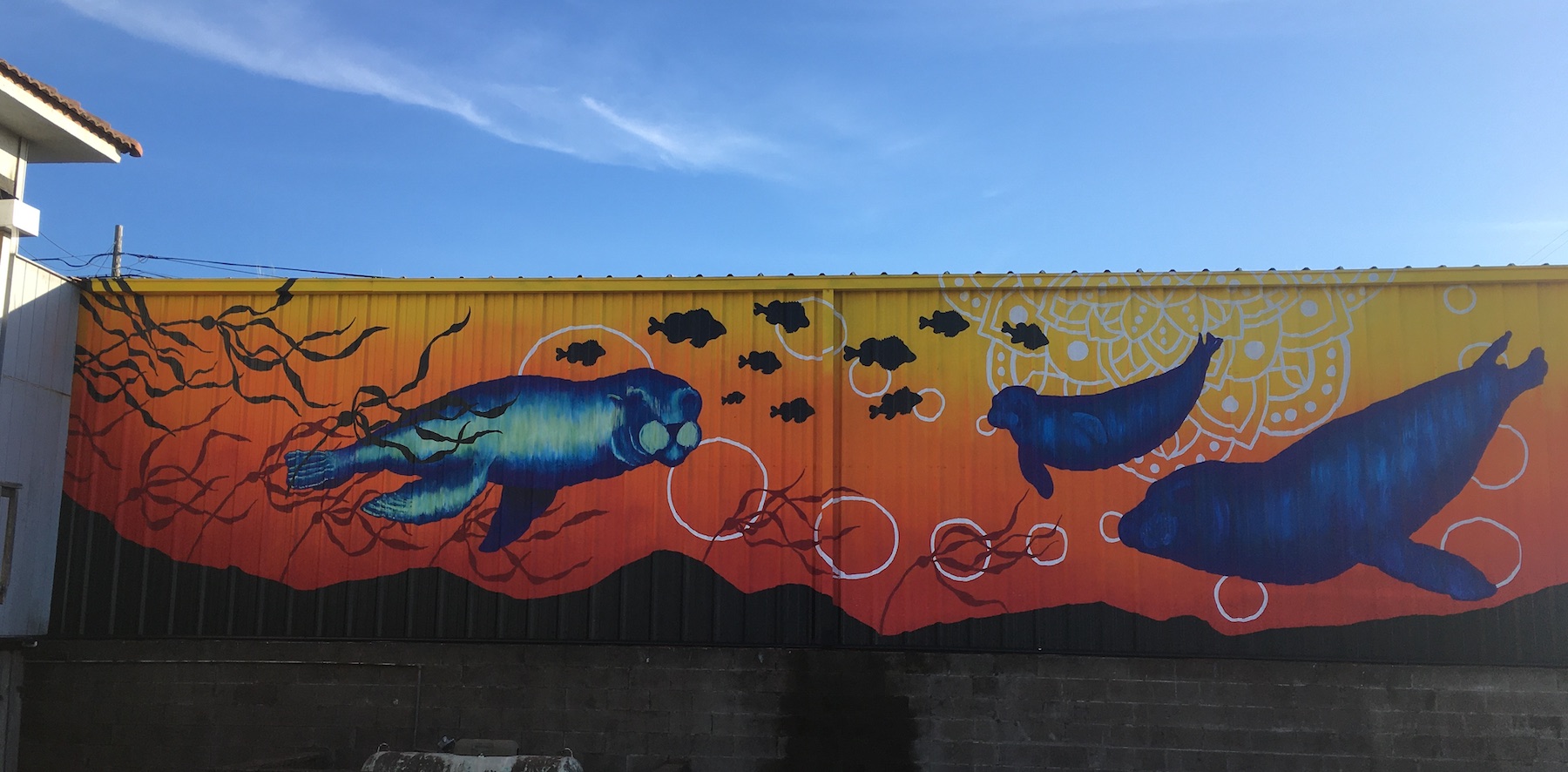
Title
Harbor Seals
Artist: Nicola Beatts
Location: 203 N Main Street. Behind Napa Auto Parts
Inspiration for this installation
When we first looked at this corrugated steel wall, we thought there was no way anyone could install any design that wasn’t geometric due to those vertical lines. But Nicola Beatts was undaunted. She is locally famous for her marine mammal artwork at locations such as the Noyo Center for Marine Sciences and the alleyway behind Roundman’s Smokehouse and she had a vision for this wall. Her proposal was a warm underwater sunset, with blue harbor seals pausing in their ocean frolics as if they are observing the viewer curiously, as bull kelp sways in the currents before a white mandala of solar radiation.
When she is not blowing us away with her mural talents Nicola is often found at Triangle Tattoo. Check our her instagram here…

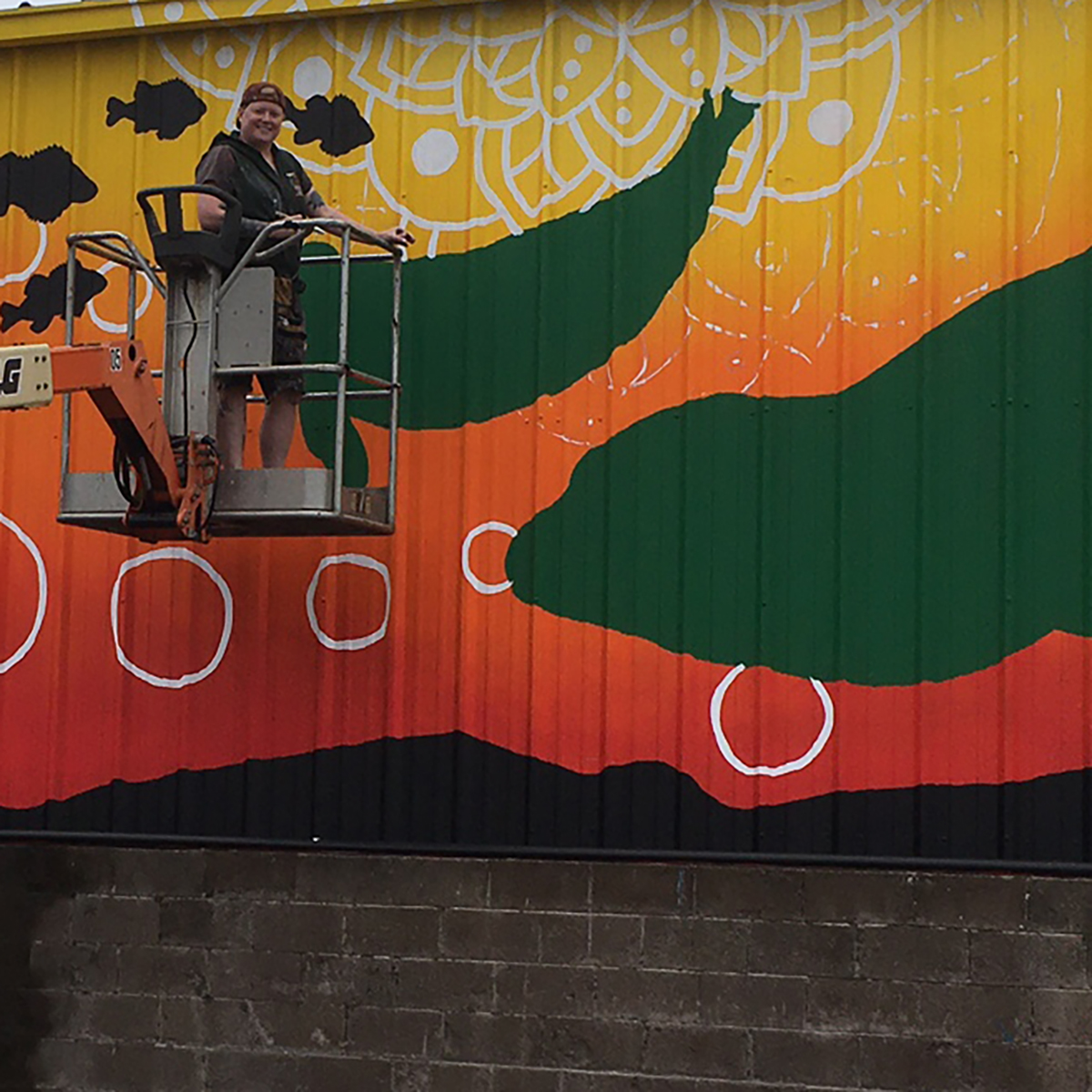
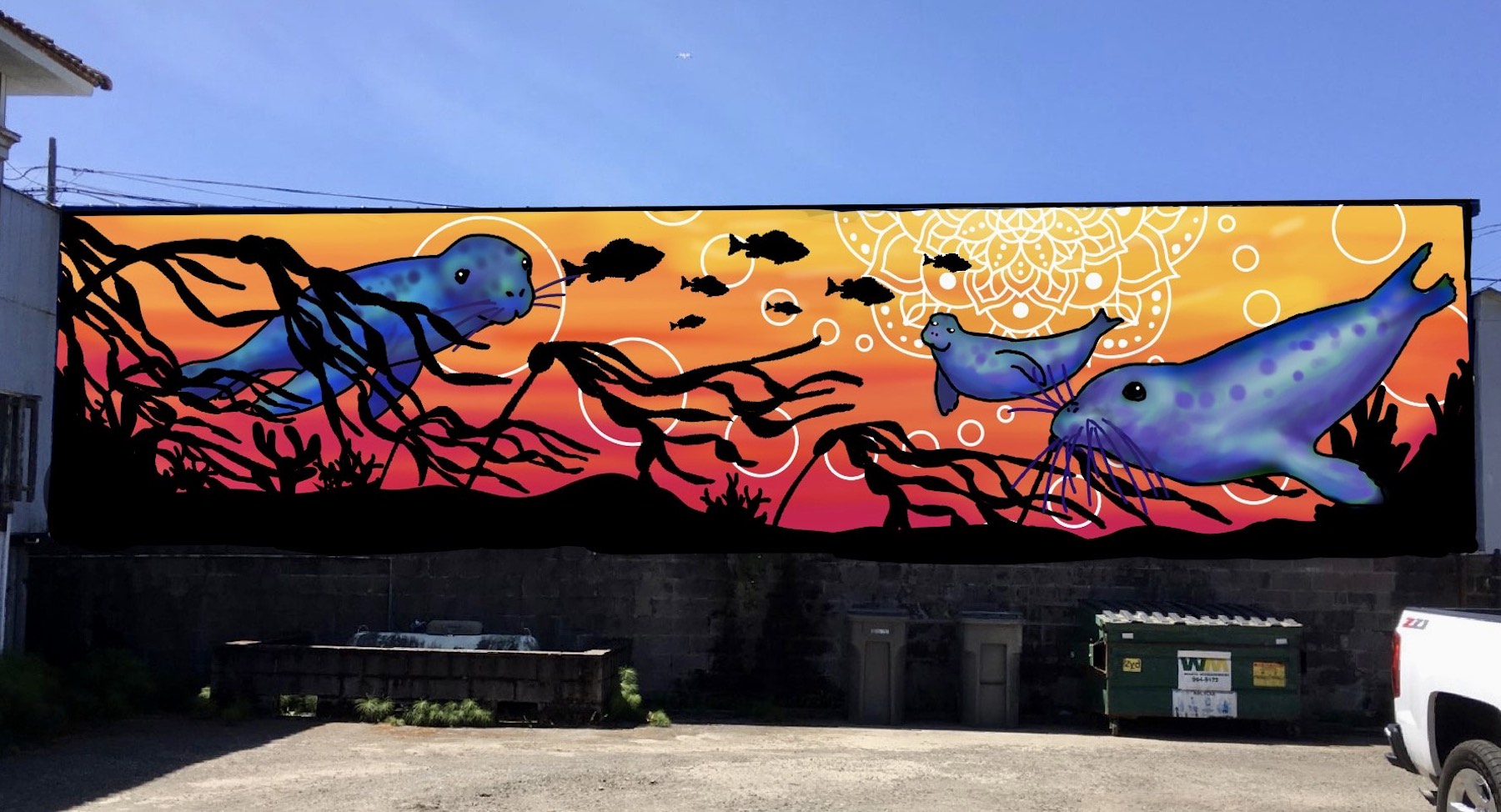
This was Nicola’s original design mockup.
Who loves marine mammals? We do! We do!
If you are standing in front of this mural you are just steps away from an entrance to the headlands trail. Just off this coast, under the waves is a kelp forest – or at least there used to be.
Both Nicola and the Alleyway Art Project are thrilled to be partnering with The Nature Conservancy to bring some much-needed attention to our local kelp forests.
Learn more about The Nature Conservancy and their work locally and globally here…
California’s incredible kelp forests are a critical ecosystem that is more productive than the Amazon rainforest. A breeding ground for more than 1000 species, they act as a protective blanket for our iconic beaches and have an immense impact on jobs and revenue for our state.
But a perfect storm has destroyed 96% of kelp forests on California’s North Coast.
The combination of warming ocean temperatures and a deadly virus has led to the die off of the sunflower sea star, which has set off a chain reaction resulting in massive loss for kelp.
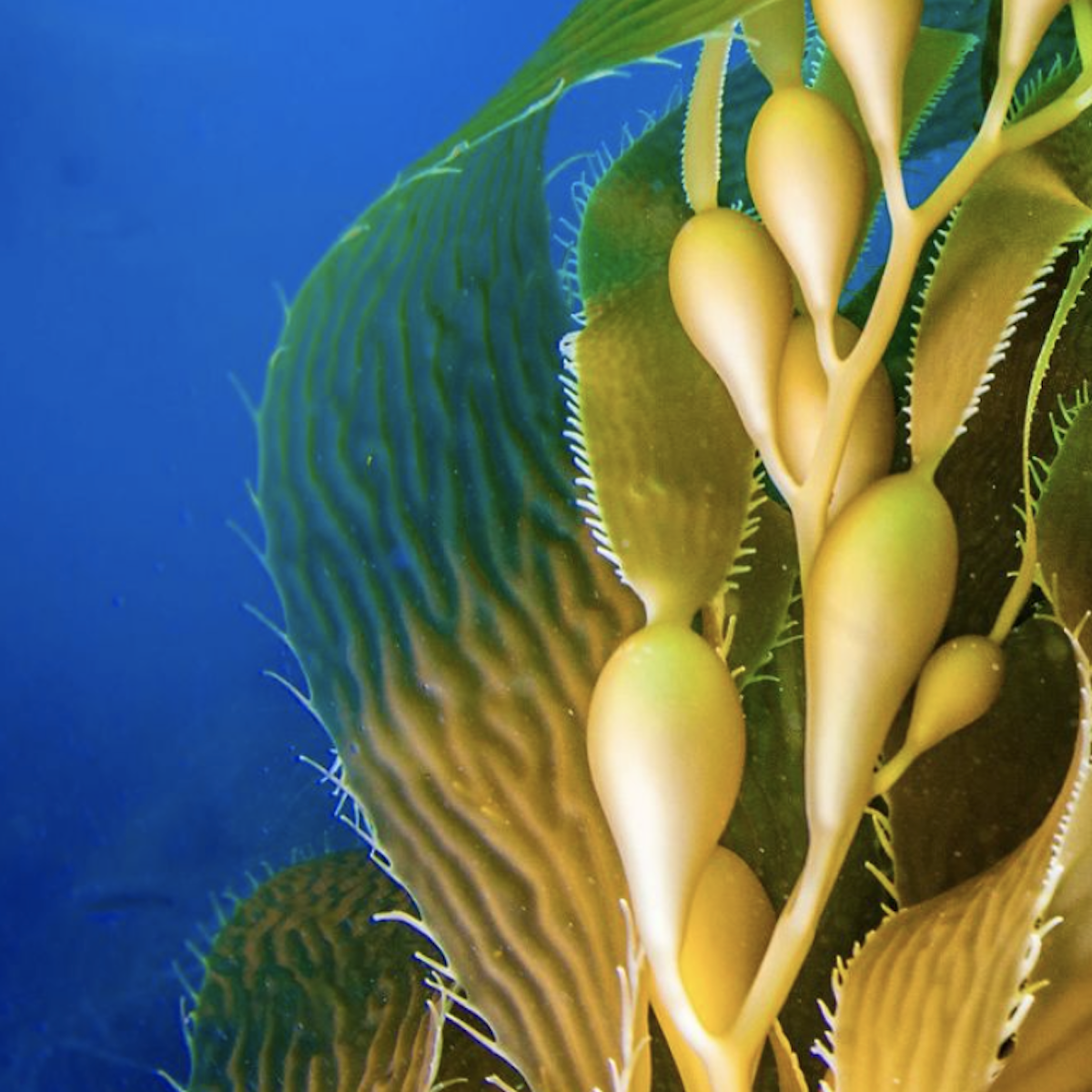
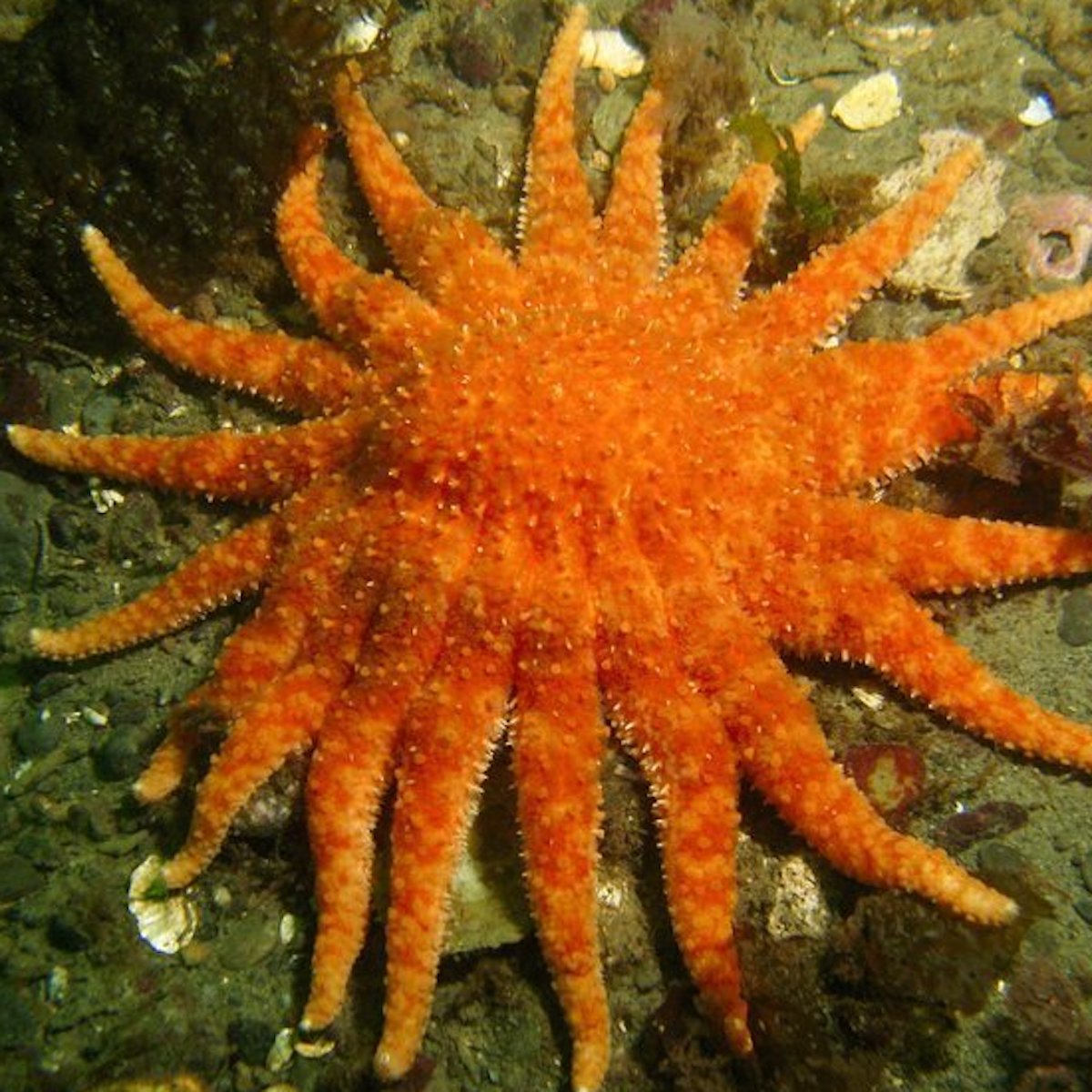
Sunflower sea stars eat purple urchin, and without enough sea stars, the urchin population has exploded to 60 times its usual size. Purple urchin feed on kelp and this ballooning population has eaten its way through much of the kelp forest, resulting in what could be permanent damage to the ecosystem if we don’t find a way to rebalance these species.
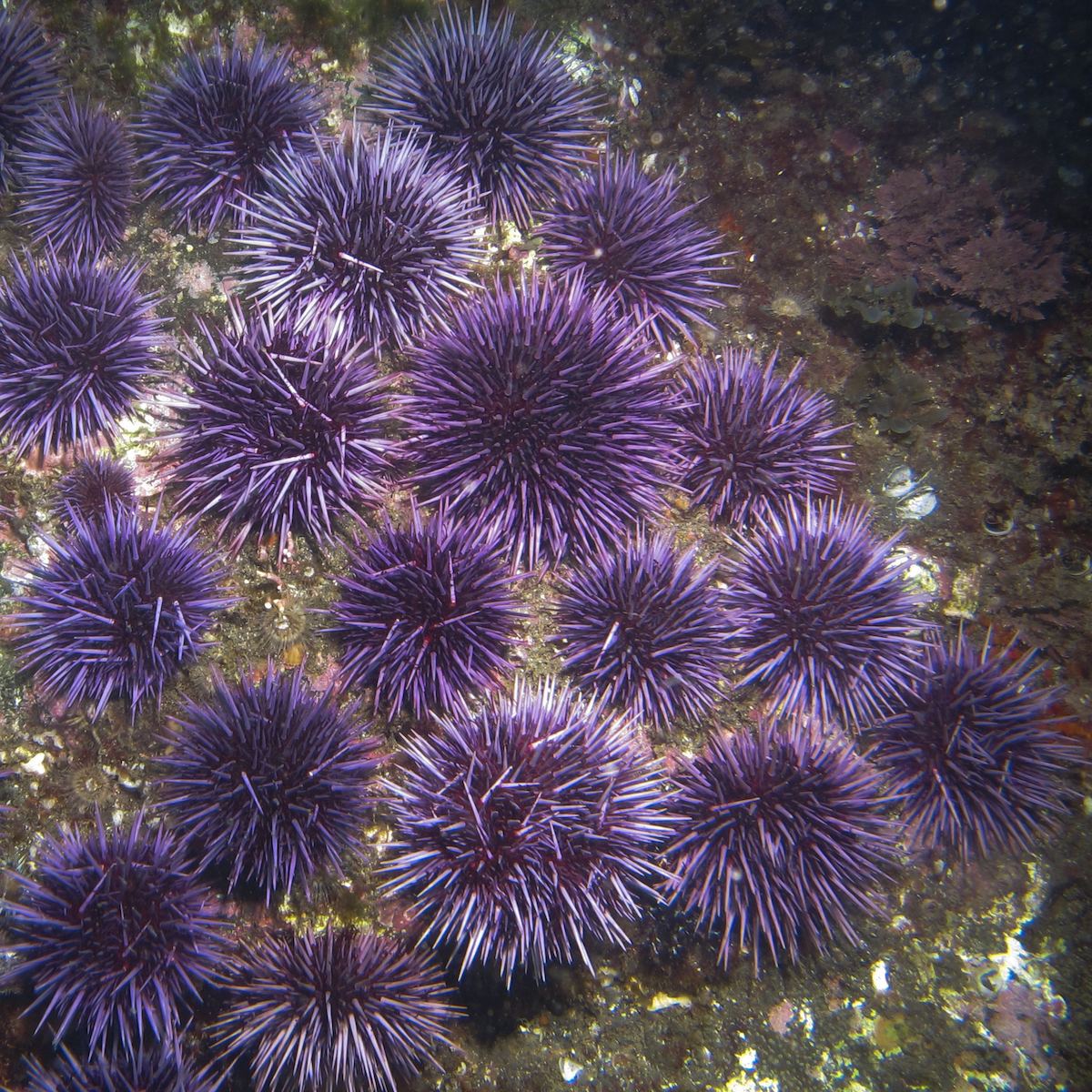
Climate-driven changes like those on the North Coast are leading to a massive die-off of kelp forests not only in California, but in places like Australia, Norway and Chile. TNC is committed to leading the way to address this global conservation threat by advancing solutions for protecting kelp forests in California and around the world.

SHADOW SWIMMERS
Summer sun illuminates icy seas
Where seals carry fire in their hearts
Each journey is painted with bubbles and kelp
Across an endless horizon of dreams
Shadow swimmers
Harbor drifters
Deep divers
Fish lovers
Wave surfers
Ocean guardians
Oh, salty creatures of our planet—
Fragile, agile,
May you swim forever
Around our blue planet, our bronze sun.
by Karen Lewis
California Poets in the Schools
Poetry and Prose generously donated by members of Writers of the Mendocino Coast. Learn more about this fantastic group!
Queen Bee
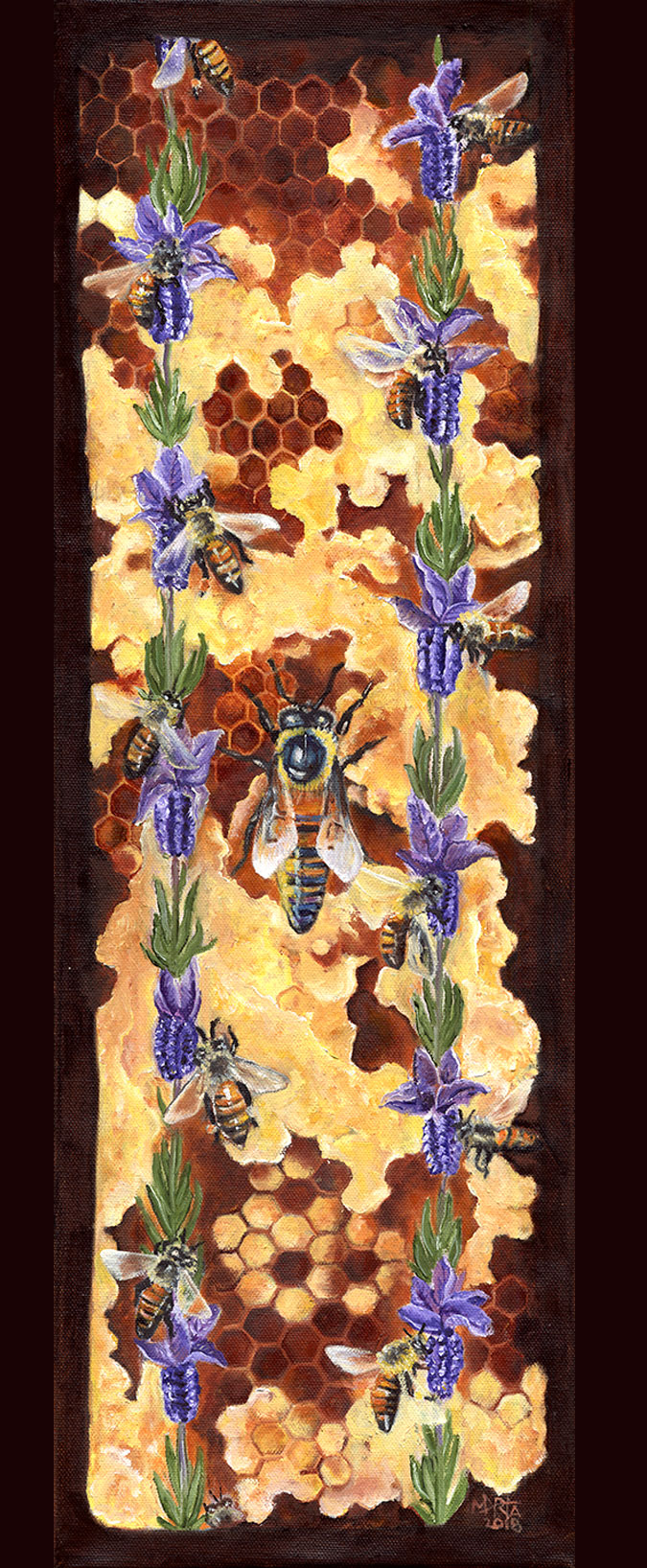
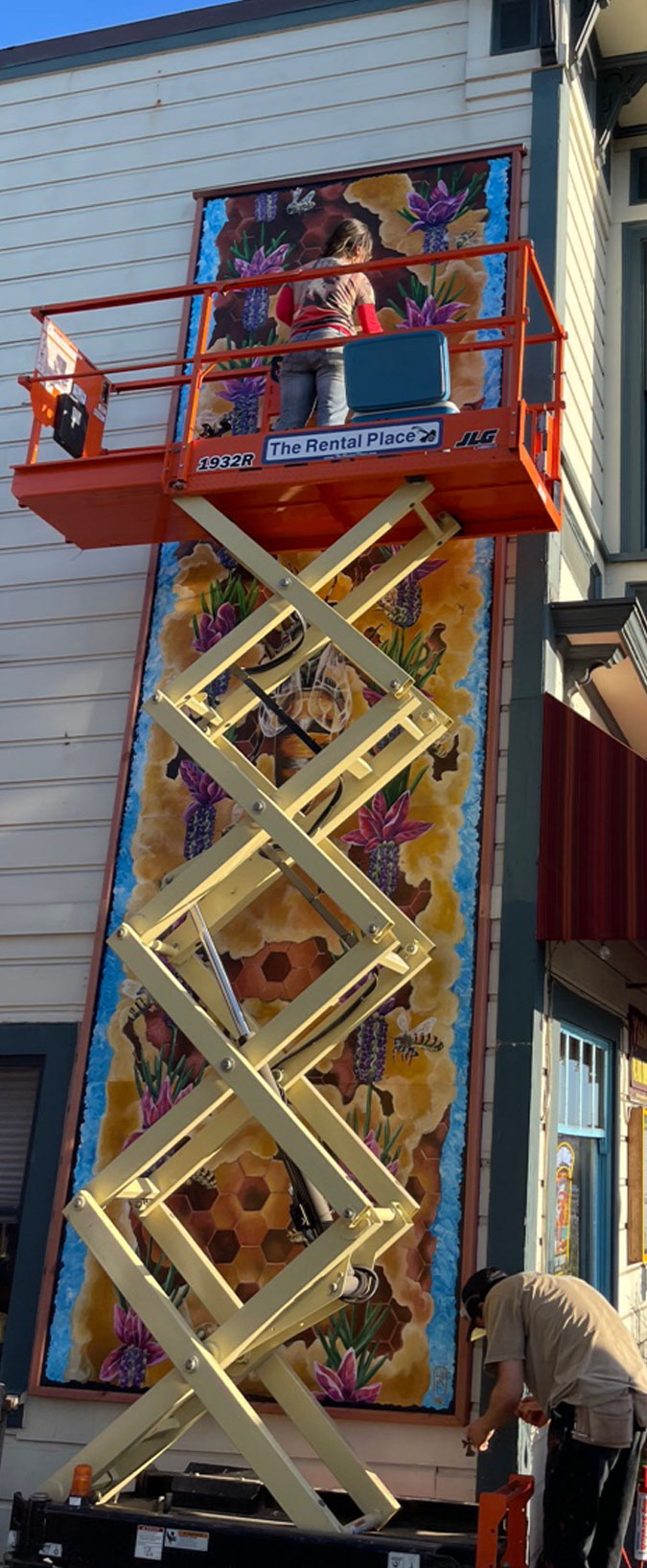

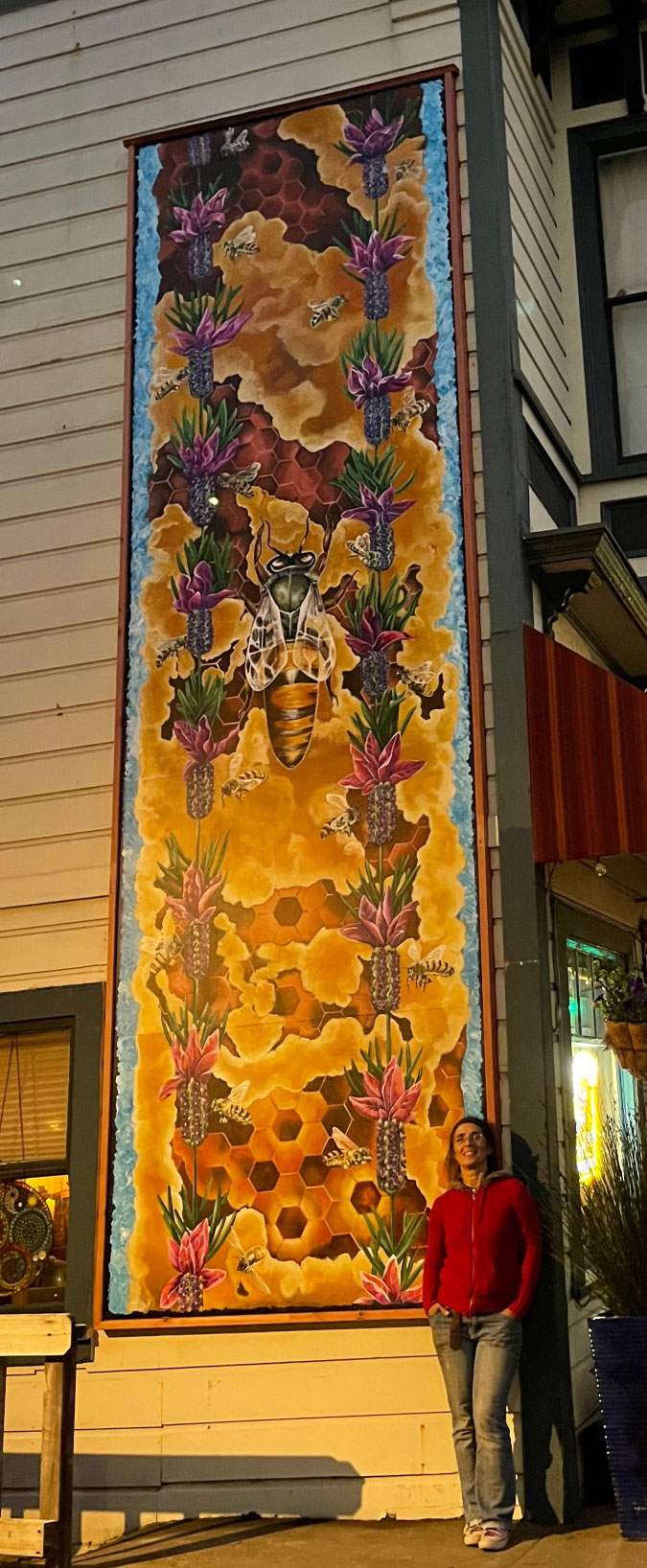
Title
Queen Bee
Artist: Marta Alonso Canillar
Location: 418 N Main St. on the north facing wall of Mayan Fusion
About The Artist
Marta moved to the United States from Spain when she was 21 and eventually found her way to Mendocino in 2001. Like many artists, she feels like her artistic journey is intrinsically tied to her journey in life. It’s a journey to find the courage to overcome all manner of insecurities and obstacles to be an artist. She found an inspiring mentor In 2014 when she took an oil painting class with Cynda Valley, a Willits artist at the time. She describes the experience as “uniquely heart and soul opening.” Cynda taught her the technicalities of oil painting but also encouraged her to look at her art as part of her self, and extension of her being, and to confidently experiment and explore. Marta clearly has a gift for drawing inspiration from the world, colors, shapes and patterns around herself. She is drawn to portraits, with a strong connection through the eyes, rural settings, farm animals, old barns, bees, hearts and peeling walls and rusty elements, dreams and made up realities. Her current area of unexplored curiosity is assemblage of oil portraits and sparkling encaustic relief.
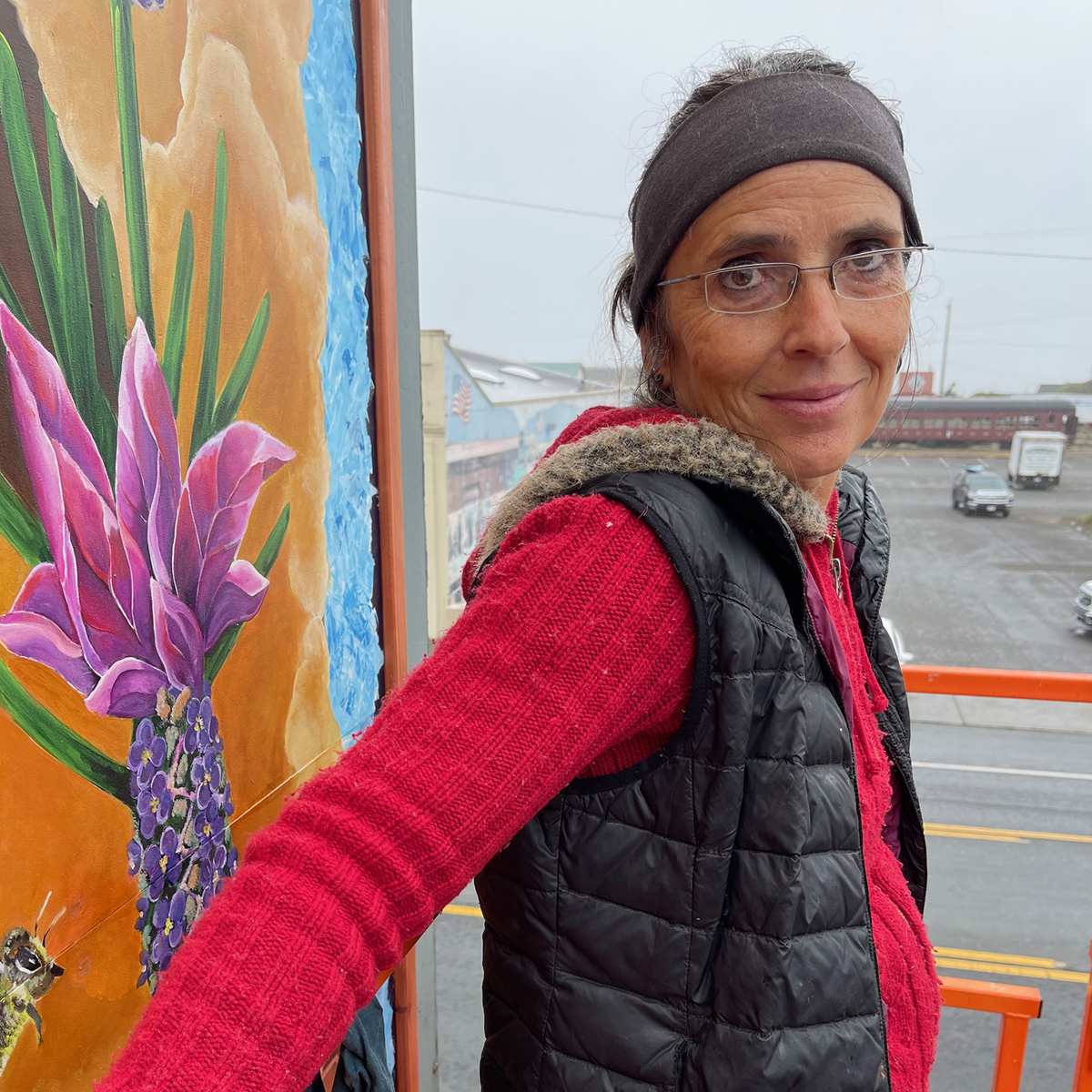
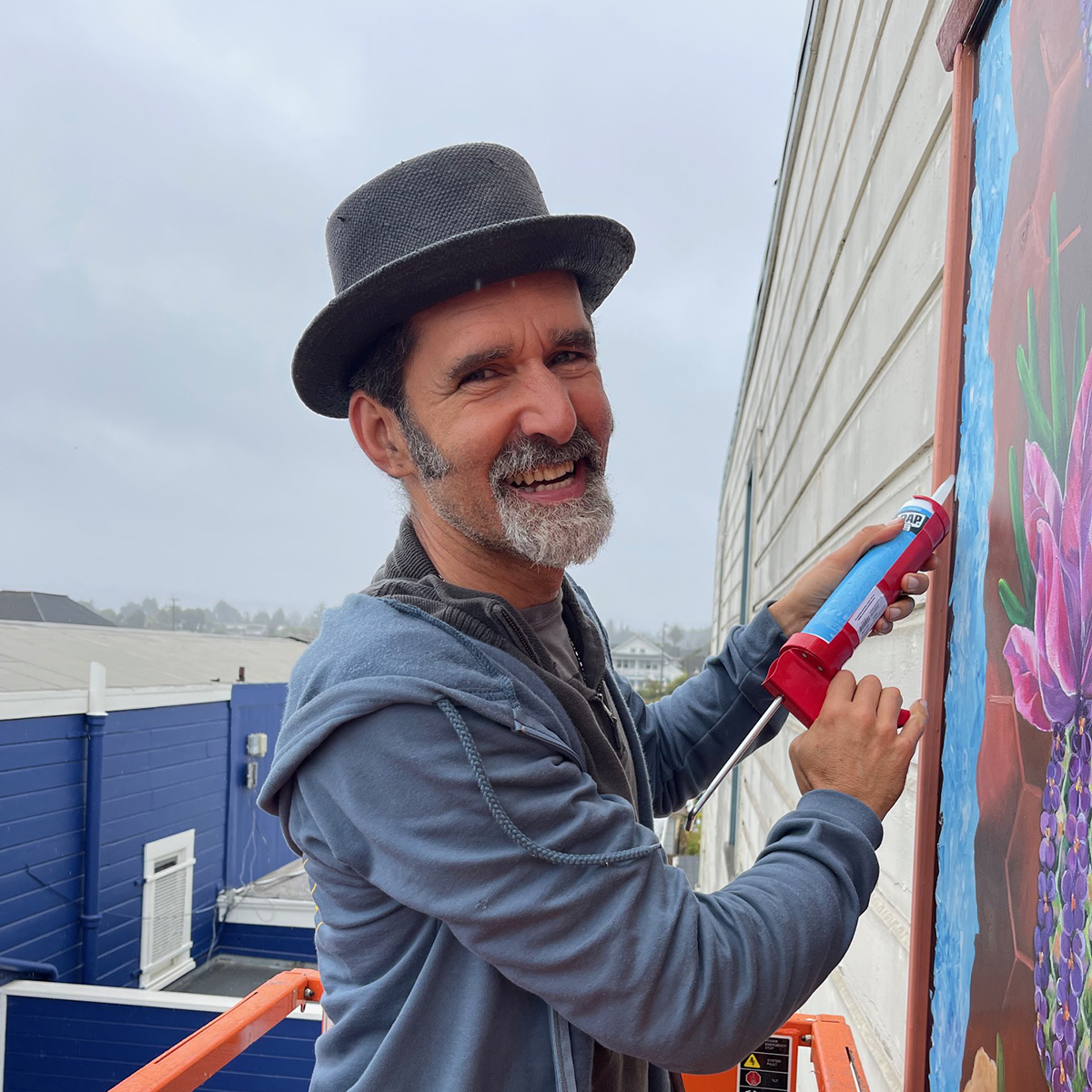
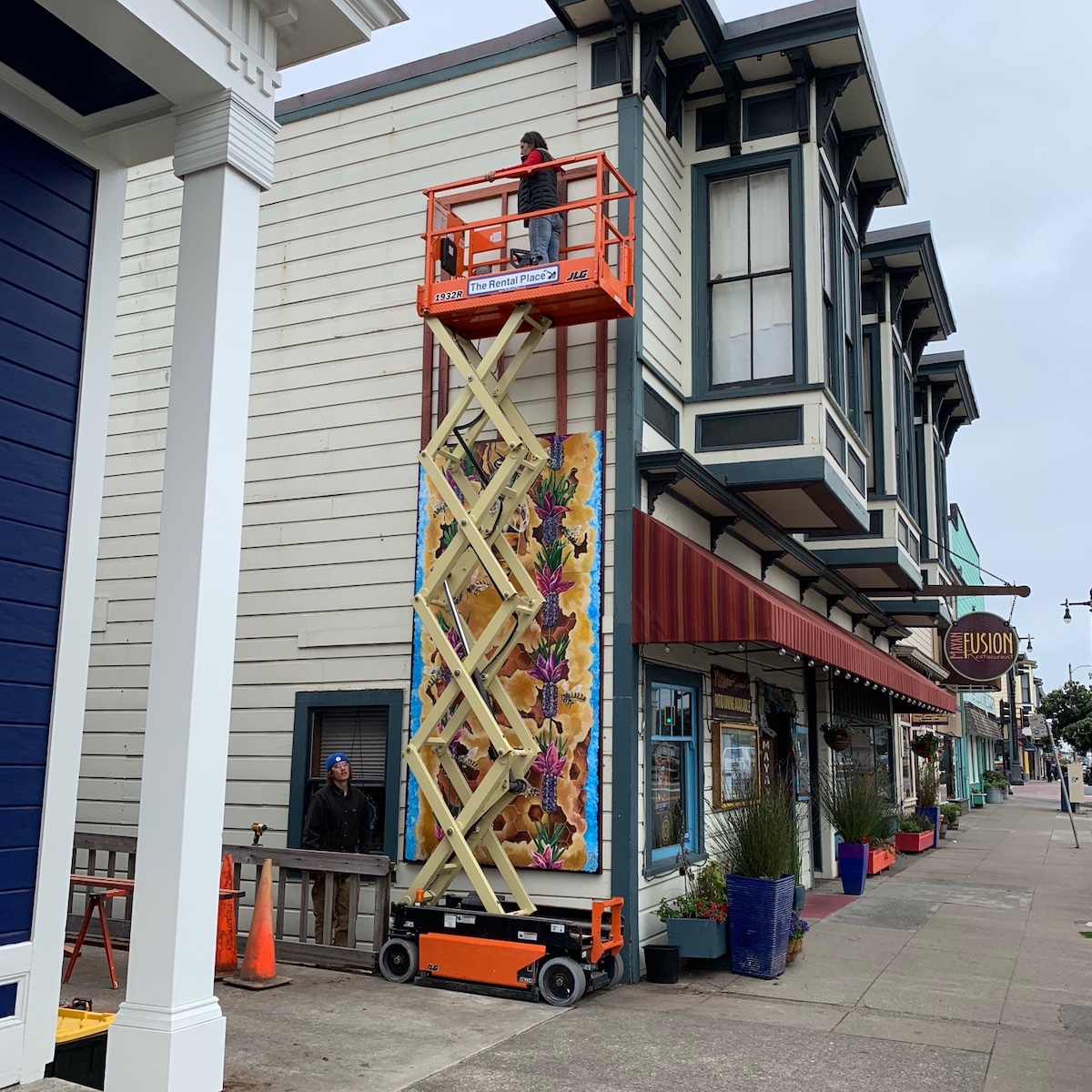

Inspiration for this installation
One in ten pollinating insects is on the verge of extinction, and a third of our bee and butterfly species are declining. We want to raise awareness through the power of art and honor thees pollinators.
Did you know that Fort Bragg was the very first official Bee City USA in California? We couldn’t bee prouder.
If you’d like to know more about supporting pollinators and invertebrate conservation, I recommend you start by checking out Xerces Society.
Protean Forms
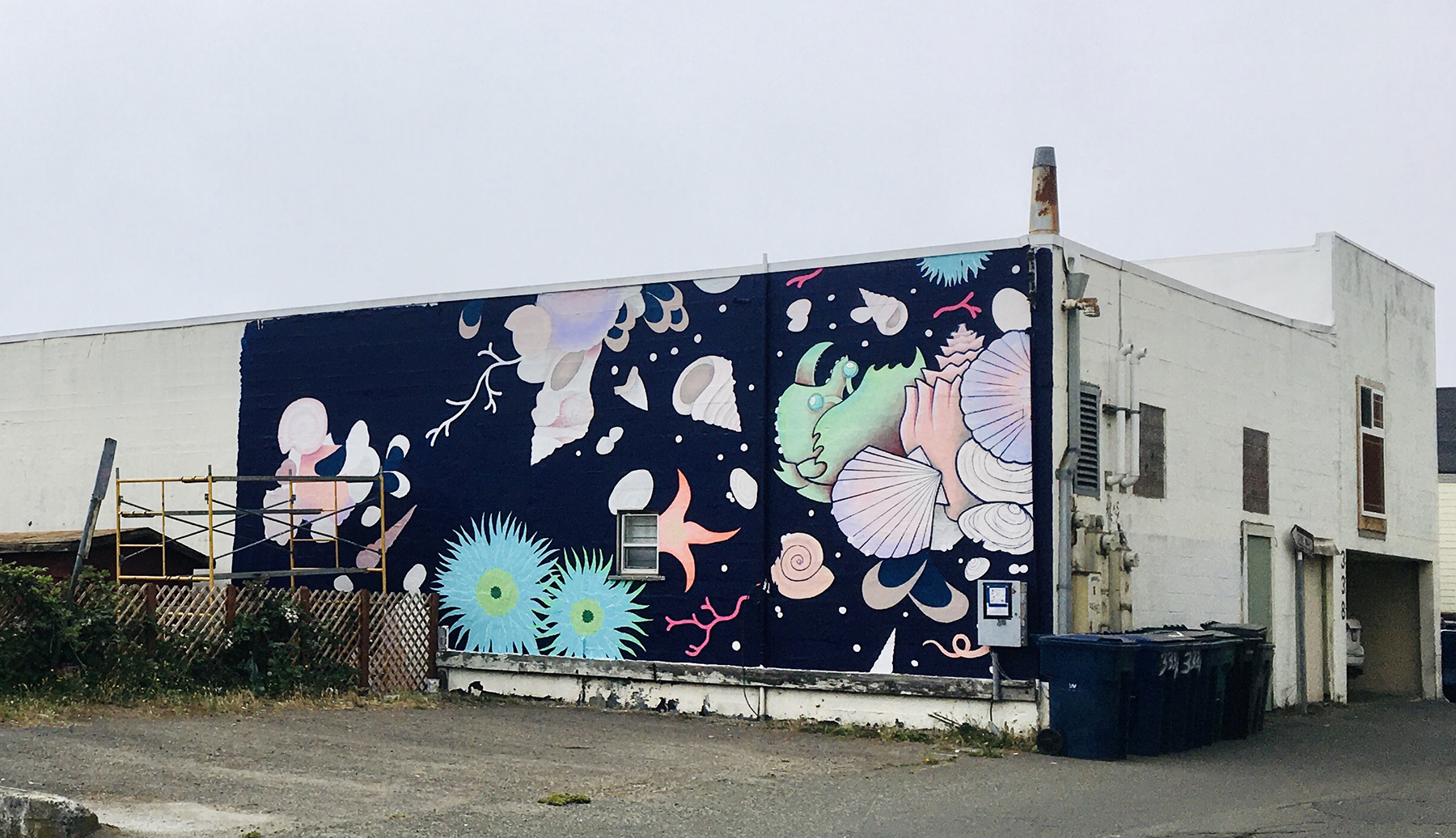
Title
Protean Forms
Artist: Derek DiOrio
Location: The alley behind 300 N. Main Street (go past the Rhododendron)
This mural is in progress. If you stop by on a sunny day you might be able to catch Derek at work.
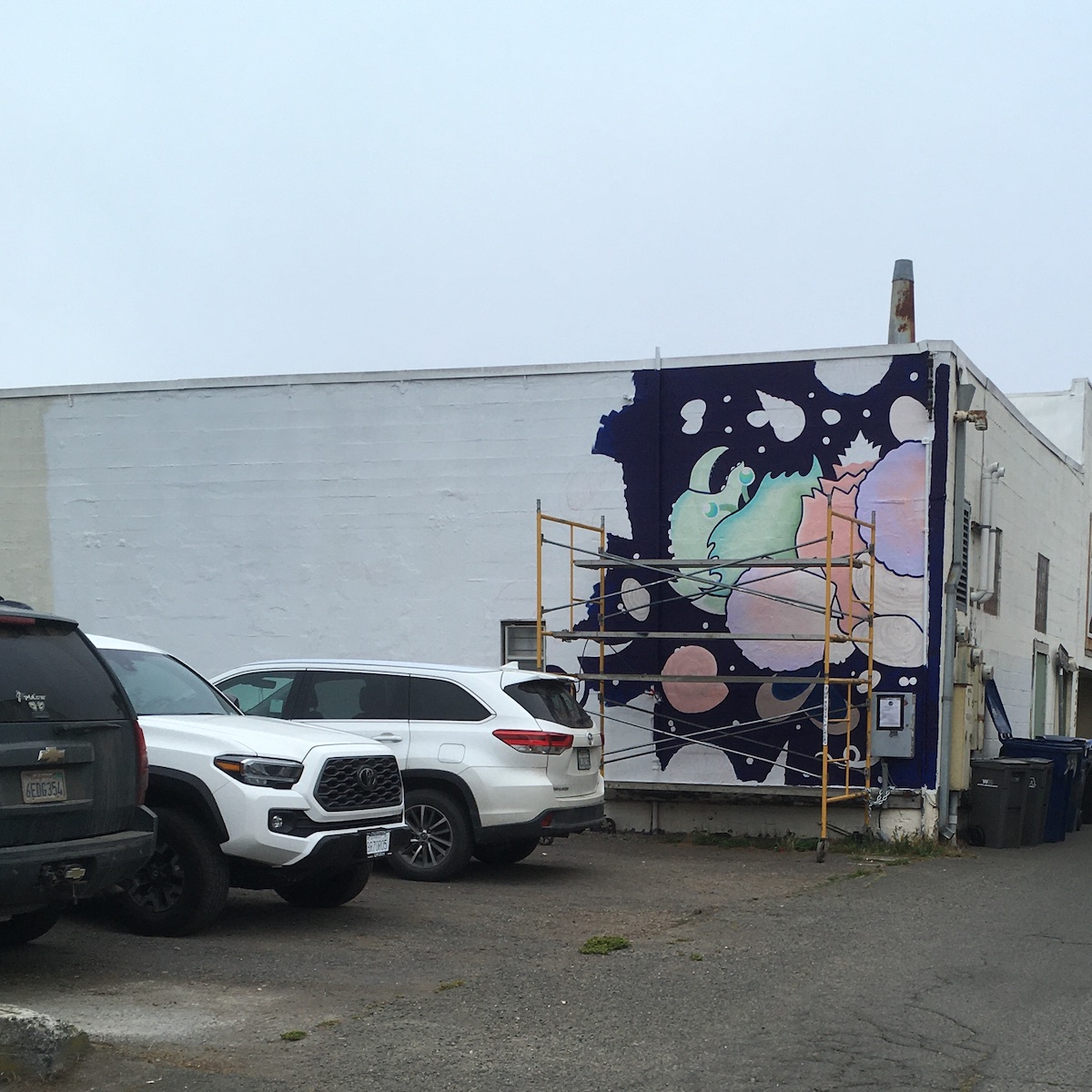
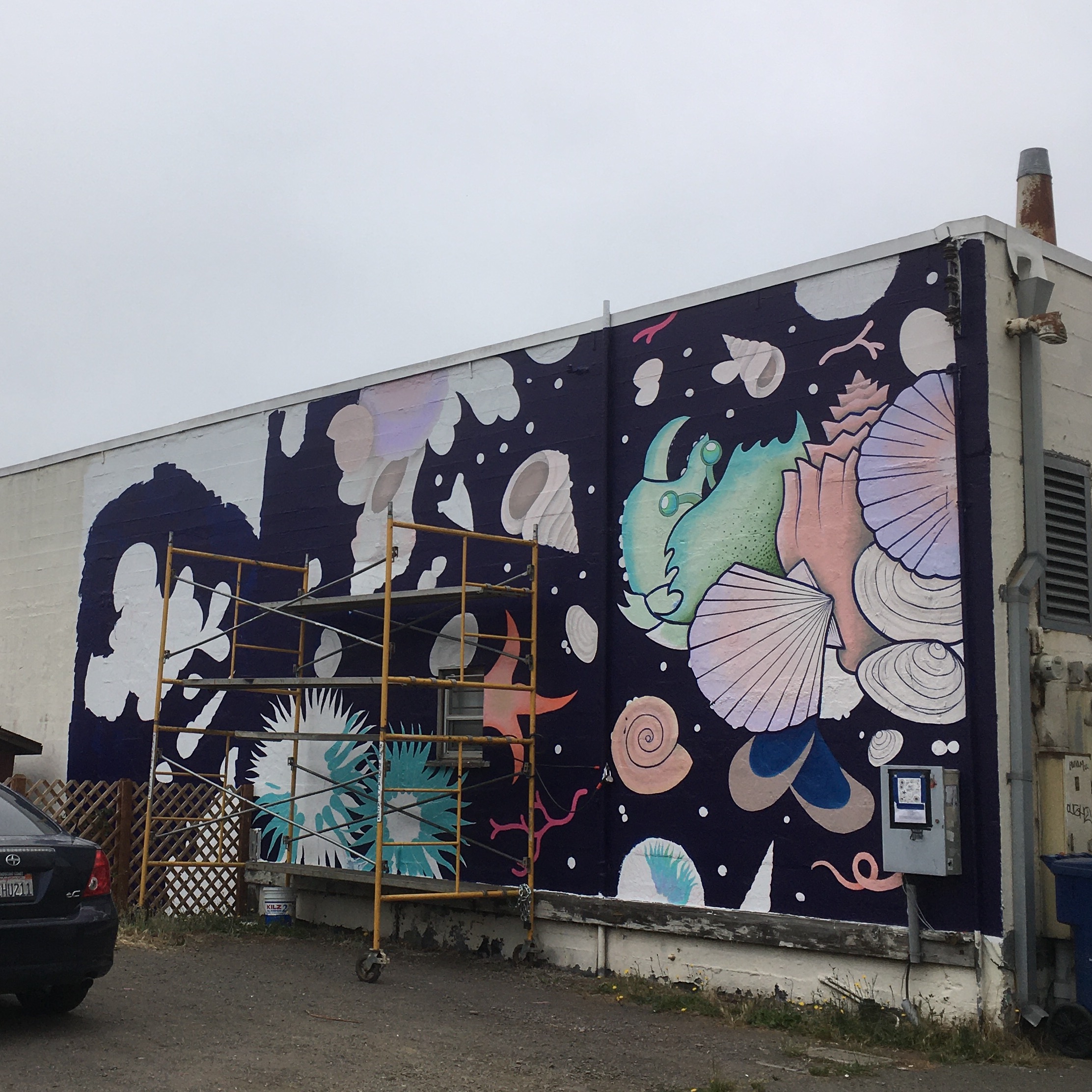

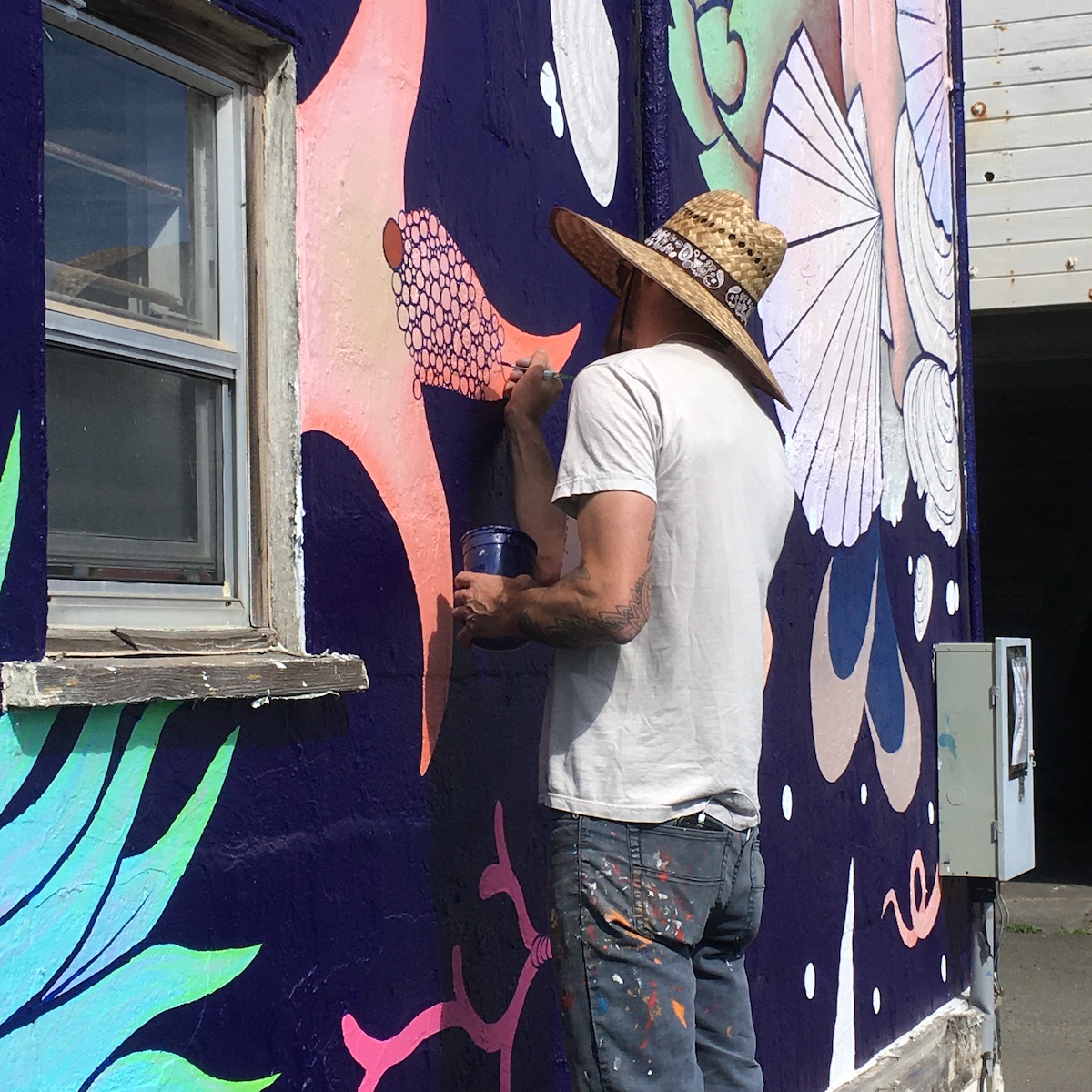
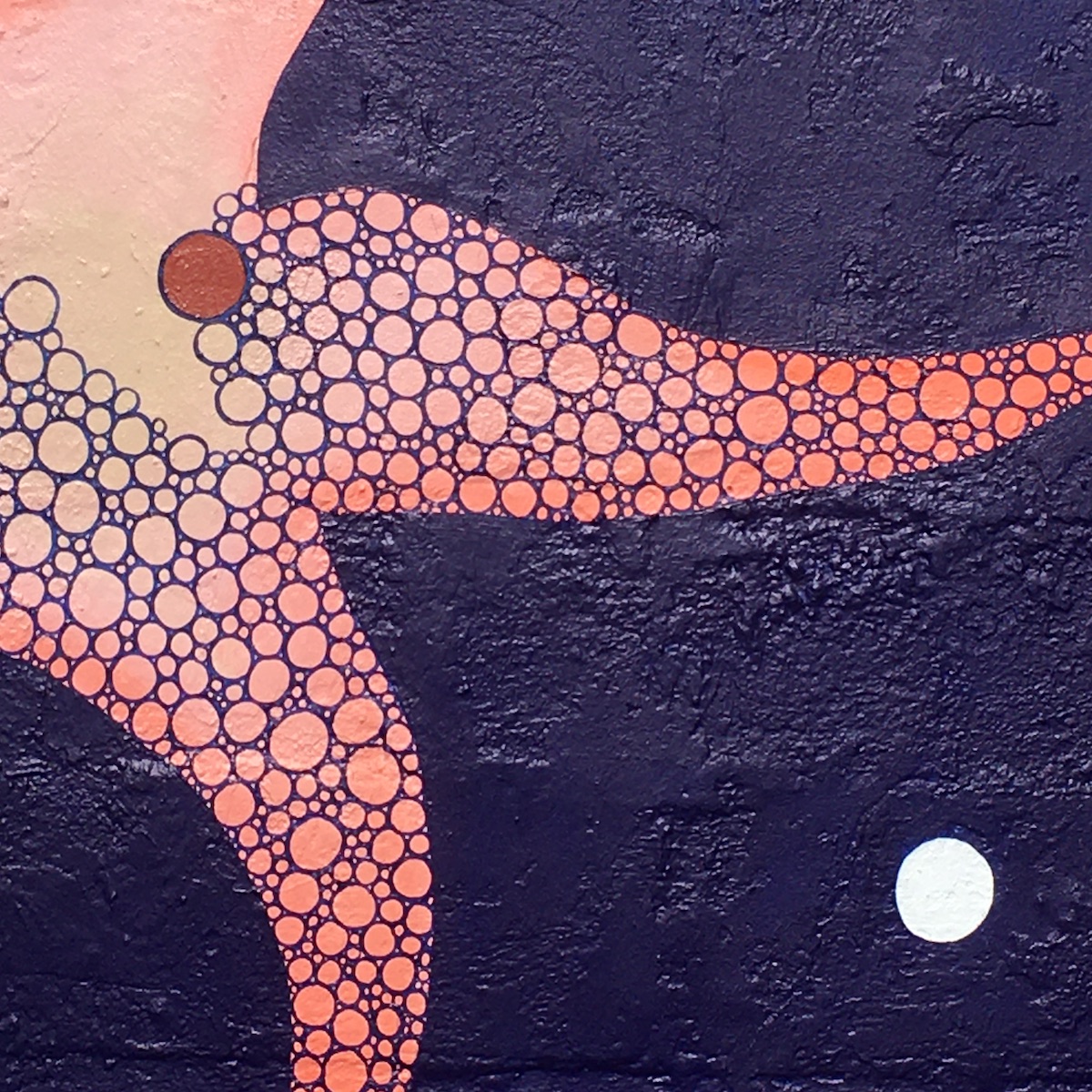
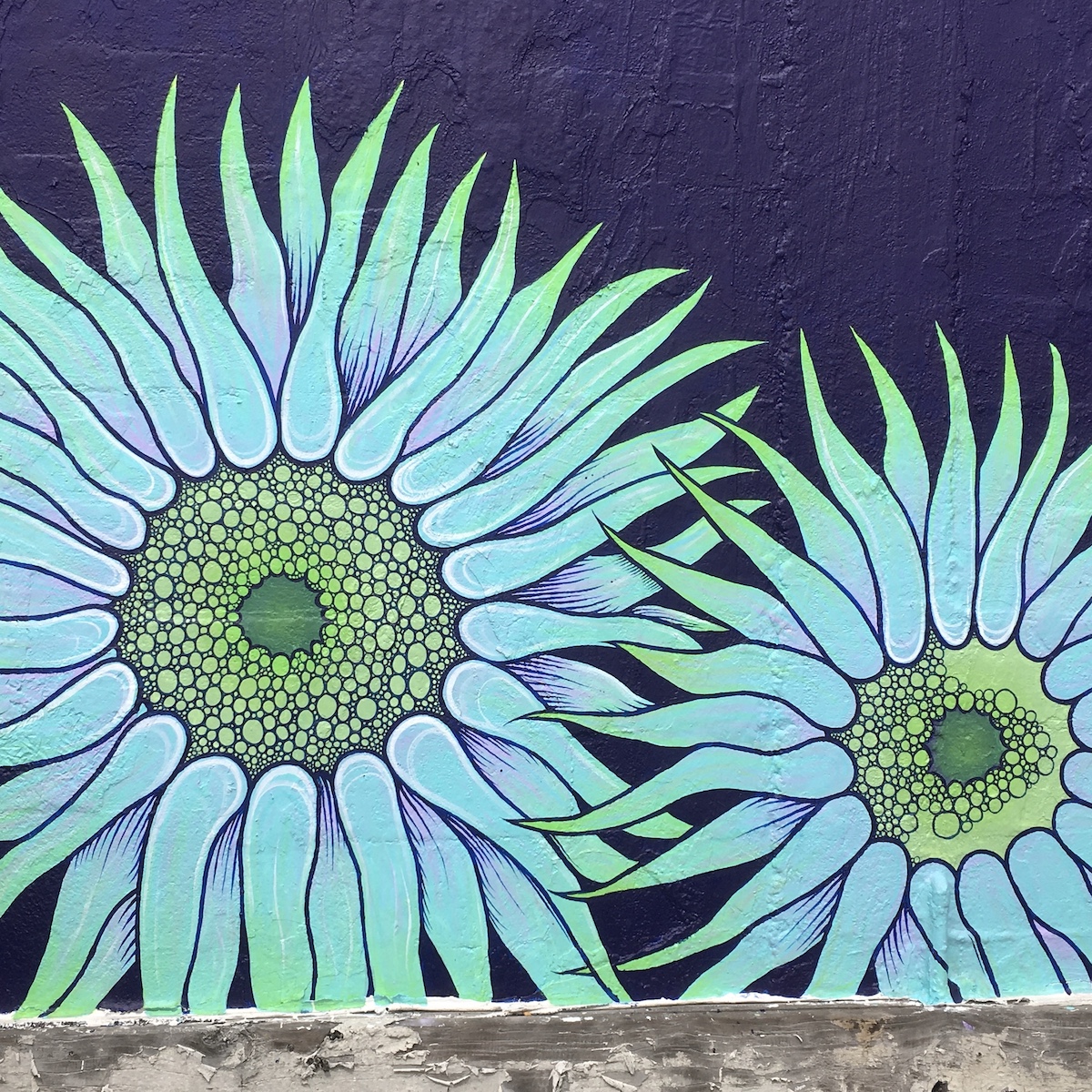

Inspiration for this installation
Derek had his eye on this wall for ages before he got the chance to cover it in minutely detailed sea life.
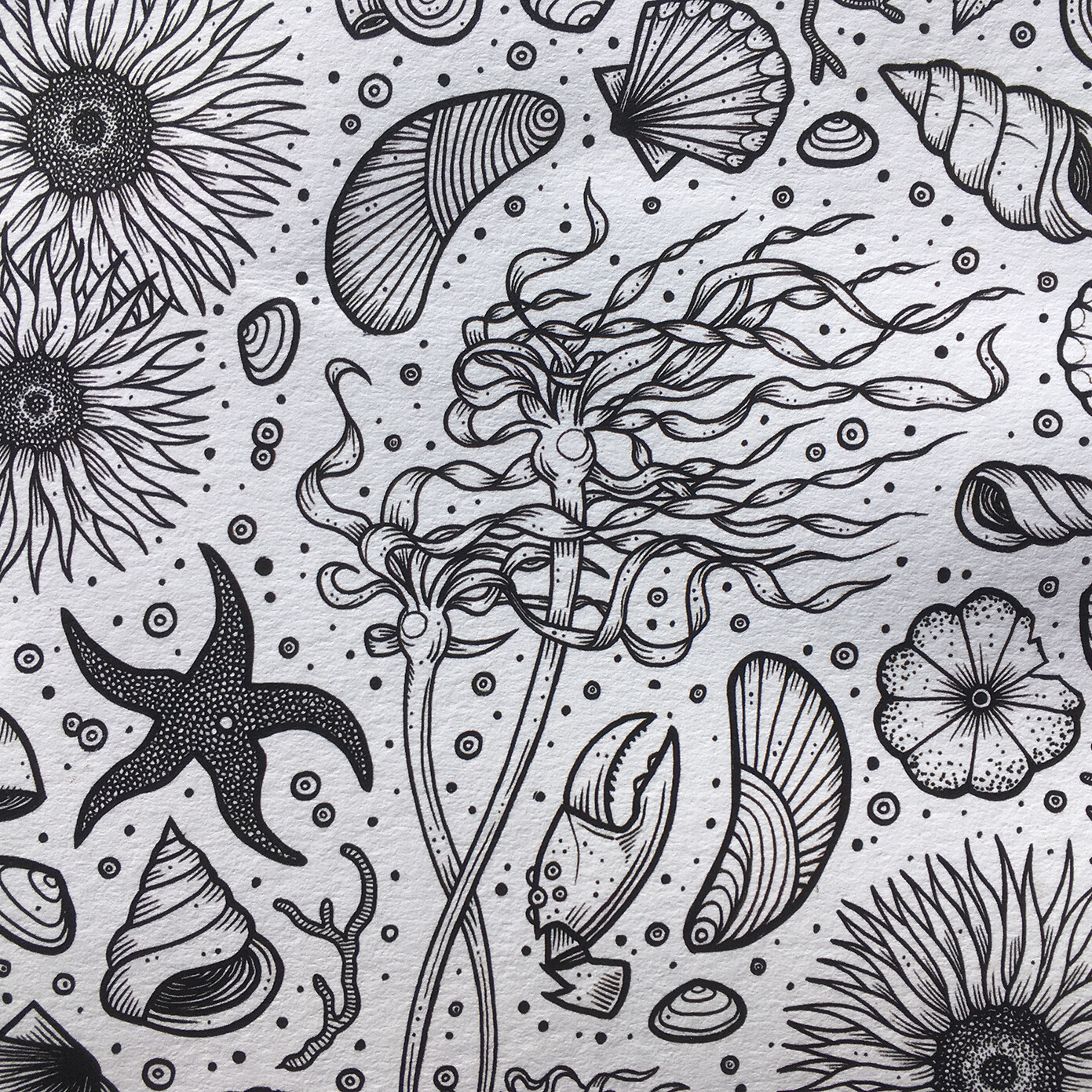
Sunlit Redwood Forest
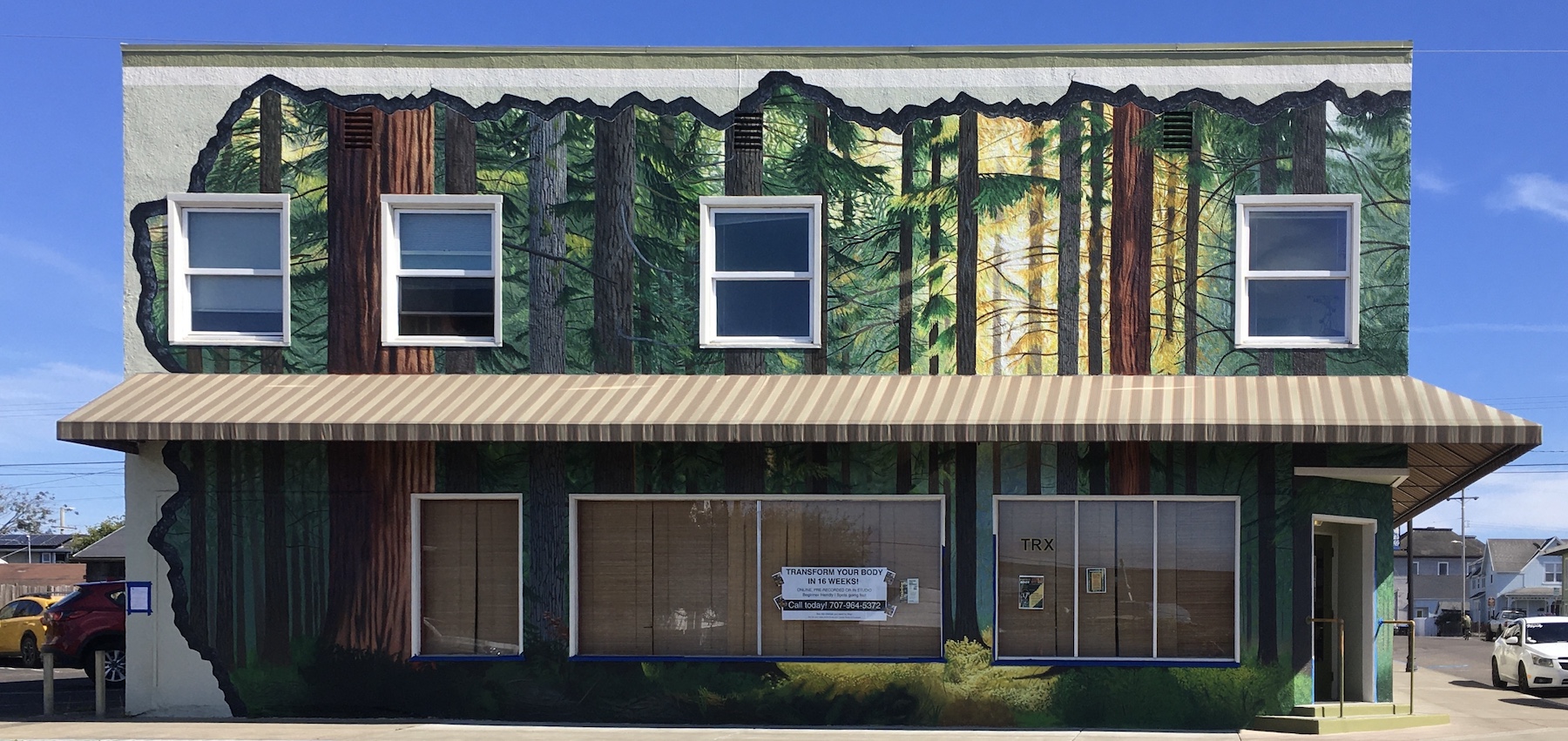
Title
Sunlit Redwood Forest
Artist: Ryan Grossman
Location: 301 E Redwood Ave.
At the Forrester Building
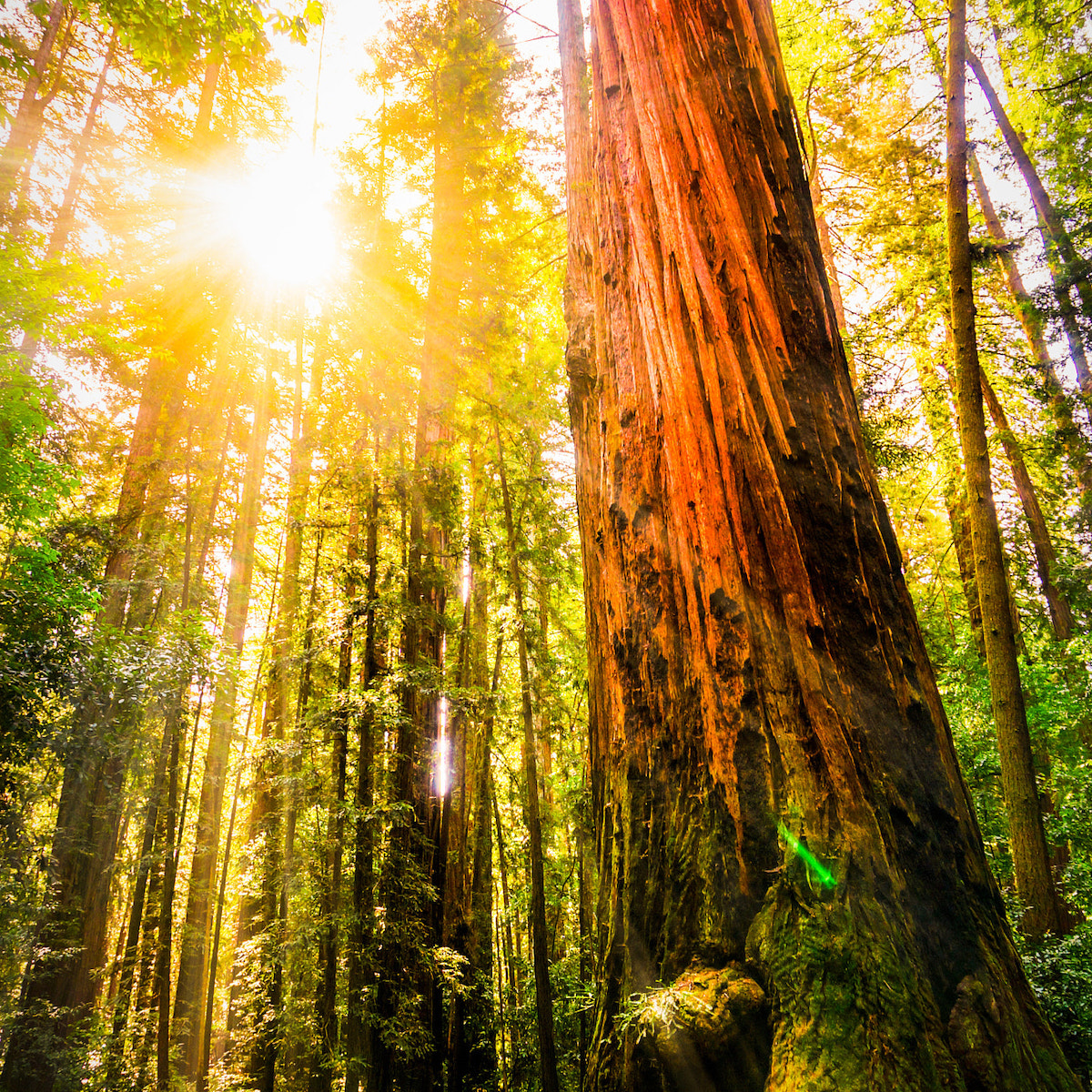
Inspiration for this mural
As I considered how I was going to transform this wall I knew that I wanted to capture more than just the look of trees. I wanted to capture the experience, the awe that comes from gazing upwards in a thriving forest and seeing sunlight streaming through the branches. I wanted to capture the acid green backlit leaves, the welcoming quiet, the feeling of lushness and abundance. Nature is inspiring, both in a pristine state, but also in a state of recovery. I see great beauty and hopefulness in the process of re-growth, decade upon decade, century upon century. It was great to work with RFFI and learn more specifics about mixed-age forests and their work on behalf of our local forests and community. All of the trees, plants and details of this mural can be found in RFFI’s forests.” – Ryan Grossman
Huge thank you to our co-sponsor The Redwood Forest Foundation Inc.
In the late 1990’s a diverse group of community leaders from Mendocino County came together with a vision for local control of a natural resource on which the community depends. Redwood Forest Foundation, Inc (RFFI) was the first non-profit created to own and manage timberland for the benefit of neighboring communities. In 2007, RFFI purchased Usal Redwood Forest, 50,000 acres of working timberland, and placed a conservation easement on the property assuring it would remain as a single parcel of forestland. They immediately began the process of restoring forest structure and habitat, responding to climate change through carbon sequestration and reconnecting community members to the role and responsibility of managing a forest. It has not been without its challenges, but 15 years later, they are harvesting annually to support local employment, restoring watersheds and improving salmon habitat and selling carbon offsets into the California Cap and Trade market to support debt repayment. To find out more go to www.rffi.org
From RFFI
Redwood Forest Foundation, Inc. and Usal Redwood Forest seems to be one of the best kept secrets in Fort Bragg, which is one of the reasons why we partnered with the Alleyway Art Project, Ryan Grossman, and Cynthia Sumner on the Sunlit Redwood Forest Mural. This
stunning mural is certain to inspire passersby to reflect upon and perhaps renew their personal connection with the forests of Northern California.”
Restore · Respond · Reconnect
Installation


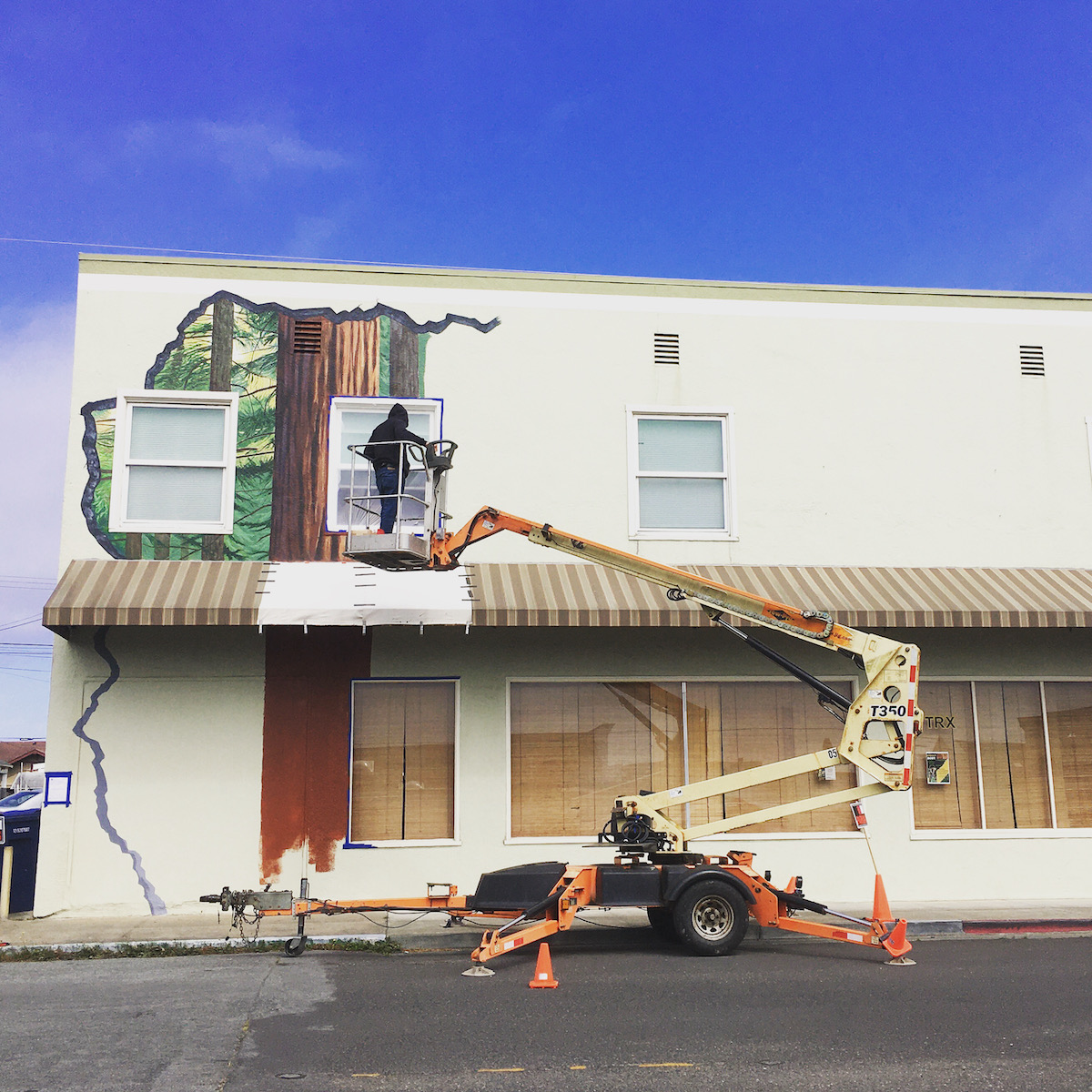


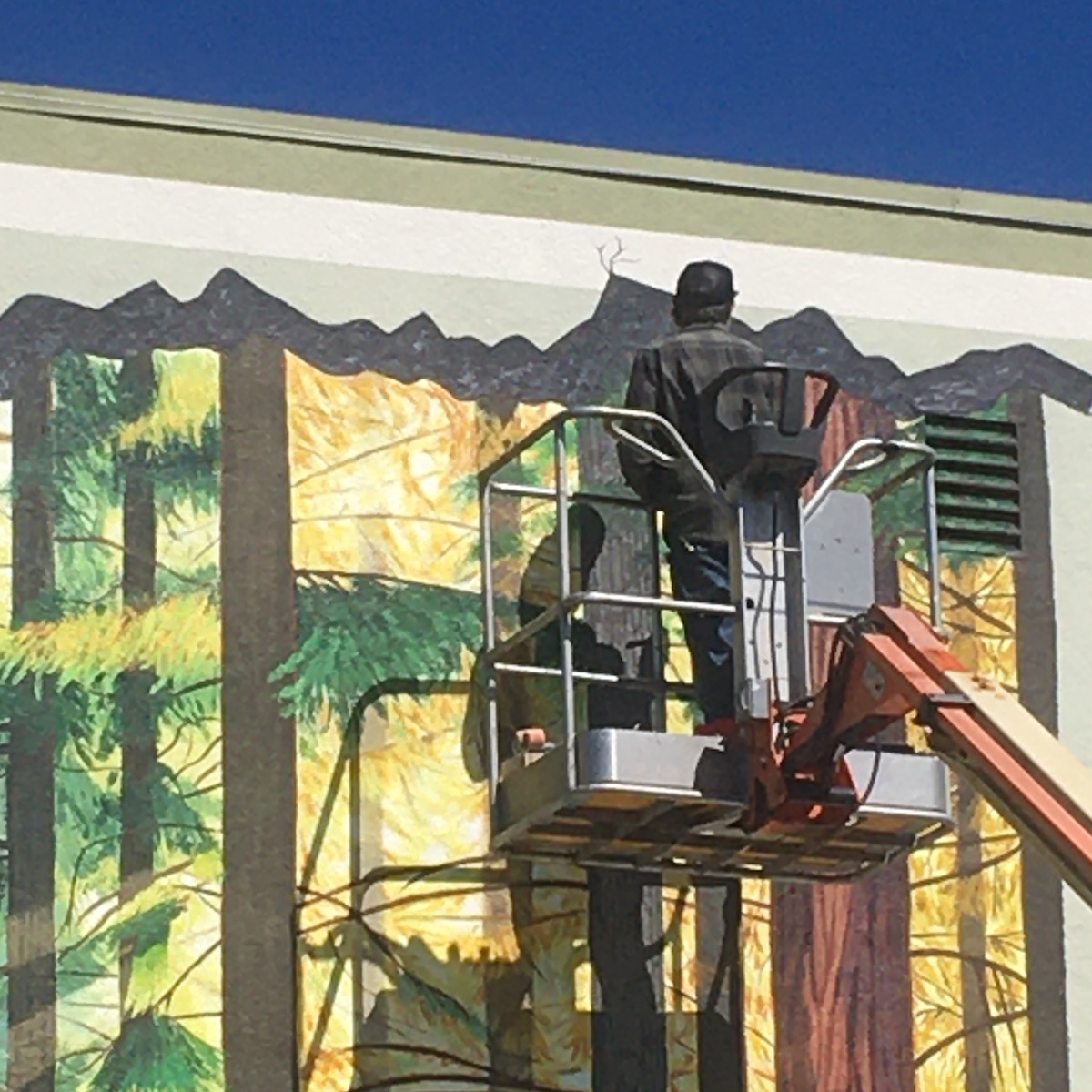
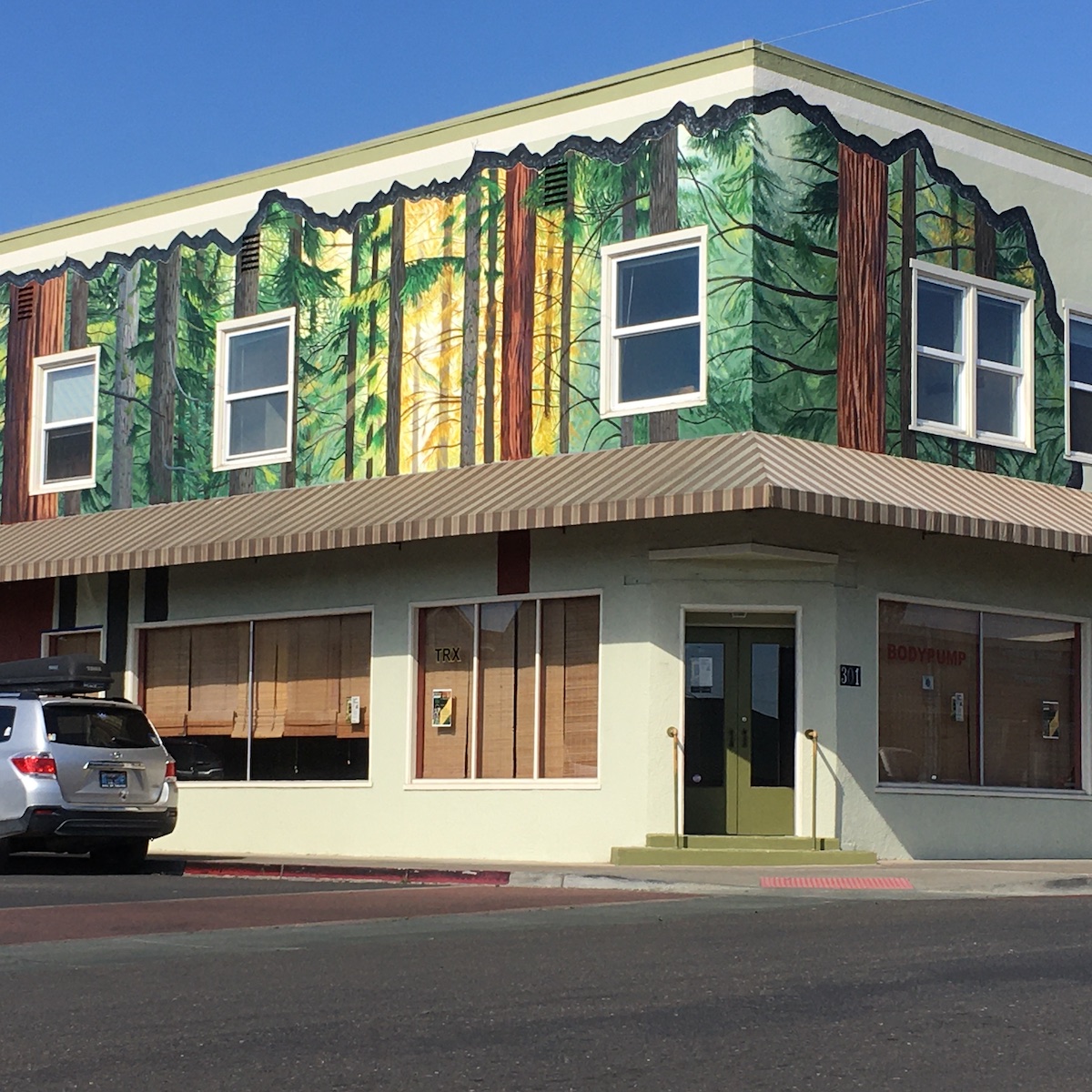
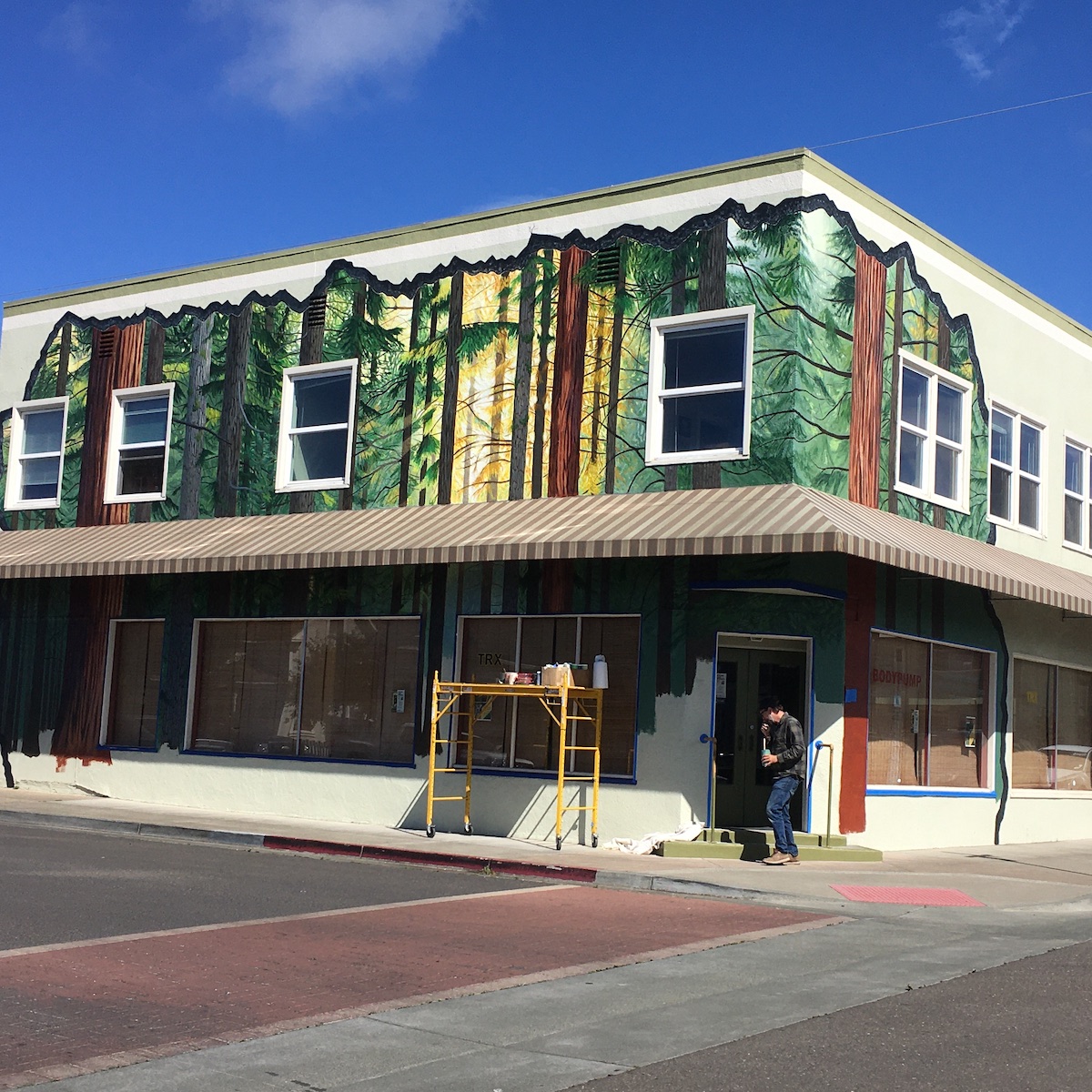
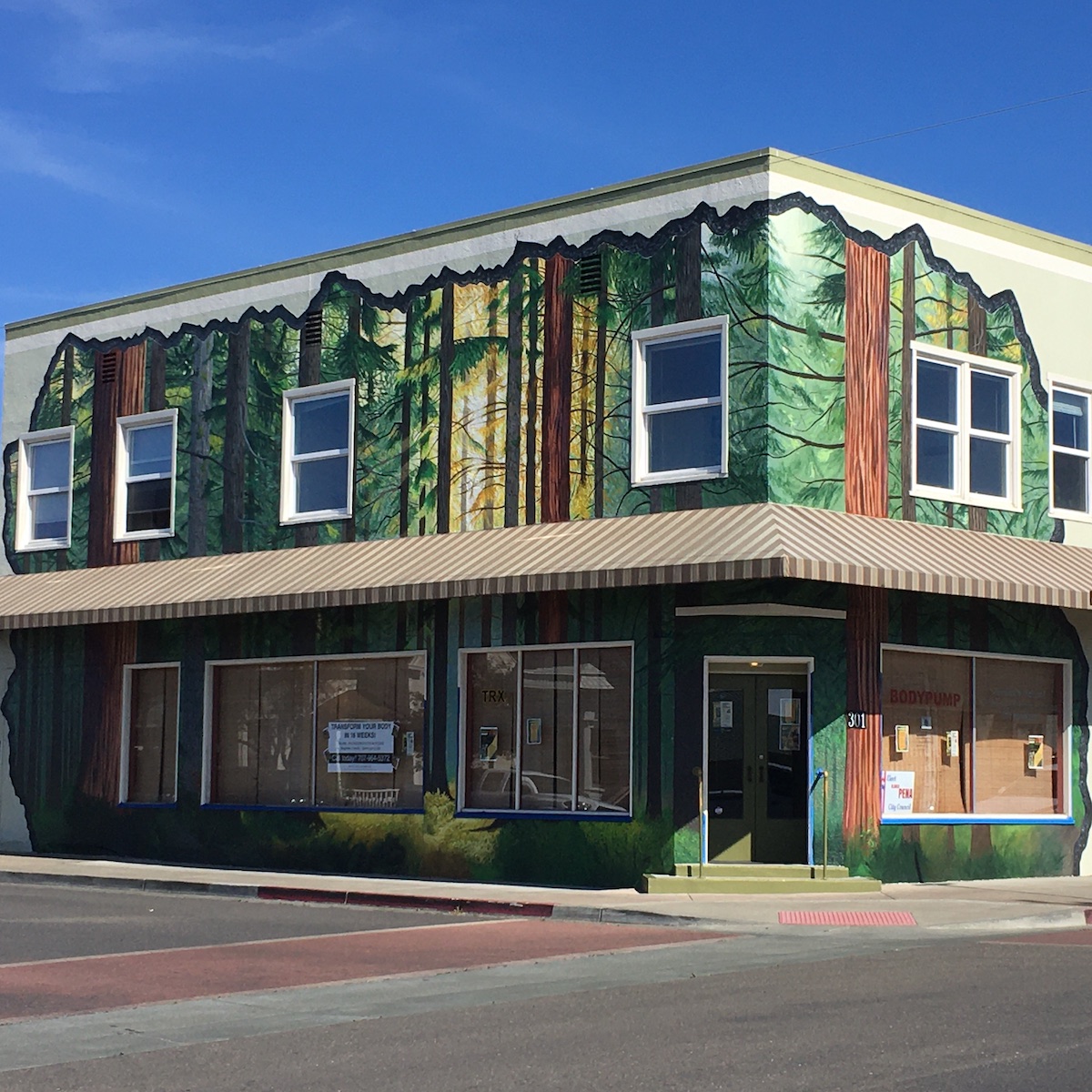
About the Forrester Building
Location: 301 E Redwood Ave.
In October of 2019, artists Randy Tuell and Cynthia Sumner purchased a rather neglected building on the corner of E. Redwood & McPherson. Their intention was to create a place for artists to come together, to work and to live in an area that already actively supports the arts. The Forrester Building, (named after Cynthia’s grandparents), has now become a giant canvas and an example of the transformational power of public art.
In early 2022, Cynthia launched Art Scene Studios, a co-working creative space in one of the large street front units. (309 E. Redwood Ave) Here, like-minded artists who enjoy working in the company of others are welcome to share their creative process with passersby. Keep an eye out for Open Studio dates and other events, and take a peak inside.



In the Redwoods
In the deep dimness, a frantic scramble
between wide trunks, over moist musky duff,
under snagging huckleberry.
Brittle brown redwood needles catch, beetles scuttle,
phallic boletes press through leaf litter,
fruiting bodies crisp or ooze, larvae-crawling rotten,
a slug tucks in the cavity it’s chewed.
Okay. Now stop. Breathe out.
Distant surf. In the dank air, around and under,
a slow thrum, the dark cello tones of plucked web:
translucent spider, mycorrhizal pathway, fungal filaments.
Look up.
One hand on old bark, the tree reliable,
follow the trunk. Up and up. Through
stretching acid-green foliage.
To where branches firework into blue arcing sky and
sun casts blinding joy shafts.
Here is where air is born.
By Ericka Lutz
Poetry and Prose generously donated by members of Writers of the Mendocino Coast. Learn more about this fantastic group!
Redwood Frolic
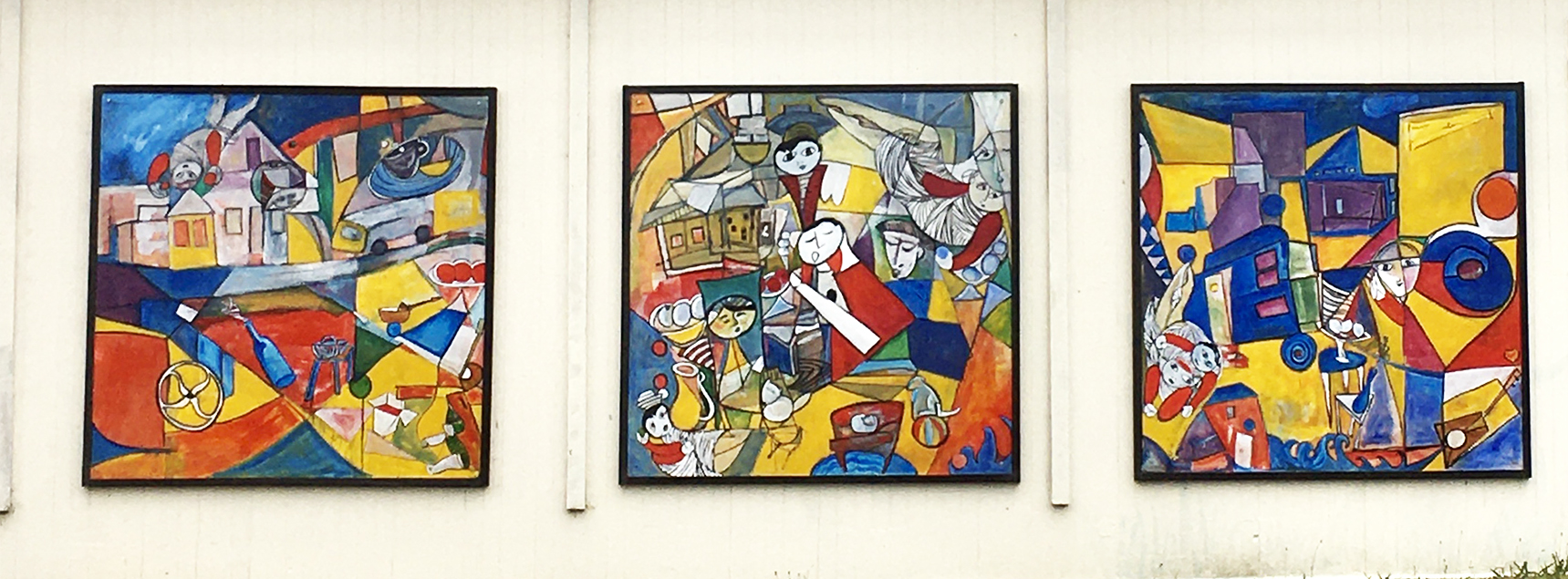
Title
Redwood Frolic
Artist: Sally Rodriguez
Location: 221 East Redwood Ave.
Inspiration for this installation
Sally had been dreaming of painting this triptych for years before everything fell into place with the Alleyway Art Project. She loved the rich and somewhat jumbled history of this neighborhood in Fort Bragg, with its many businesses, cultures, and local characters in constant flux over the years. The Little Cup and Larry Spring buildings are some of the oldest buildings in town – along with the Golden West Saloon.
Always a sucker for nostalgia, Sally delighted in depicting a chaotic and festive mashup of history from many time periods, lost treasures, found items, and as many references as she could fit.
Drifting across all three murals are Sally’s signature angels, often depicted holding orbs representing the spheres of the world, the heavens, all knowledge, and mystical interconnectedness.
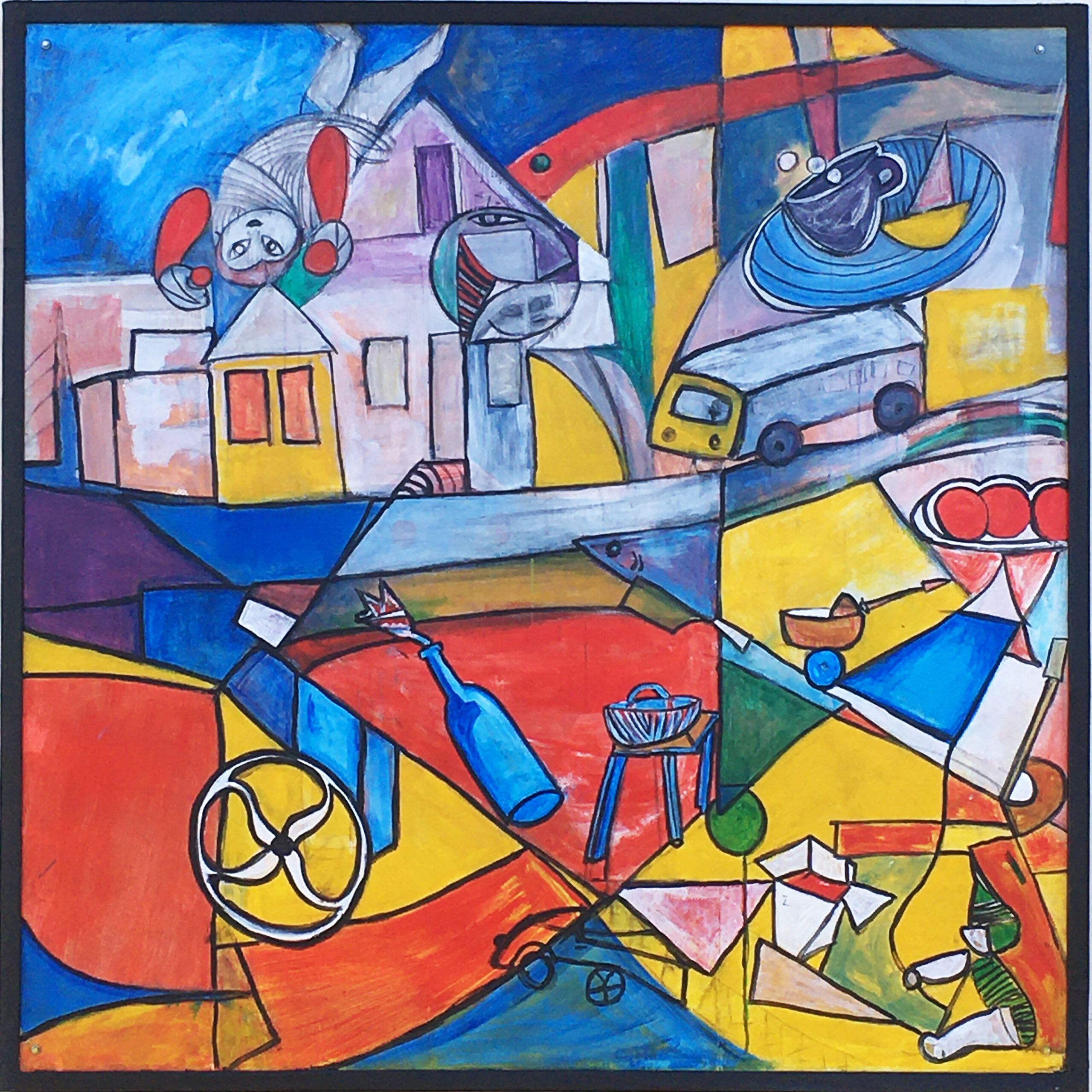
The wheel in the lower left is from the vintage letterpress at Little Cup Ceramics.
The molotov cocktail to the right is a reference to one thrown during a protest of logging that happened in the 80’s.
There’s a greyhound bus in the upper right corner under the cup. There used to be a greyhound bus station across the street from this mural.
The Chinese food box is from Lee’s Chinese, kitty-corner from the mural.
The building holding the mural used to be a Finnish fish restaurant, hence the fish head and butcher knife in the center of the piece.
The bowl of fruit on the far right middle is an homage to Picasso.
The blue basket on the table is going to get filled with laundry.
The upside down angel is Henry, the Alleyway Art Project director Lia’s son who visited Sally while she was painting. The orb the little angel is holding is a reference to Larry Spring’s common sense physics. To learn more, visit the Larry Spring Museum, two doors up Redwood Ave. from this mural.
The water droplet with a face is an abstract references to faces seen through the wet windowpane of the fish shop from years ago.

The Gypsy wagon puppet theatre in the upper right corner is from the Larry Spring commons
The angel with orbs is an homage to Picasso, but Sally includes angels with orbs in many of her works. The orbs represent the mystical connection of universal heavenly spheres.
The Chinese man reading a book is a reference to an incident when Chinese locals were nearly run out of town but the sheriff intervened to protect them. The “reason” given was because the Chinese community was essential to the functioning of daily life in town.
The wave in the lower right corner is a reference to the local beach and coast.
The woman in the yellow shirt reading a book is in reference to a book store that used to be where the grassy lot is now.
You might notice that right behind the man holding an ice cream cone with a lute tucked under his arm there is a tiny figure standing in a doorway. This is a reference to the early history of the Golden West Saloon as a house of fleeting pleasures.
As if to drive the point home, the angel being squashed under a carafe of ale is a reference to Fort Bragg’s history as a rather wild drinking town.
The three balls in a bowl is a Picasso reference – one of many.
The mid top left area shows boats in the harbor, above some harbor buildings – Noyo harbor was a bustling fishing and trading port back in the day before the fish stocks were catastrophically overfished.

In the bottom left corner there is the tail and head of a salmon.
Next to the salmon at the bottom of the painting is the harbor master’s office.
Person in the hat is a local kid from a photo Sally saw.
In the upper left is some neighborhood buildings, including the building directly across Redwood.
The yellow building in the upper right is the Larry Spring building, as seen from the alley.
The half-of-a-person on the far left is a stilt walker traversing the space between panel three and panel two.
In the middle of panel three is a table holding a bowl with blue lemons and a banana, right above a vase of lupines. The interesting shapes of the tables is a reference to the local Krenov School of Fine Woodworking.
The Angels with heavenly orbs make an appearance in this panel as well.
Red toolbox sitting in a doorway is a reference to the DIY construction of the town in its early days. If you have experience with some of the older buildings in town you will know that many are constructed with high-quality redwood lumber from the local mill, but they were often put together by non-professional builders so there’s some architectural touches that are quirky to say the least.
Sub Rosa
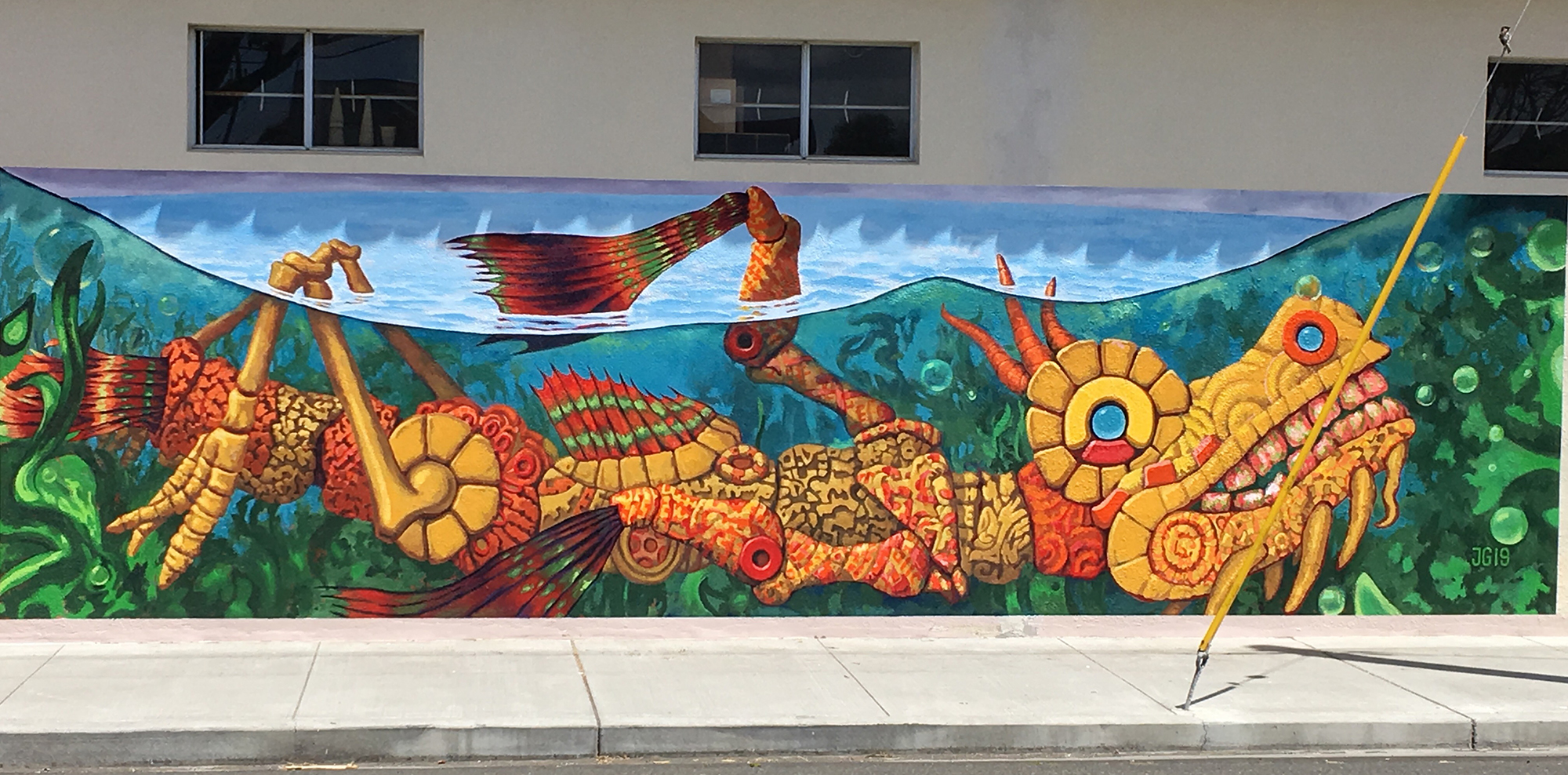
Title
Sub Rosa
Artist: Jason Godeke
Location: 400 E Laurel St. Fort Bragg CA, across the street from Bainbridge Park
Unlike many artists who start with a blank canvas, Jason Godeke designed Sub Rosa to complement, and respond to a pre-existing mural on the building. The Grey Fox mural to the right of Sub Rosa was painted by The Obanoth as part of a mural competition sponsored by the City of Fort Bragg. Due to the placement of the Grey Fox, there was a large section of wall that was un-decorated, and Jason wanted to fill it with something that felt dynamic, and alive.
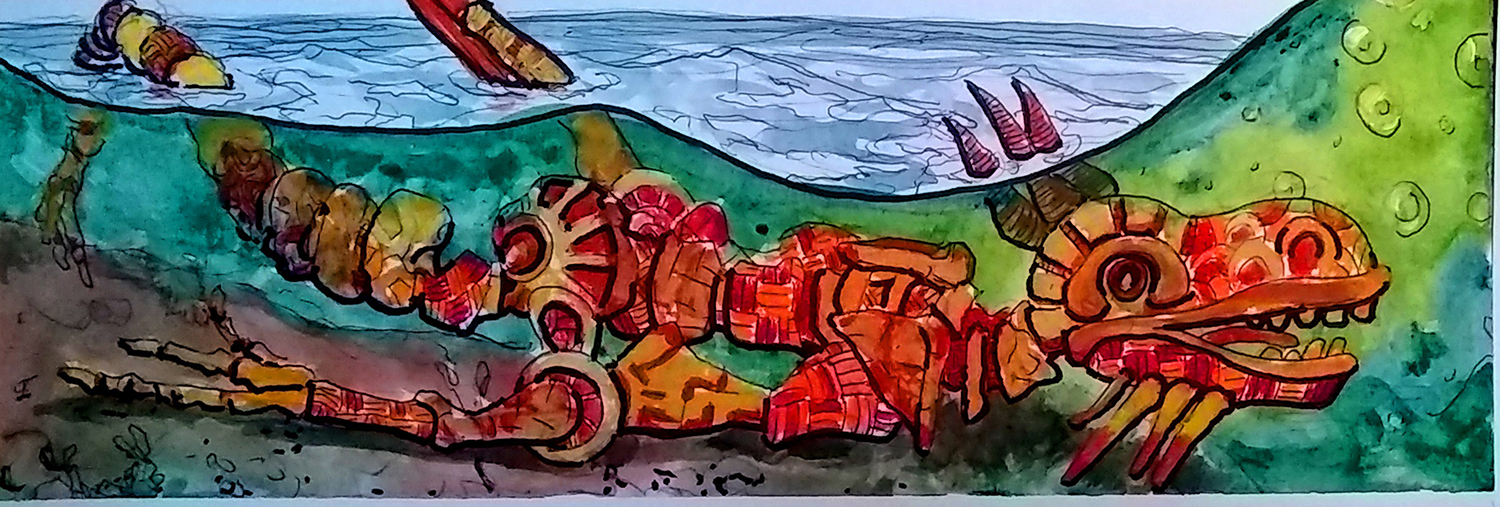
Inspiration for this installation
What is this strange creature you see before you? In Jason’s words “It is something submerged, to reference the rich marine life of our coastal waters, but also fantastical.” The intense colors and details offer a dynamic and complicated response to the question the Grey Fox seems to pose. The shades and forms flow from the soft green bubbles at the edge of the two murals’ boundary, then sharpen and resolve as the viewer is drawn into the depths of Sub Rosa’s stylized realm. Design elements for the creature’s face and head reference stone carvings and mural fragment’s found in the ancient Mezoamerican city of Teotihuacan, famed for their bold contrasts and powerful structural elements. Upon this foundation, Jason layers rainbow fins, textured body segments, and marionette-like limbs, to create a whimsical mash-up with a personality all its own. Jason Godeke is the art teacher at Fort Bragg Middle school. He is available for more mural projects. His dream is to design and install a large local mural with his students. Donate to the middle school art program.
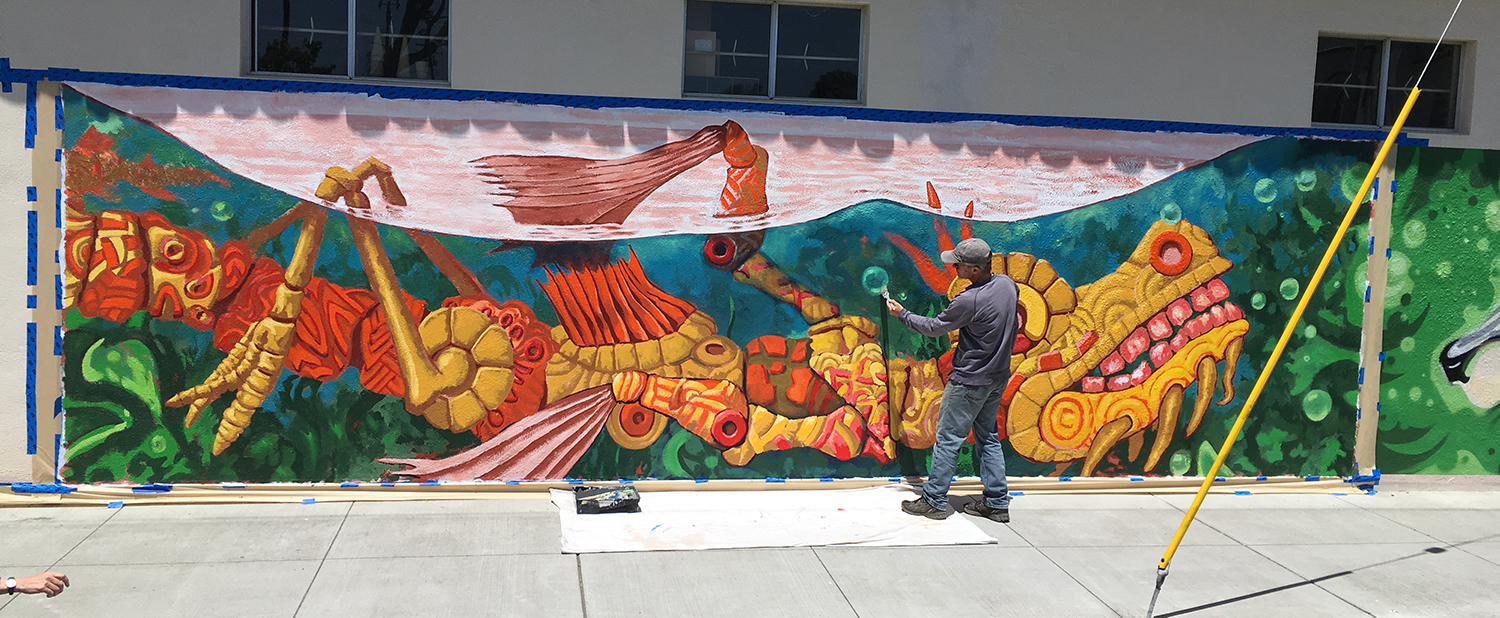
FUN FACT
Sub Rosa literally means “under the rose” in New Latin. Since ancient times, the rose has often been associated with secrecy. In ancient mythology, Cupid gave a rose to Harpocrates, the god of silence, to keep him from telling about the indiscretions of Venus. Ceilings of dining rooms have been decorated with carvings of roses, reportedly to remind guests that what was said at the table should be kept confidential. Roses have also been placed over confessionals as a symbol of the confidentiality of confession. Sub rosa entered the English language in the 17th century, and even before then, people were using the English version, “under the rose.” Earlier still, unter der Rose was apparently used in Germany, where the phrase is thought to have originated.




